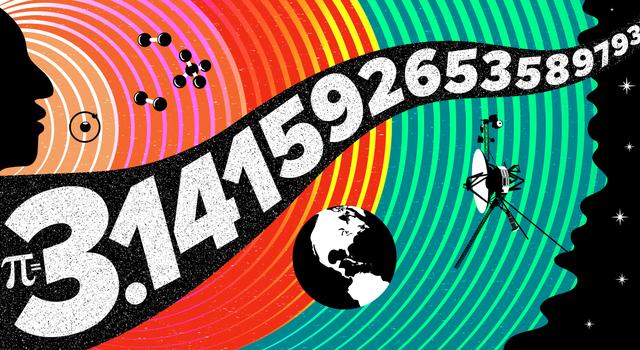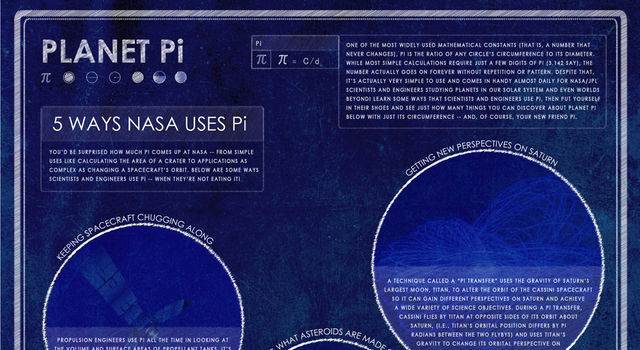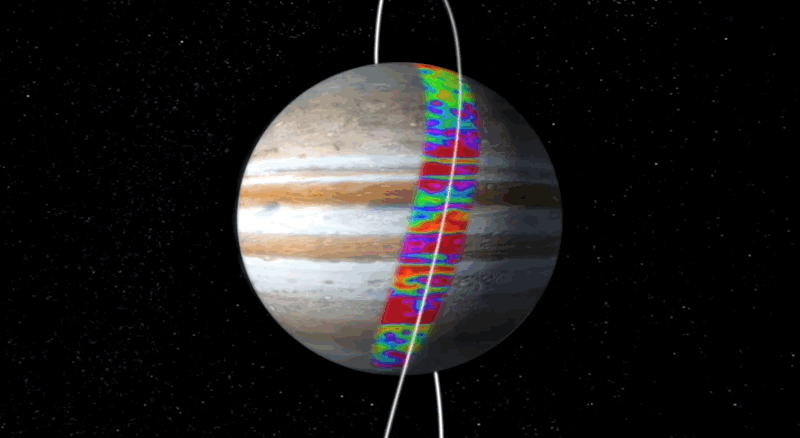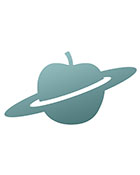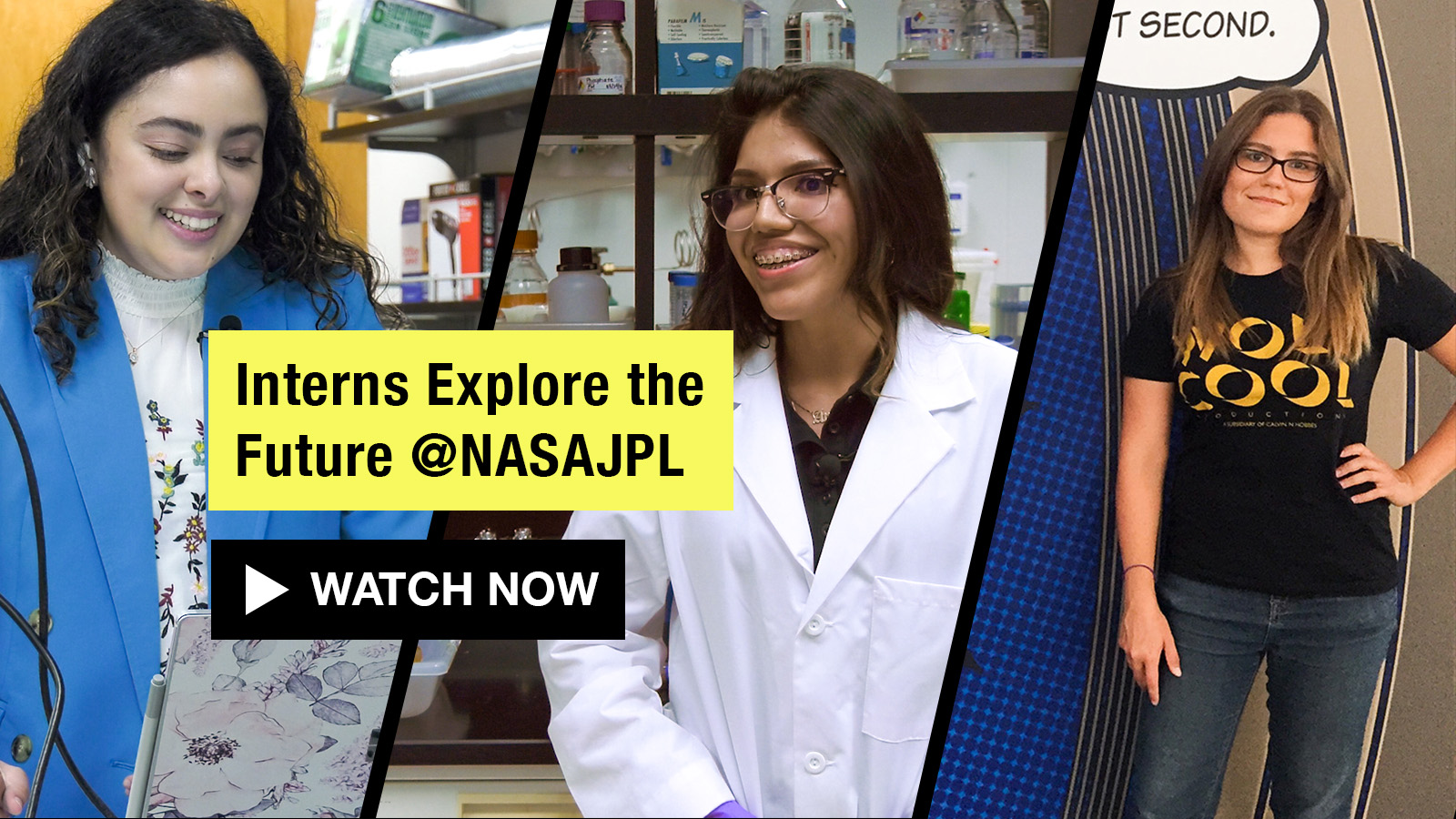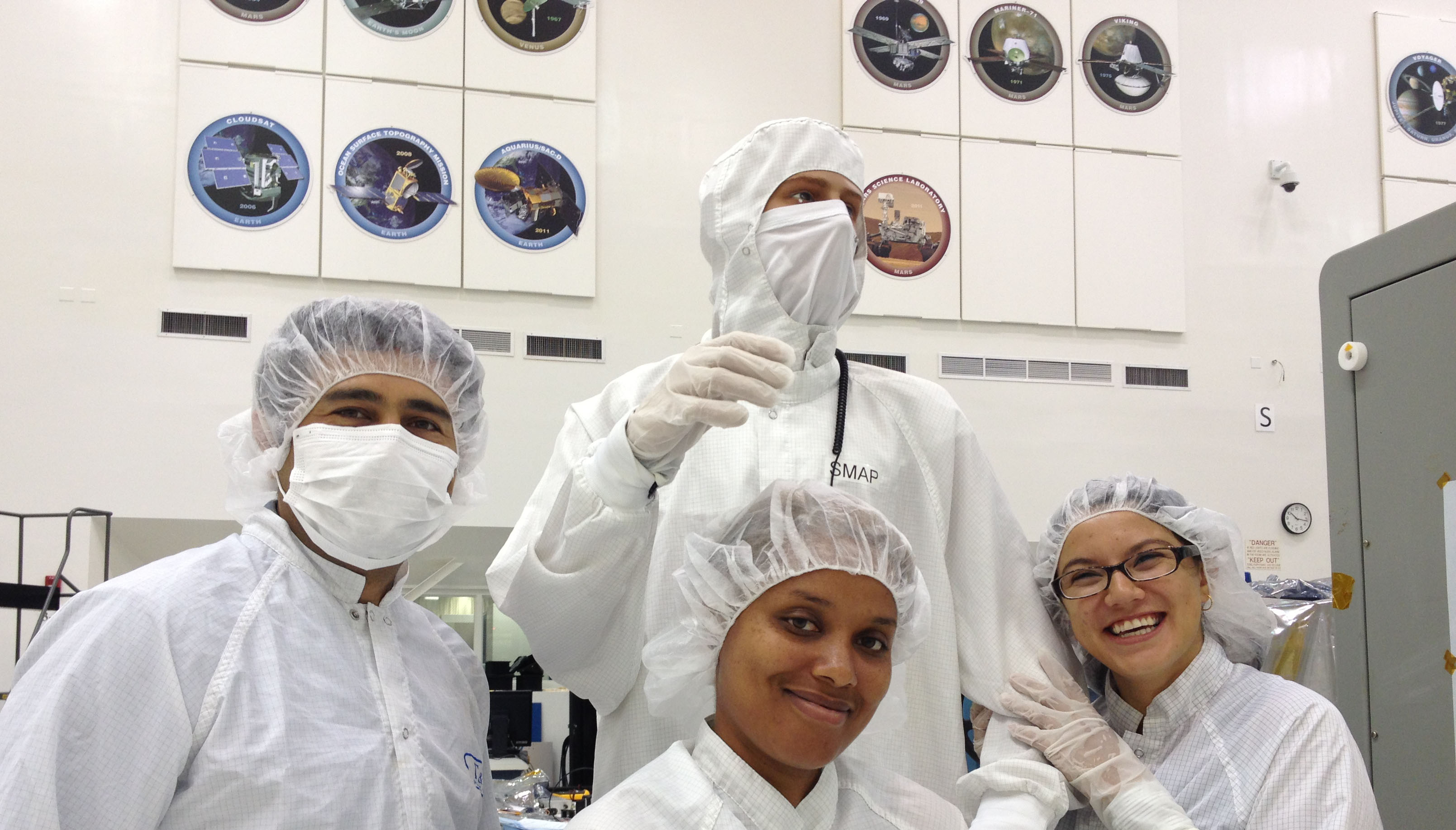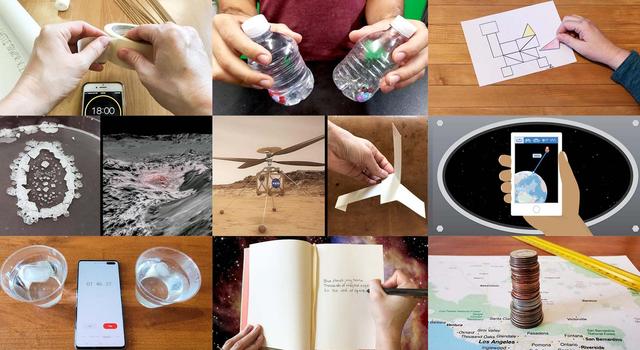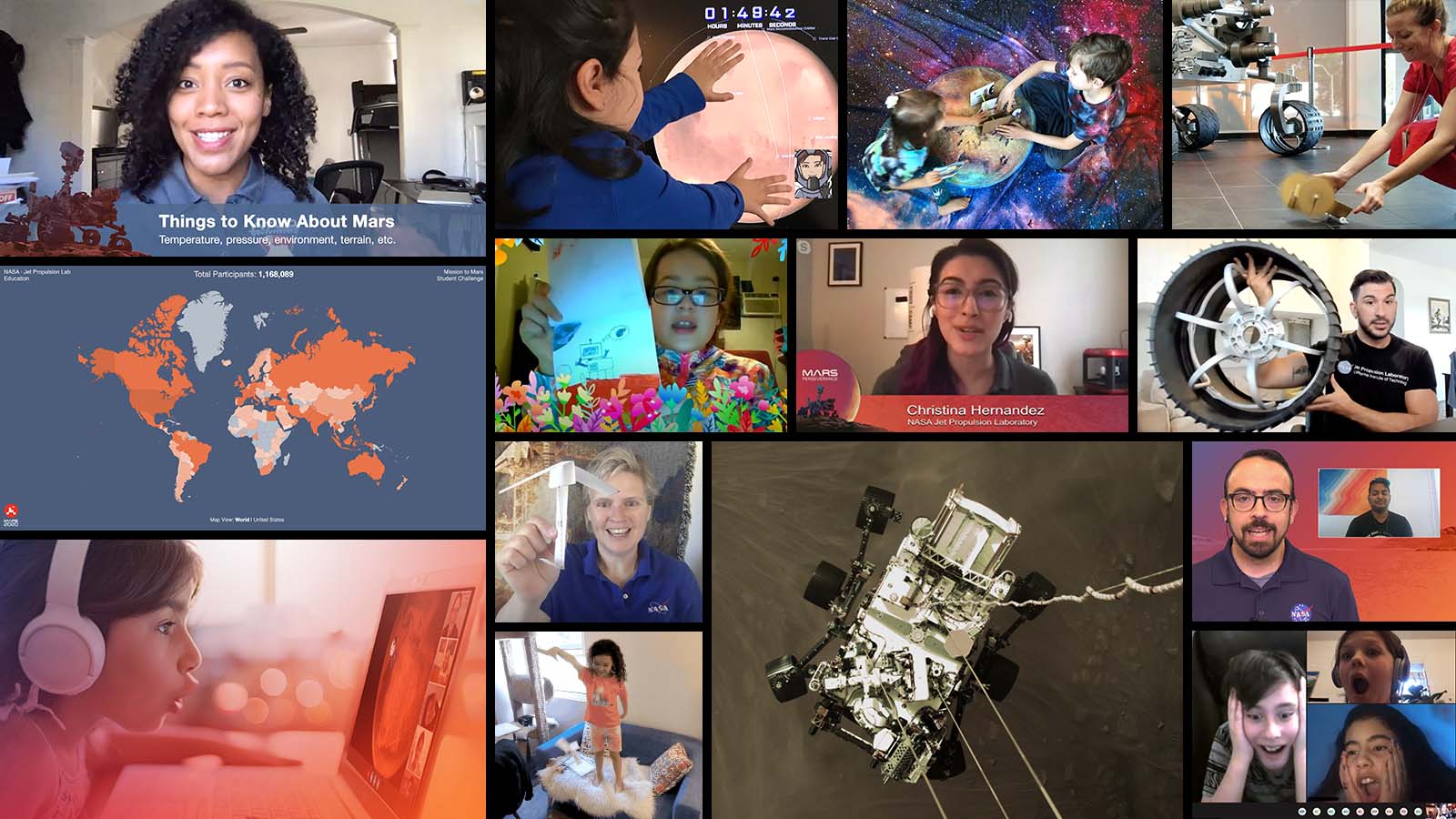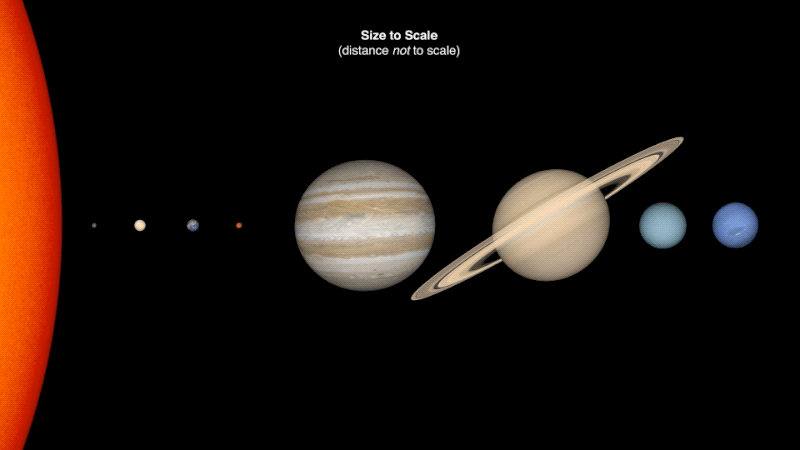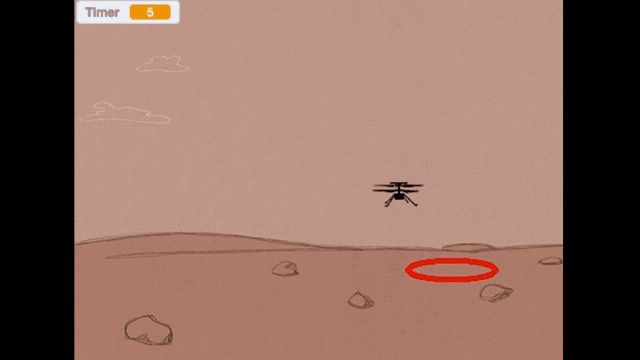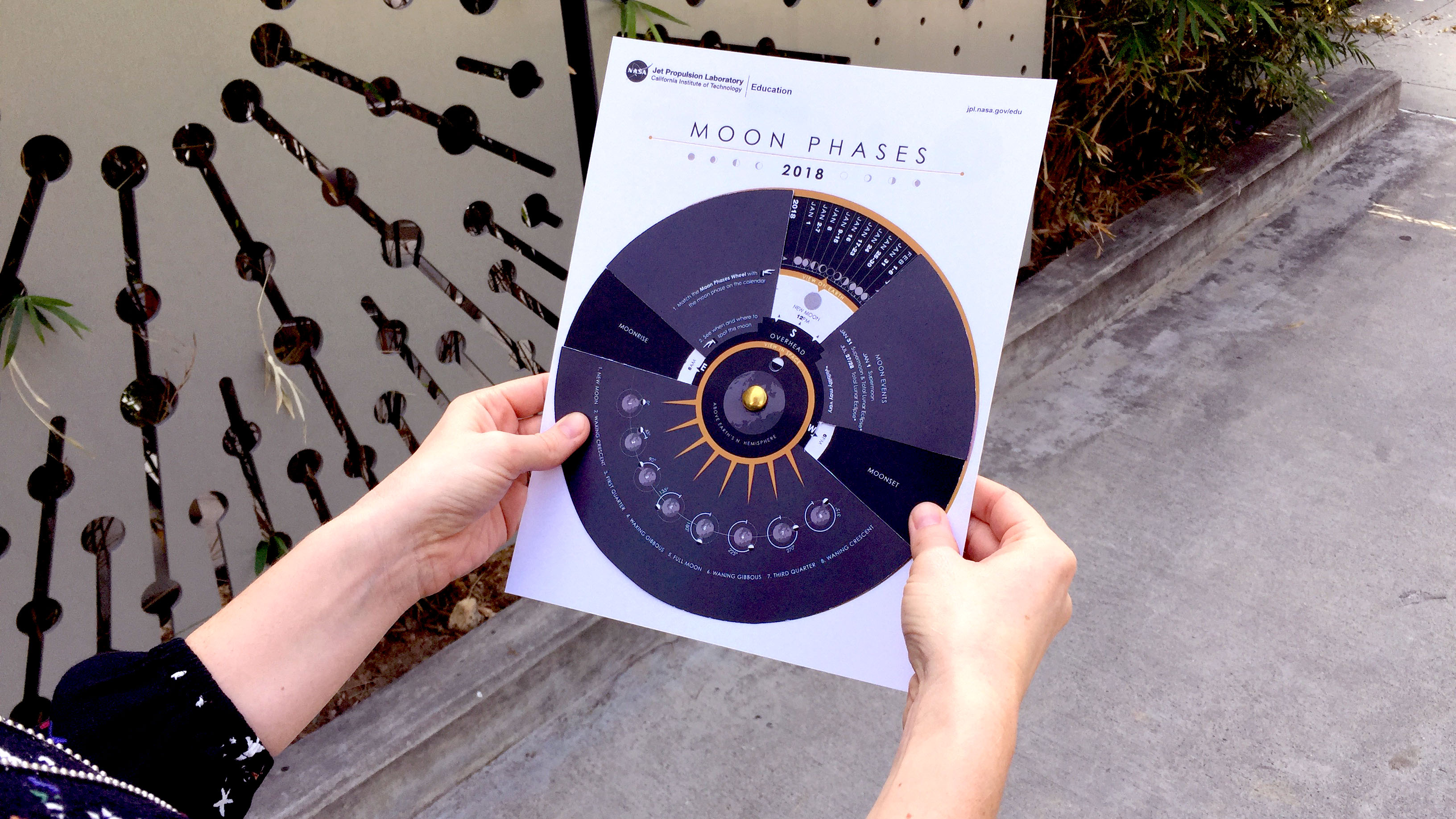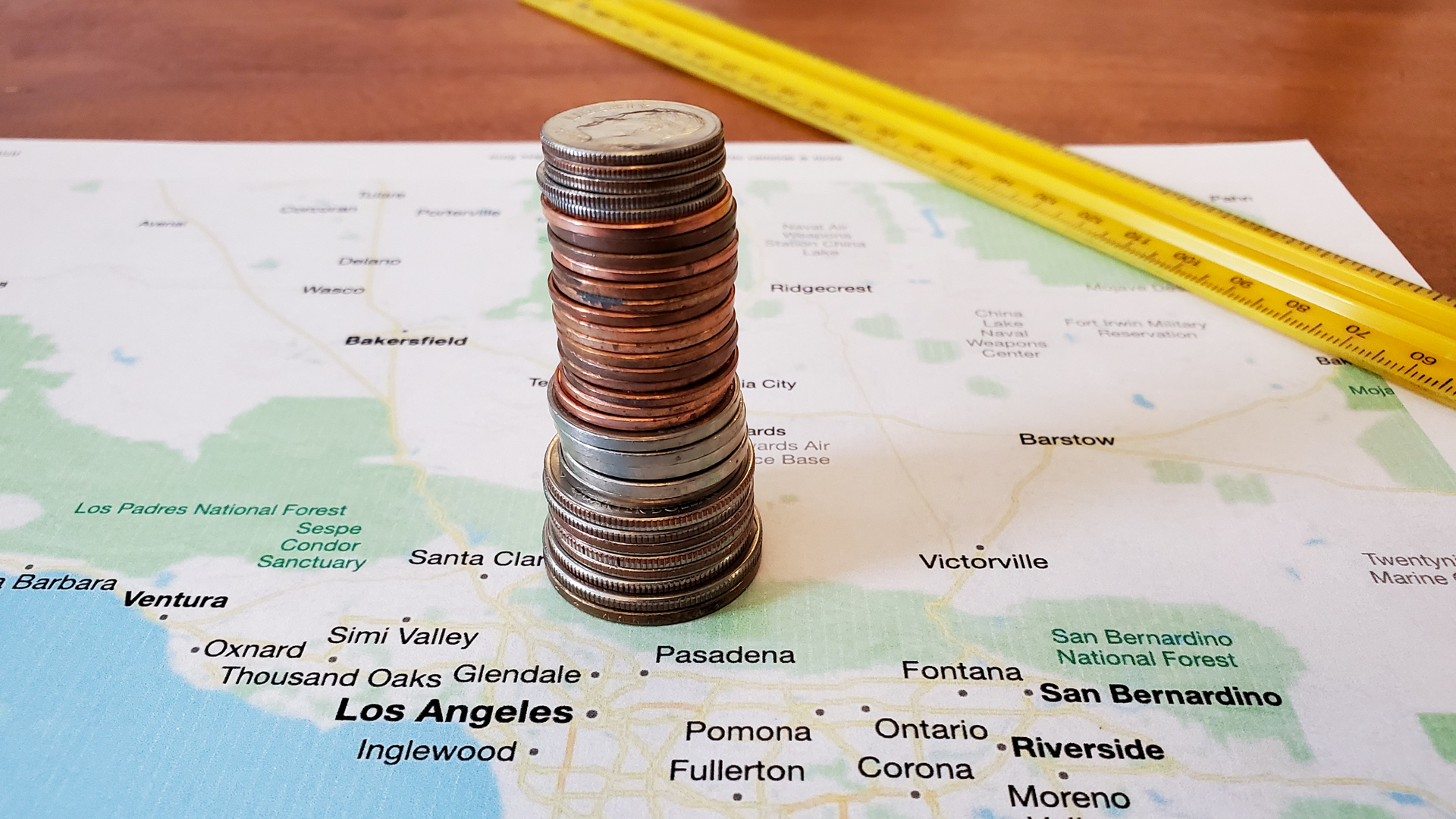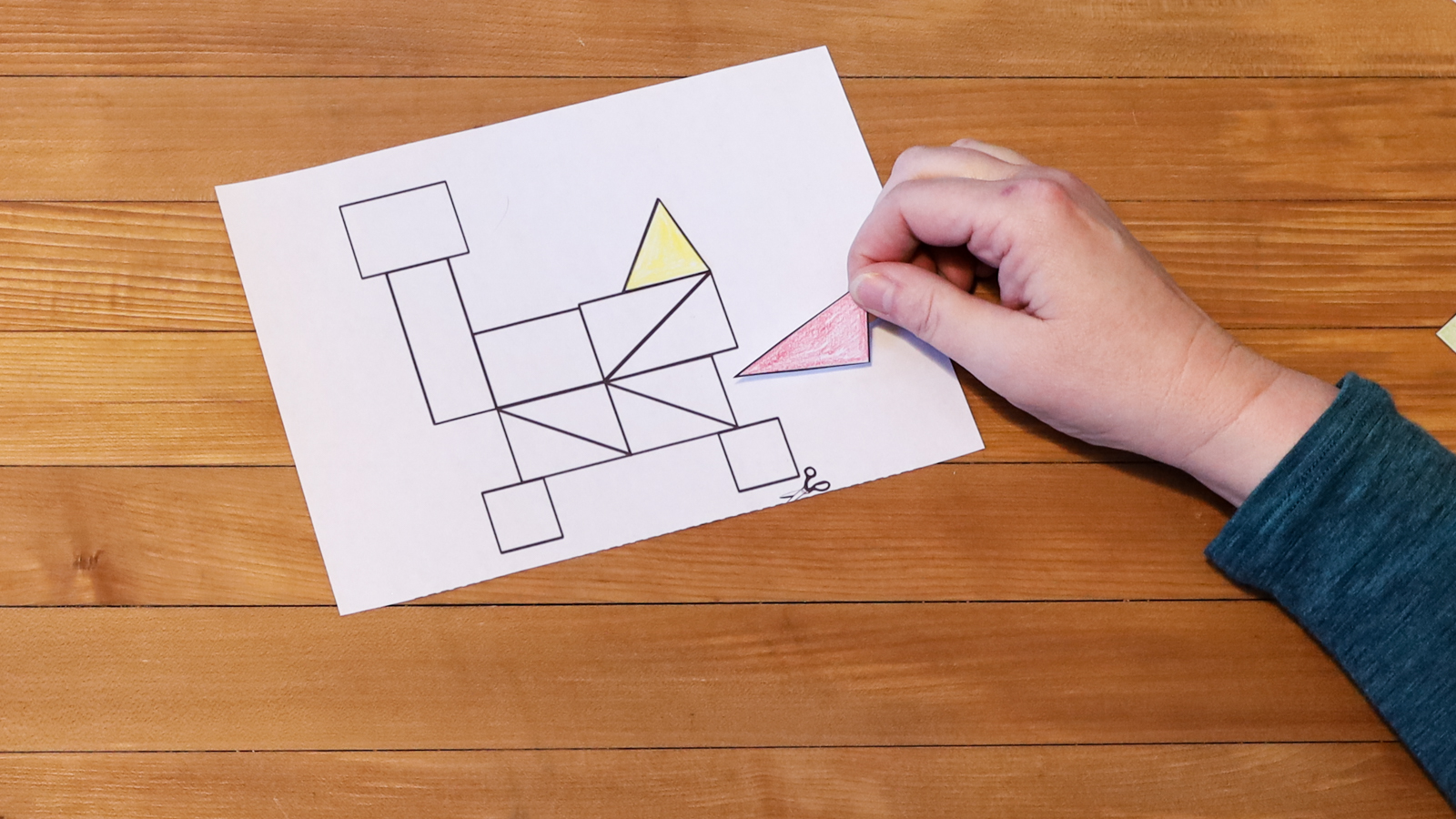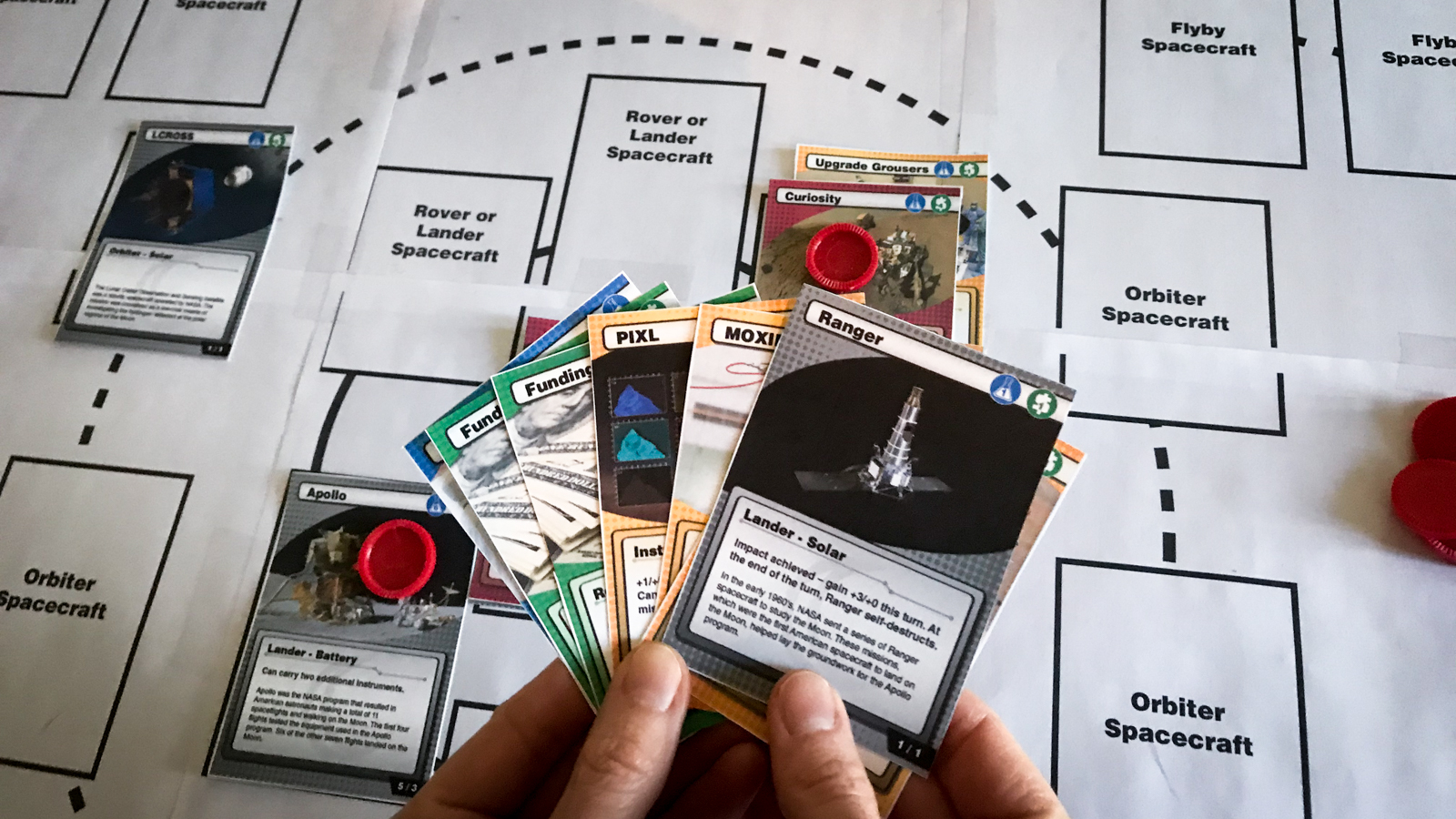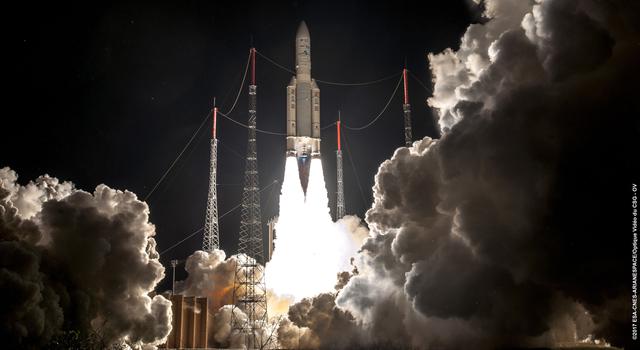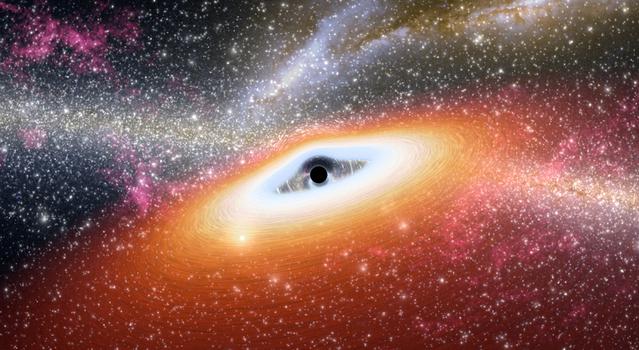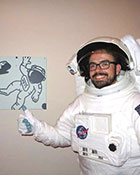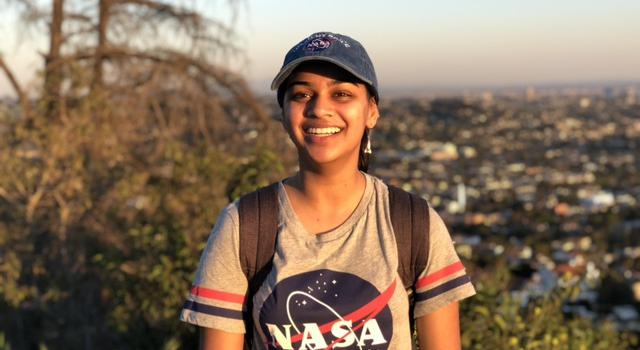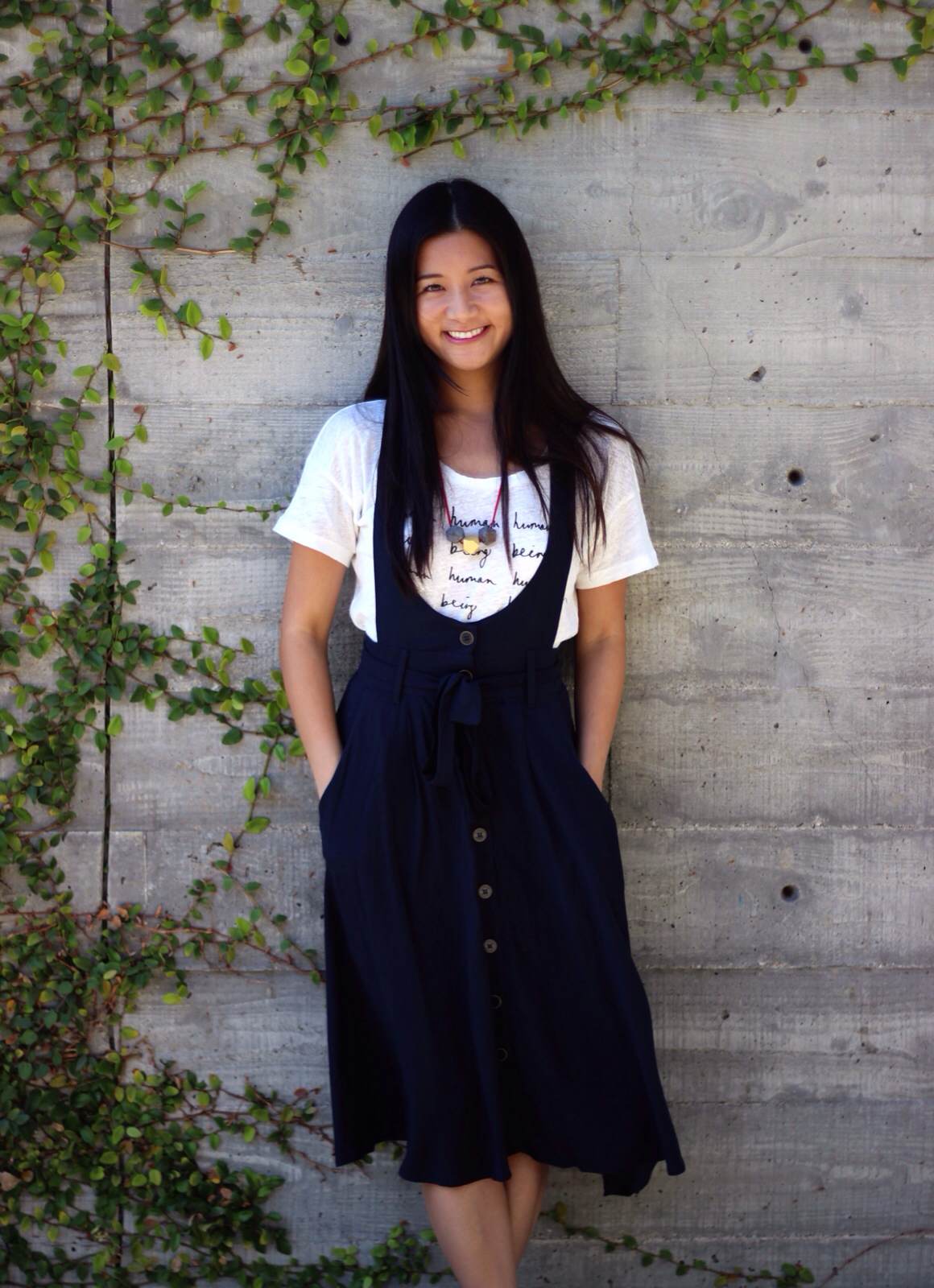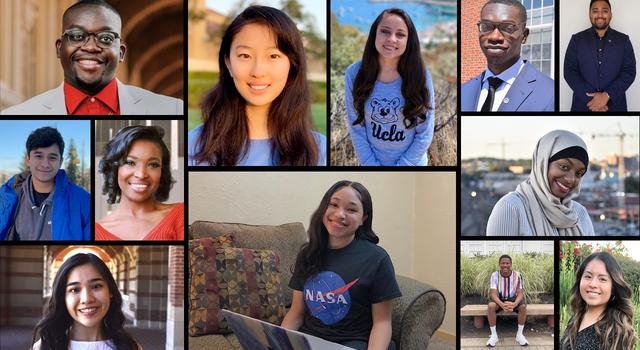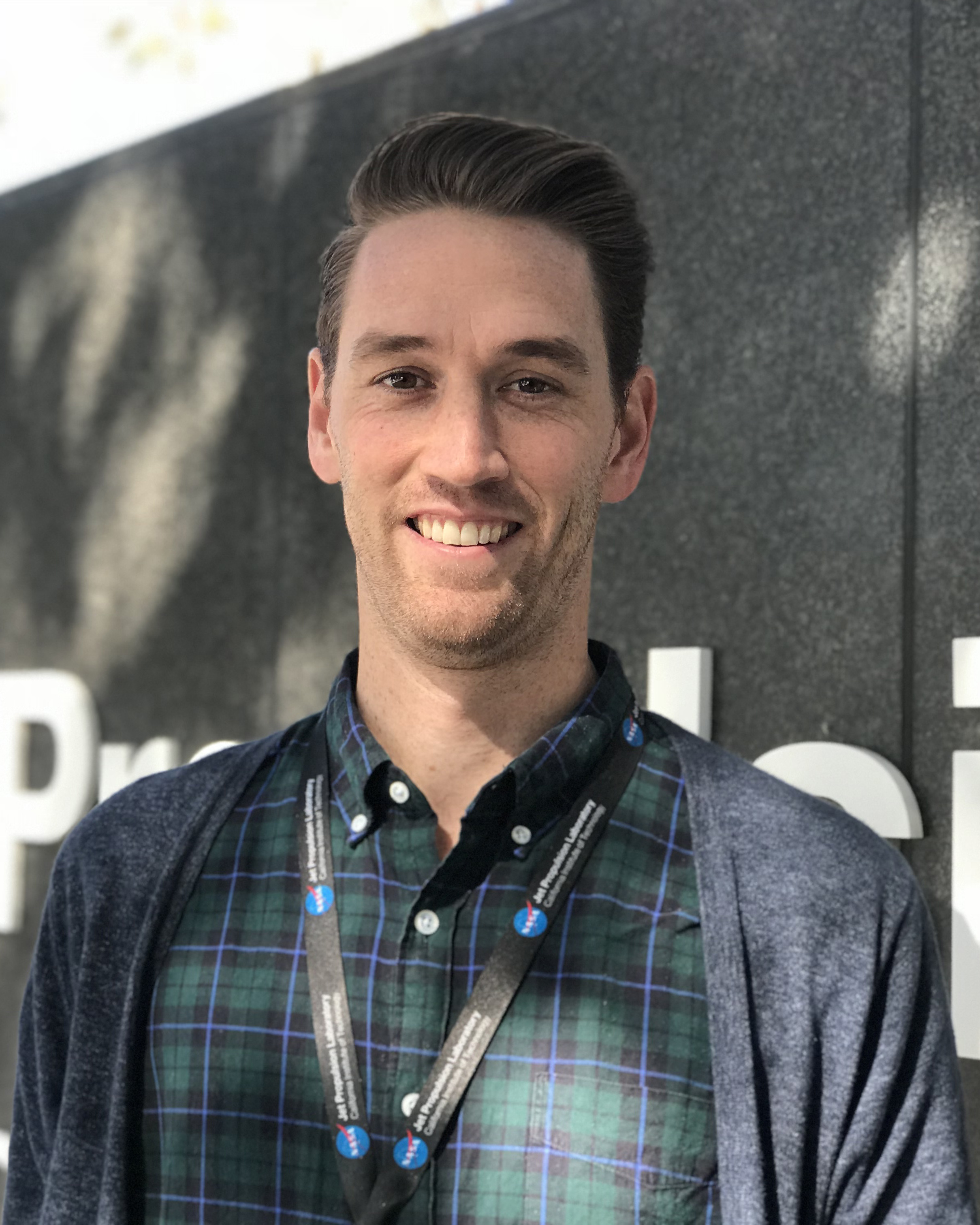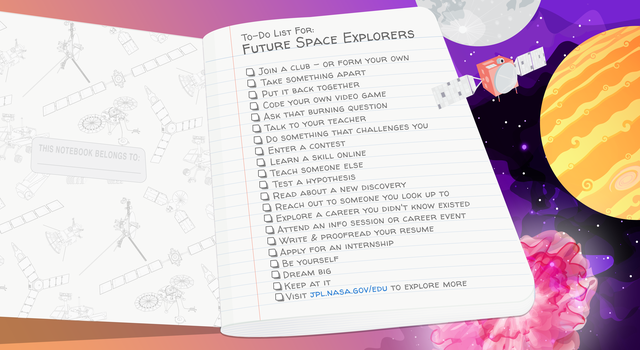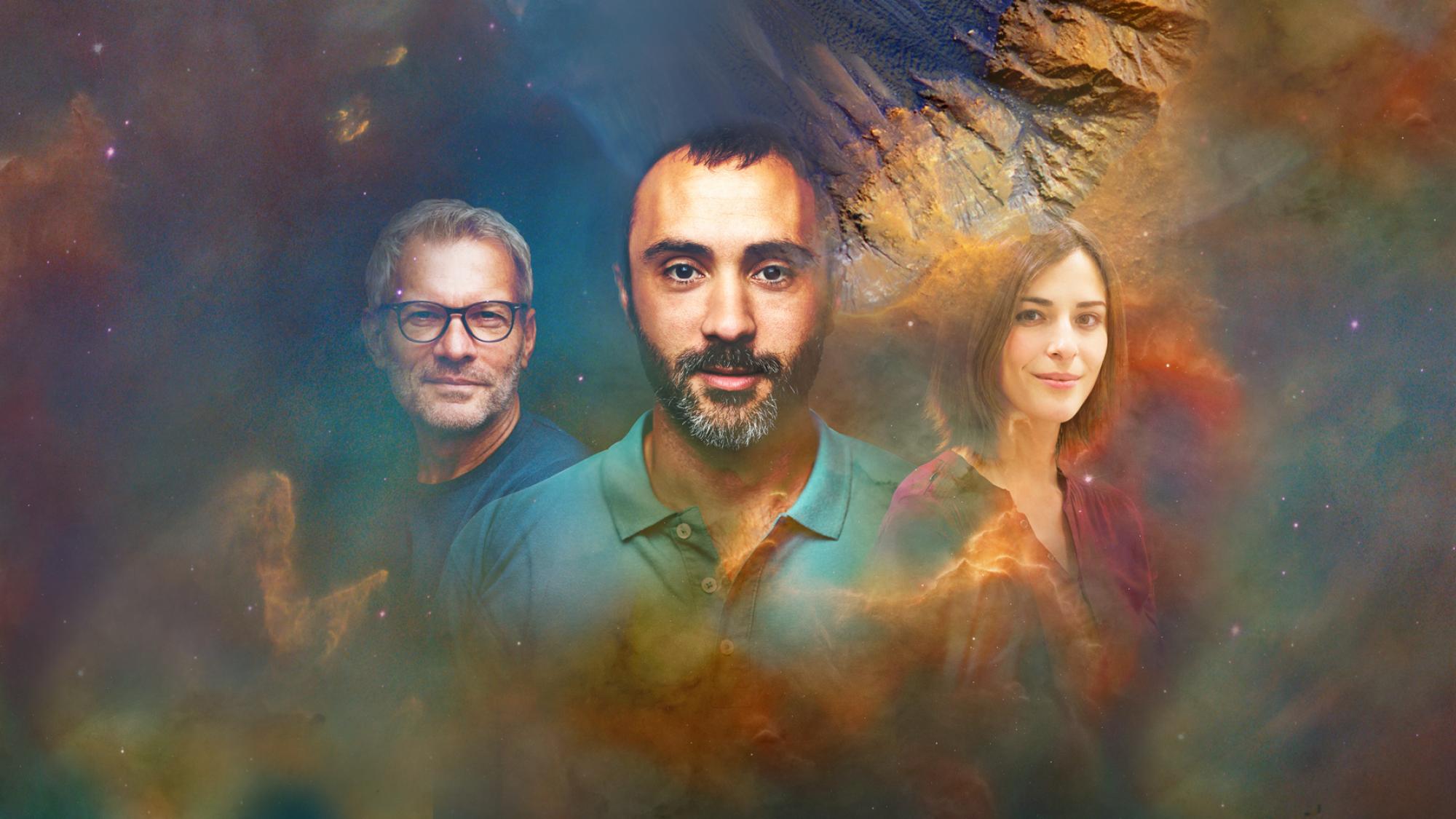Edu News | October 24, 2022
How Many Decimals of Pi Do We Really Need?
While world record holders may have memorized more than 70,000 digits of pi, a JPL engineer explains why you really only need a tiny fraction of that for most calculations – even at NASA.
Update: October 24, 2022 – This article, originally written in 2016, has been updated to reflect the latest values for NASA’s Voyager 1 spacecraft, which continues to venture farther into interstellar space. The author, Marc Rayman, has ventured on too, from the chief engineer for NASA’s Dawn mission, which concluded successfully in 2018, to the chief engineer for mission operations and science at NASA’s Jet Propulsion Laboratory.

This graphic shows more than 500 of the infinite number of decimals in pi. Image credit: NASA/JPL-Caltech | + Expand image
We received this question from a fan on Facebook who wondered how many decimals of the never-ending mathematical constant pi (π) NASA-JPL scientists and engineers use when making calculations:
“Does JPL only use 3.14 for its pi calculations? Or do you use more decimals, like say [360 or even more]?”
Here’s JPL’s Chief Engineer for Mission Operations and Science, Marc Rayman, with the answer:
Thank you for your question! This isn't the first time I've heard a question like this. In fact, it was posed many years ago by a sixth-grade science and space enthusiast who was later fortunate enough to earn a doctorate in physics and become involved in space exploration. His name was Marc Rayman.
To start, let me answer your question directly. For JPL's highest accuracy calculations, which are for interplanetary navigation, we use 3.141592653589793. Let's look at this a little more closely to understand why we don't use more decimal places. I think we can even see that there are no physically realistic calculations scientists ever perform for which it is necessary to include nearly as many decimal points as you asked about. Consider these examples:
- The most distant spacecraft from Earth is Voyager 1. As of this writing, it’s about 14.7 billion miles (23.6 billion kilometers) away. Let’s be generous and call that 15 billion miles (24 billion kilometers). Now say we have a circle with a radius of exactly that size, 30 billion miles (48 billion kilometers) in diameter, and we want to calculate the circumference, which is pi times the radius times 2. Using pi rounded to the 15th decimal, as I gave above, that comes out to a little more than 94 billion miles (more than 150 billion kilometers). We don't need to be concerned here with exactly what the value is (you can multiply it out if you like) but rather what the error in the value is by not using more digits of pi. In other words, by cutting pi off at the 15th decimal point, we would calculate a circumference for that circle that is very slightly off. It turns out that our calculated circumference of the 30-billion-mile (48-billion-kilometer) diameter circle would be wrong by less than half an inch (about one centimeter). Think about that. We have a circle more than 94 billion miles (more than 150 billion kilometers) around, and our calculation of that distance would be off by no more than the width of your little finger.
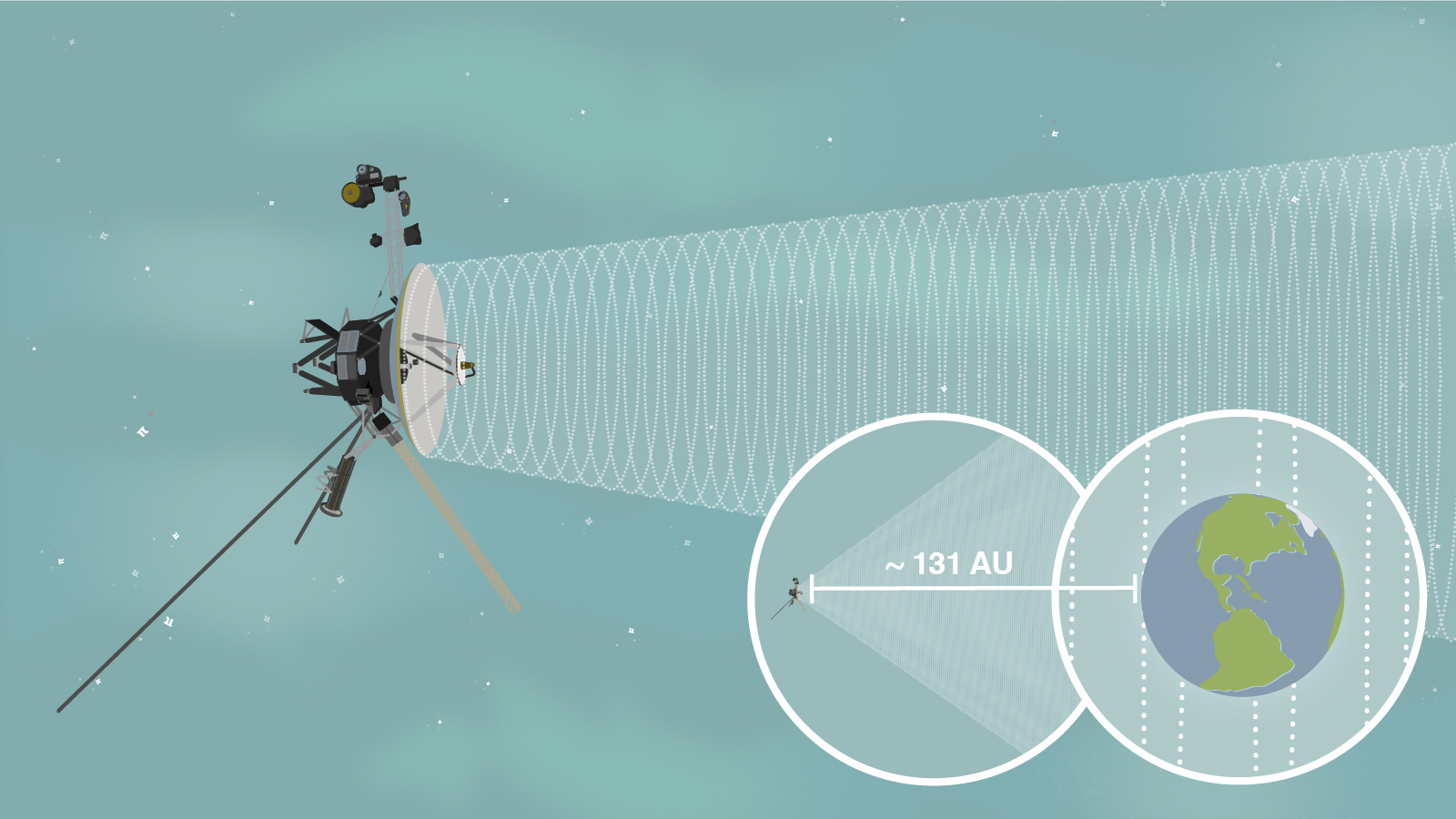
Put your pi math skills to the test with this problem from NASA's Pi Day Challenge. Can you use pi to determine what fraction of a signal from Voyager 1 reaches Earth? Image credit: NASA/JPL-Caltech | + Expand image | › View lesson page
- We can bring this closer to home by looking at our planet, Earth. It is more than 7,900 miles (12,700 kilometers) in diameter at the equator. The circumference is roughly 24,900 miles (40,100 kilometers). That's how far you would travel if you circumnavigated the globe – and didn't worry about hills, valleys, and obstacles like buildings, ocean waves, etc. How far off would your odometer be if you used the limited version of pi above? The discrepancy would be the size of a molecule. There are many different kinds of molecules, of course, so they span a wide range of sizes, but I hope this gives you an idea. Another way to view this is that your error by not using more digits of pi would be more than 30,000 times thinner than a hair!

Image credit: NASA | + Expand image
- Let's go to the largest size there is: the known universe. The radius of the universe is about 46 billion light years. Now let me ask (and answer!) a different question: How many digits of pi would we need to calculate the circumference of a circle with a radius of 46 billion light years to an accuracy equal to the diameter of a hydrogen atom, the simplest atom? It turns out that 37 decimal places (38 digits, including the number 3 to the left of the decimal point) would be quite sufficient. Think about how fantastically vast the universe is. It’s certainly far beyond what you can see with your eyes even on the darkest, most beautiful night of sparkling stars. It’s yet farther beyond the extraordinary vision of the James Webb Space Telescope. And the vastness of the universe is truly far, far, far beyond what we can even conceive. Now think about how incredibly tiny a single atom is. Isn’t it amazing that we wouldn’t need to use many digits of pi at all to cover that entire unbelievable range?
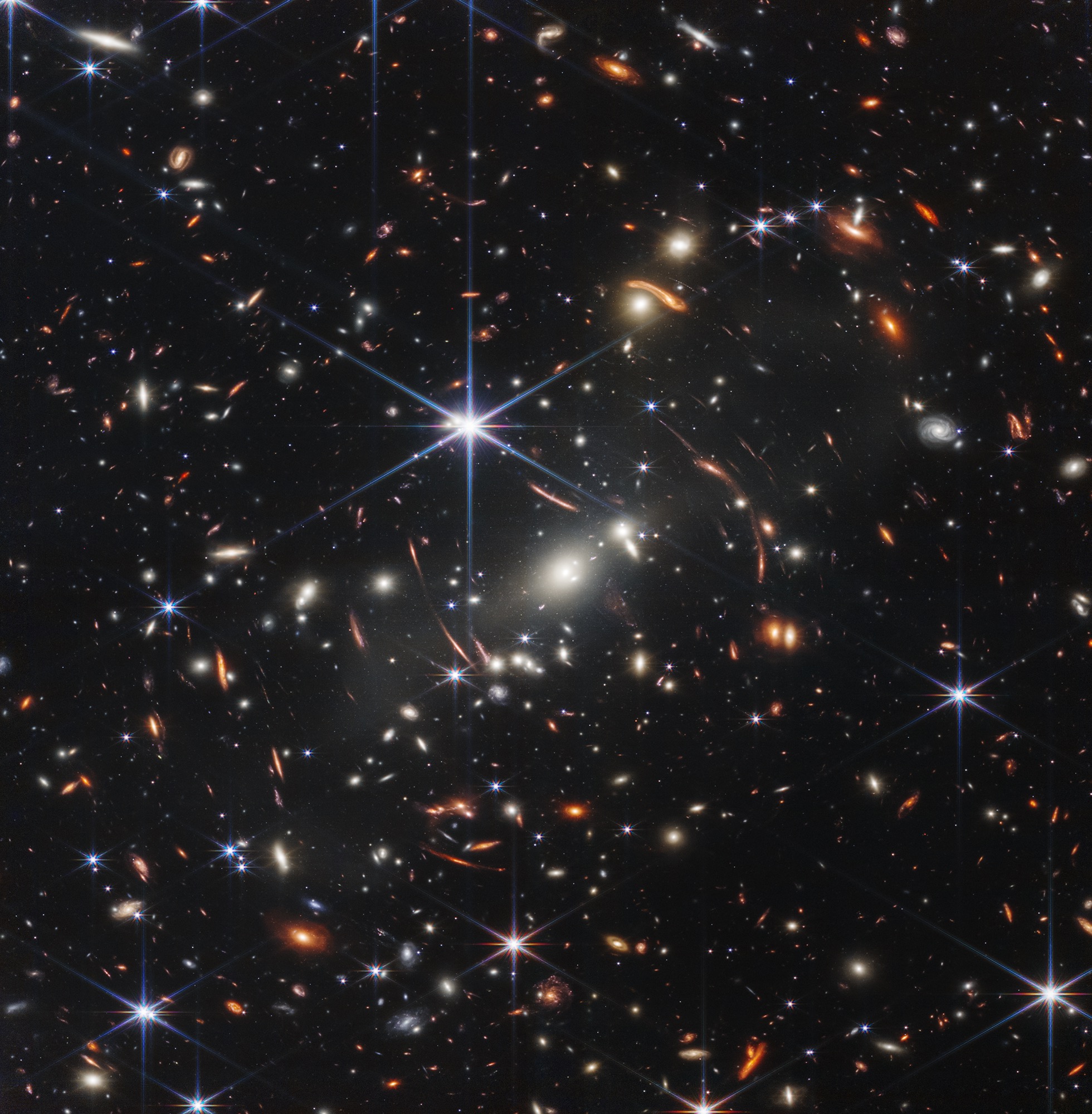
If you were to hold a single grain of sand at arm's length, you could cover the entire area of space taken up by this image, which was captured by the James Webb Space Telescope and contains thousands of galaxies. The oldest-known galaxy identified in the image is 13.1 billion years old. Image credit: NASA, ESA, CSA, STScI | + Expand image | › More about the image | Text description (PDF)
Pi is an intriguing number with interesting mathematical properties. It’s fun to think about its truly endless sequence of digits, and it may be surprising how often it appears in the equations scientists and engineers use. But there are no questions – prosaic or esoteric – in humankind’s noble efforts to explore or comprehend the marvels of the cosmos, from the unimaginably smallest scales to the inconceivably largest, that could require very many of those digits.
Hear more from Marc in his inspiring TEDx talk, “If It Isn’t Impossible, It Isn’t Worth Trying” and in his Dawn Journal, where he wrote frequent updates about the Dawn mission’s extraordinary extraterrestrial expedition to the protoplanet Vesta and dwarf planet Ceres.
Explore More
Educator Resources
-
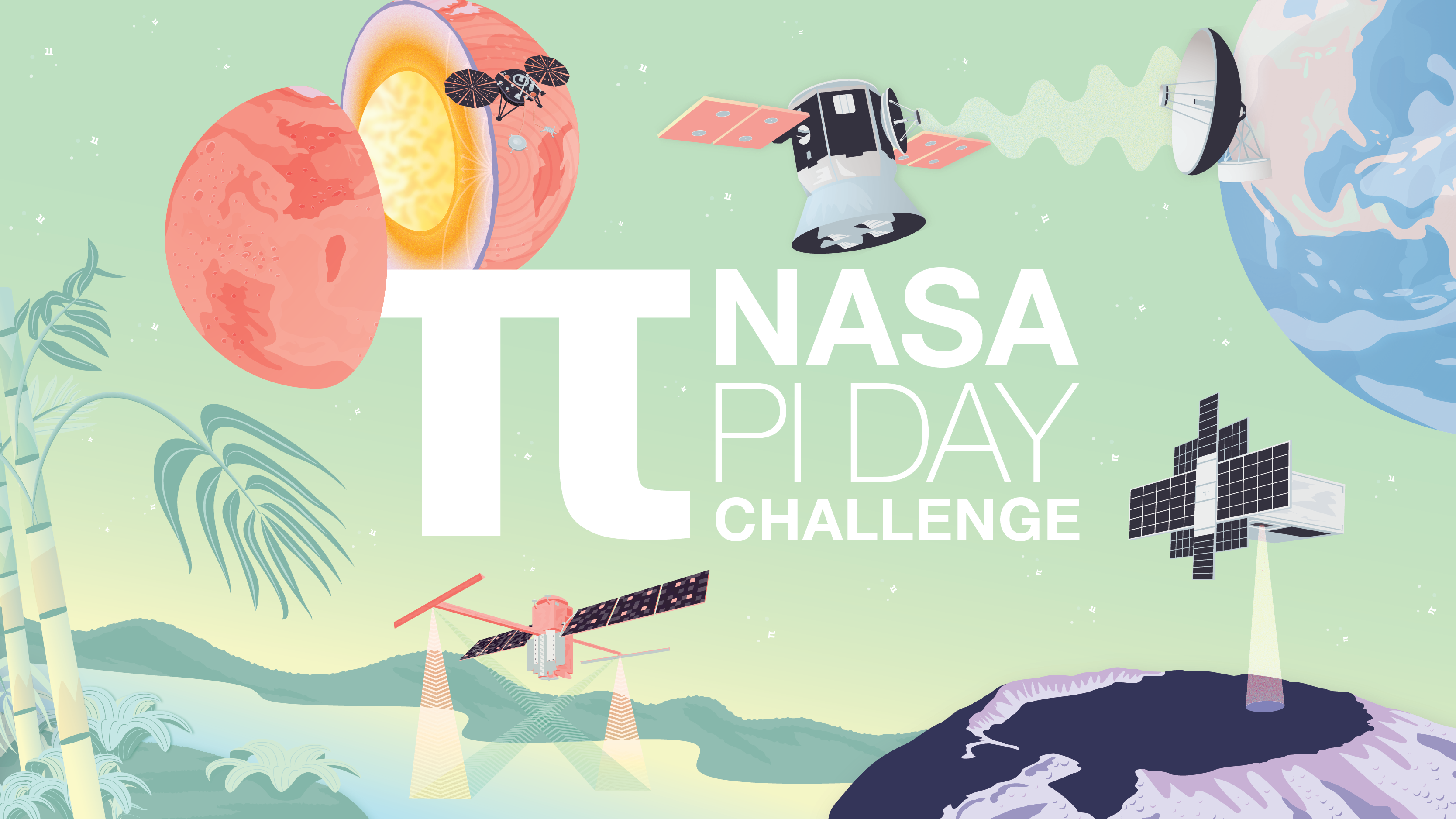
NASA Pi Day Challenge
This collection of illustrated math problems gets students using pi like NASA scientists and engineers exploring Earth and space.
Grades 4-12
Time Varies
-
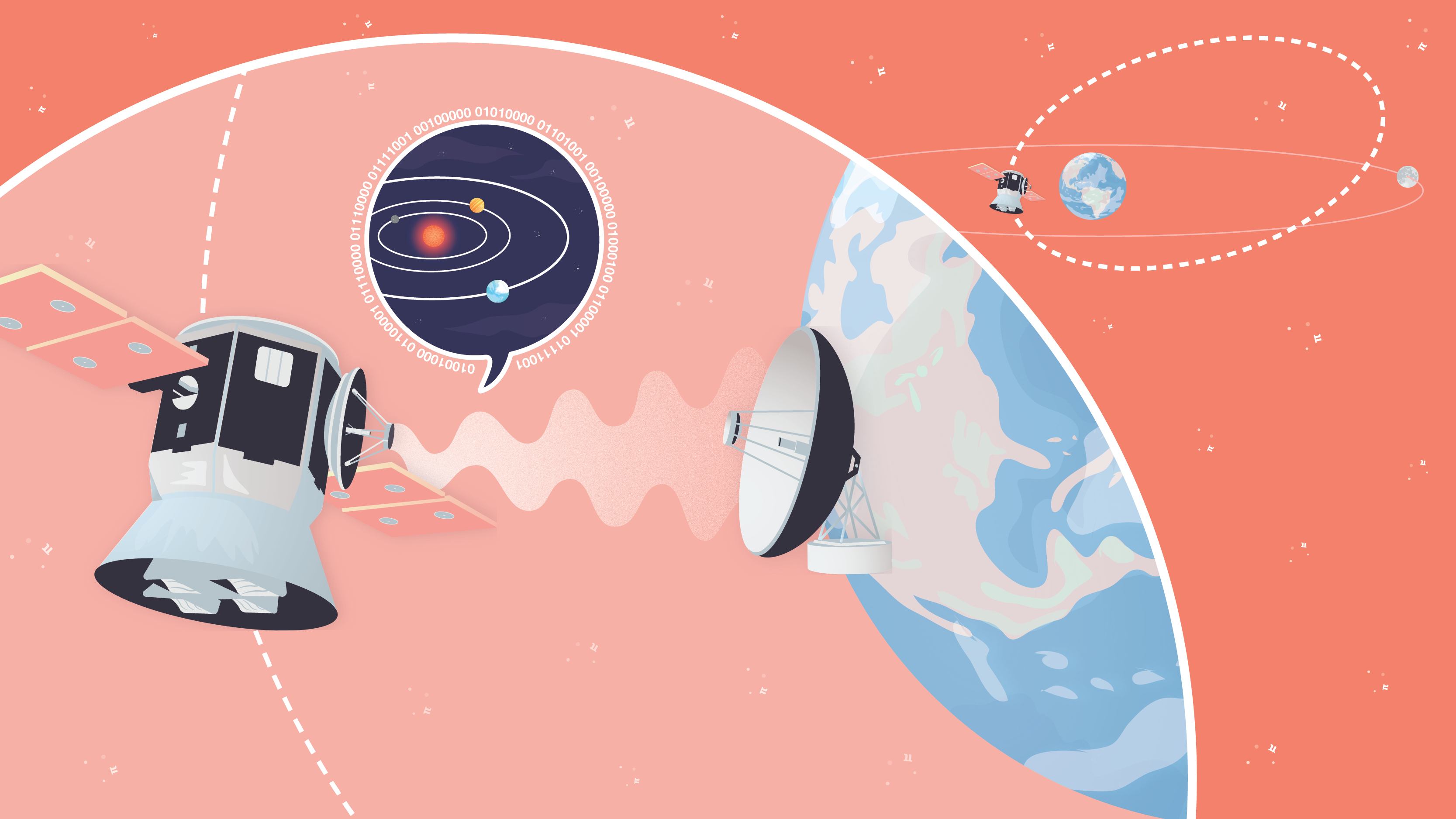
Pi in the Sky Lessons
Find everything you need to bring the NASA Pi Day Challenge into the classroom, including printable handouts of each illustrated math problem.
Grades 4-12
Time Varies
Articles
-
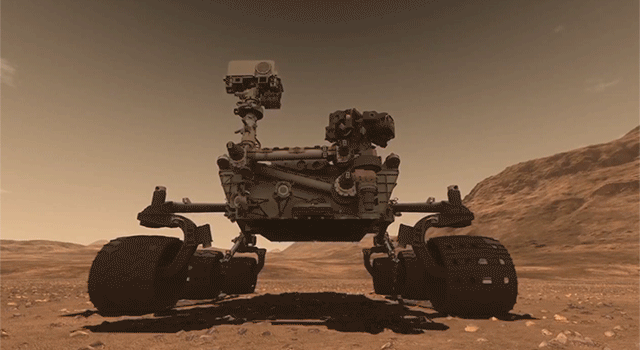
18 Ways NASA Uses Pi
Whether it's sending spacecraft to other planets, driving rovers on Mars, finding out what planets are made of or how deep alien oceans are, pi takes us far at NASA. Find out how pi helps us explore space.
-
10 Ways to Celebrate Pi Day With NASA on March 14
Find out what makes pi so special, how it’s used to explore space, and how you can join the celebration with resources from NASA.
Multimedia & Downloads
Recursos en español
TAGS: Pi, Pi Day, Dawn, Voyager, Engineering, Science, Mathematics
Meet JPL Interns | July 28, 2022
Interns Explore the Future at NASA-JPL
We talked to a few JPL interns about what they've been working on, how they're taking NASA into the future, and what it all means to them.
Despite the challenges of the past two years, it’s been a busy time for NASA’s Jet Propulsion Laboratory. Among the Lab’s activities have been the launch and landing of a new Mars rover, preparations for sending a spacecraft to explore an ocean world beyond Earth, first light for missions studying our changing climate and the universe beyond, and the development of technology to help address the COVID pandemic.
All the while, JPL interns have continued supporting scientists, engineers, and technologists behind the scenes to make those missions and projects happen.
More than 600 summer interns are taking part in that crucial work – both in-person at the laboratory in Southern California as well as from their homes and dorms across the country. In May, JPL welcomed summer interns back on site for the first time since 2019 while continuing to offer remote internships as projects allow.
We wanted to hear what interns have been up to, how they're contributing to NASA missions and science, and what the experience has meant to them. So we caught up with three students who have helped see the lab through the last year or two – and in one case, seven years. Watch their stories in the video above.
Explore More
-
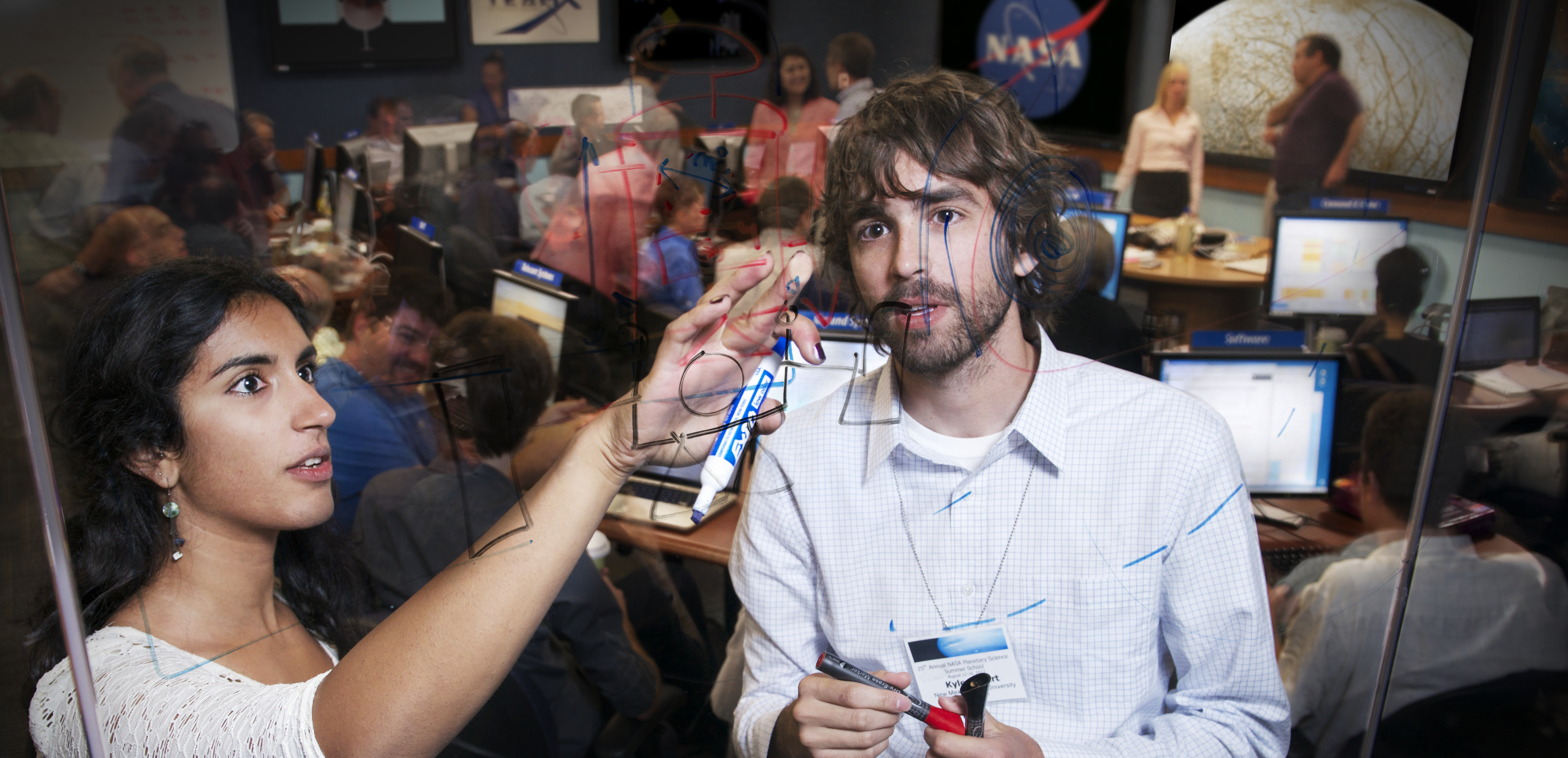
Apply Now
Discover exciting internships and research opportunities at the leading center for robotic exploration of the solar system.
-
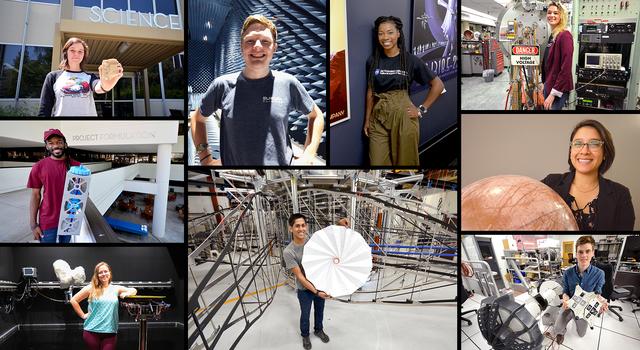
Article: How to Get an Internship at JPL
Here's everything you need to know about the world of JPL internships, the skills that will help you stand out, and how to get on the right trajectory even before college.
-
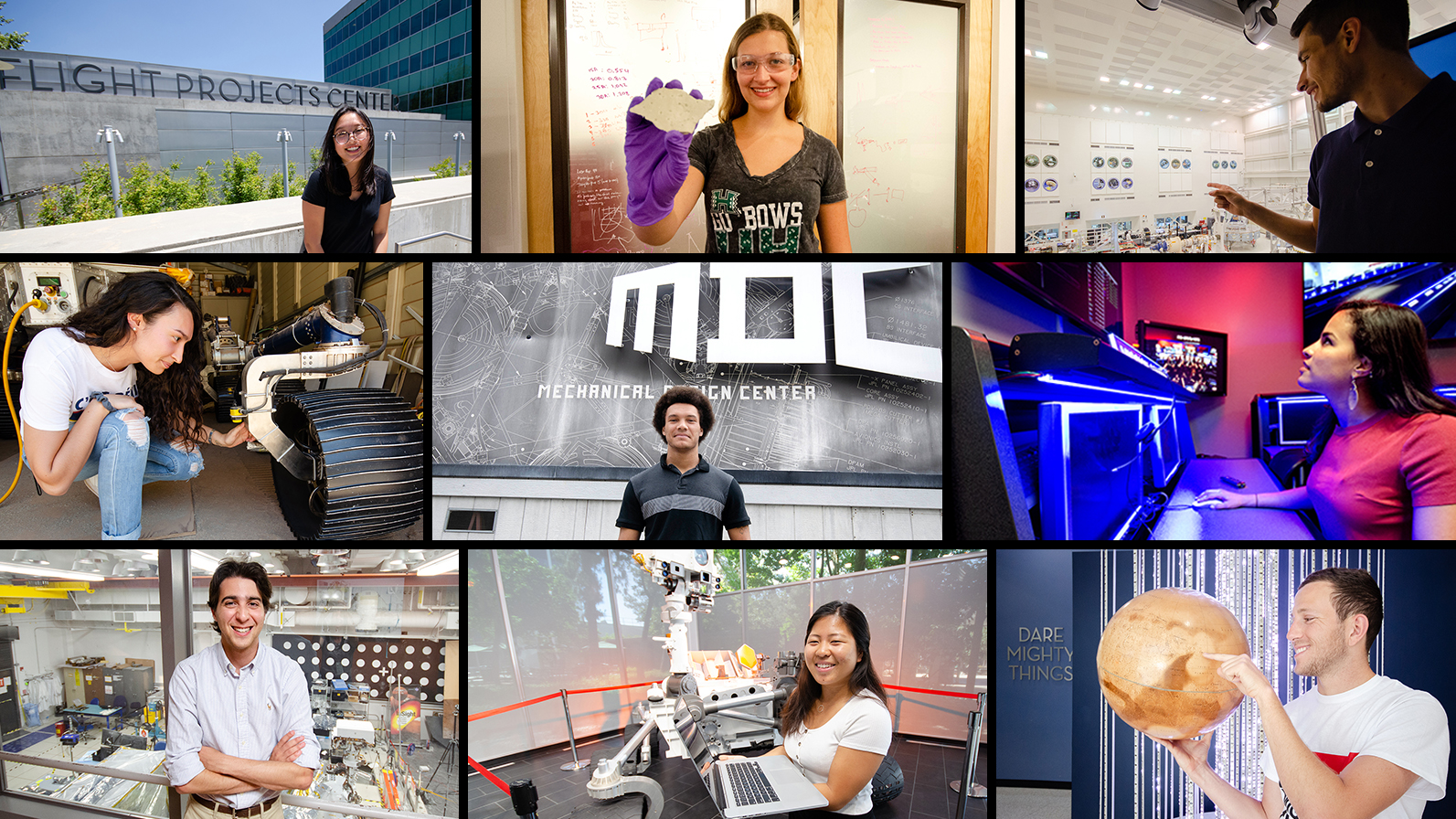 All Audiences
All AudiencesBlog: Meet JPL Interns
Hear stories from interns pushing the boundaries of space exploration and science at the leading center for robotic exploration of the solar system.
- Join the conversation and find out about the latest opportunities with @NASAJPL_Edu on Twitter, Facebook, and Instagram.
- JPL Lecture Series
- JPL Jobs
- JPL Newsletter
- JPL News
- People of NASA
- NASA Internships
- Careers at NASA
The laboratory’s STEM internship and fellowship programs are managed by the JPL Education Office. Extending the NASA Office of STEM Engagement’s reach, JPL Education seeks to create the next generation of scientists, engineers, technologists and space explorers by supporting educators and bringing the excitement of NASA missions and science to learners of all ages.
Career opportunities in STEM and beyond can be found online at jpl.jobs. Learn more about careers and life at JPL on LinkedIn and by following @nasajplcareers on Instagram.
TAGS: Interns, Internships, College Students, Science, Engineering, InSight, Mars, Europa, Ocean Worlds, Enceladus, Saturn, Cassini, Ceres
Meet JPL Interns | May 19, 2022
Interns Lead the Way in DARPA Robotics Challenge and Find Their Futures
To gain an edge in one of the world's premier robotics competitions, JPL brought in a team of experts at the forefront of their field – college students. The experience gave the interns and the Laboratory a new perspective on what's possible.
You know that movie trope where a talented mastermind recruits a ragtag team of experts to pull off a seemingly impossible task. That's what I imagine when Ali Agha talks about the more than 30 interns brought to NASA's Jet Propulsion Laboratory to take part in one of the world's premier robotics competitions.
In 2018, a group led by Agha was one of only 12 teams chosen worldwide to compete in the Defense Advanced Research Projects Agency, or DARPA, Subterranean Challenge, a three-year-long competition that concluded this past September and brought together some of the brightest minds in robotics. Their goal was to develop robotic systems for underground rescue missions, or as Agha puts it, "solutions that are so state-of-the-art, there's not even a clear definition of what you're creating."
Calling themselves Team CoSTAR, which stands for Collaborative SubTerranean Autonomous Resilient Robots, the group also included engineers from Caltech, Massachusetts Institute of Technology, Korea Advanced Institute of Science and Technology, Sweden’s Lulea University of Technology, and several industry partners.
Meet some of the researchers, engineers, and interns who make up Team CoSTAR. Credit: NASA/JPL-Caltech | Watch on YouTube
Interns from across the country and around the world came to JPL to help conceive of, build, and test CoSTAR – a coordinated rescue team of flying, crawling, and rolling robots designed to operate autonomously, or with little to no help from humans. But the interns didn't just come to the laboratory to learn from engineers already well versed in building robots to explore extreme environments. In many cases, the interns were the experts.
"The problem we needed to solve, nobody knew how to solve it, so we needed people who are at the cutting edge of these technologies," says Agha. "We needed to get that one person in the world or a few people in the world who work on that specific camera or sensor or data or specific algorithm to come and educate us."
And Agha knew exactly where to find them: colleges and universities.
The interns' contributions would end up reaching far beyond the challenge. And the entire experience – from the mentorship they received to the technology they developed to the friendships they built – would change the course of their careers.
The Visionary
Even the Perseverance Mars rover, the latest and greatest Red Planet explorer designed and built at JPL, requires a fair amount of direction from mission controllers back on Earth to navigate around hazards and know which rocks to zap with its laser or when to phone home.
Since coming to JPL in 2016, Agha had been researching ways to make planet-exploring robots more autonomous so they could make similar decisions on their own. He was especially interested in autonomous technology for underground environments like caves and volcanoes, where the terrain and visibility make remote guidance challenging.
So when DARPA announced that it was launching a competition aimed at the development of autonomous robots for subterranean rescue missions, Agha jumped at the opportunity.
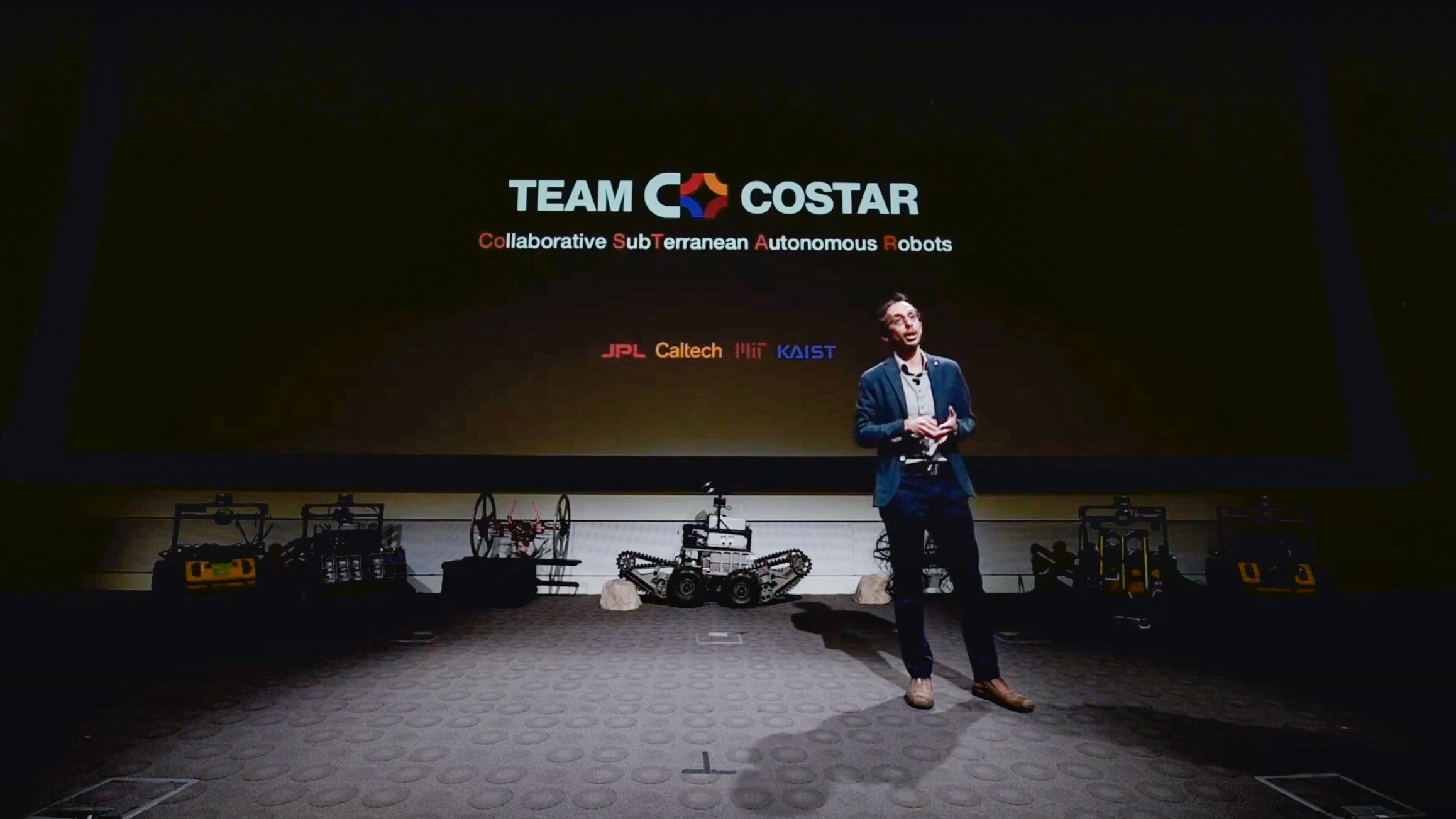
Agha gives a presentation at JPL about the technology developed for the DARPA challenge with CoSTAR's robot squad lined up behind him. | › Watch Agha's talk on YouTube | + Expand image
"It was a very good alignment and a great opportunity for JPL and for NASA," says Agha. "We knew if we can get into this program, it's going to expedite the technology development at a really high pace, and that's going to help NASA and JPL to develop these capabilities [for our own projects]."
But like developing robots for space exploration, the requirements would be tough.
Teams would need to build a robotic system that could autonomously navigate four circuits – a tunnel, an urban underground, a cave, and a combination of the three – in search of scientific "artifacts," or signs of human activity, hidden throughout the course. Then, in just 60 minutes, the robots would need to make their way through winding, cavernous, and dangerous terrain to correctly report the locations of as many artifacts as possible.
There were just 12 months between when proposals were selected and the first event in August 2019. Agha needed a plan – and a team.
The Strategist
Sung Kim first came to JPL as an intern in 2017, a year before the DARPA Subterranean Challenge was announced. A Carnegie Mellon doctoral student researching ways to help robots plan under uncertainty, Kim's childhood dream to work for NASA was rekindled when he saw an internship posting with Agha's team.
"From the first meeting, there was a spark," says Kim of his interview with Agha. "At the time, there were not many people actively pursuing that area [of planning under uncertainty]."
Kim spent that summer at JPL helping the team begin to develop what would later become the backbone of CoSTAR – a system in which robots can analyze their surroundings to find a route that covers as much ground as possible, increasing the odds that they will make discoveries along the way.
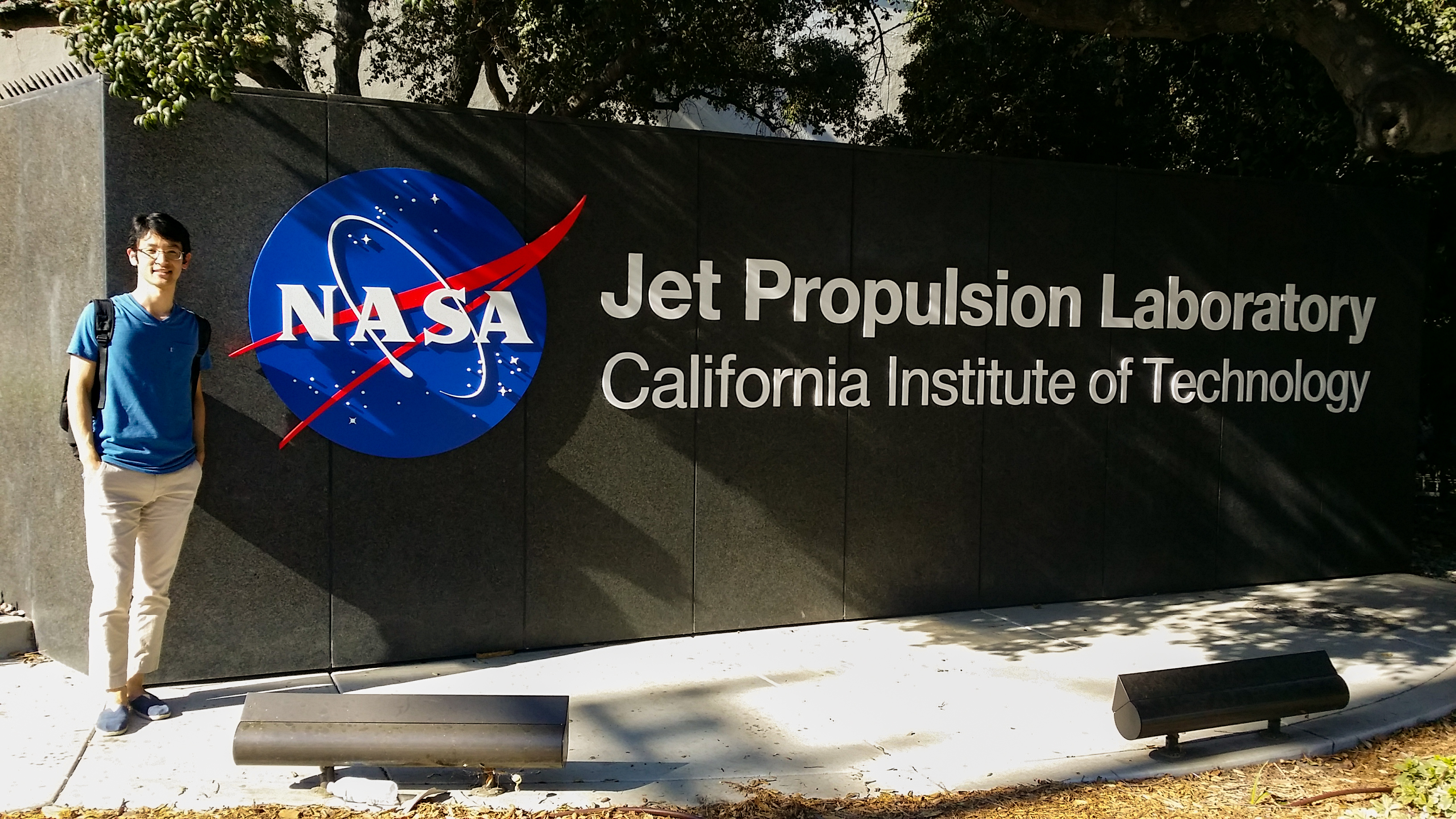
Kim poses for a picture with the JPL sign at the entrance to the Laboratory in Pasadena, California. Image courtesy: Sung Kim | + Expand image
For JPL's part, such technology could be key to designing robots to explore worlds like Jupiter's moon Europa, where the terrain is still relatively unknown. For CoSTAR, it would improve the team's chances of finding artifacts hidden throughout the challenge course, earning the team points toward a victory.
When JPL's DARPA proposal was selected a year later, Agha eagerly enticed the newly graduated Kim back to the laboratory, this time as an employee and the head of CoSTAR's Global Planning Team tasked with "maximizing the chances of finding artifacts hidden in the environment," says Kim.
Kim would be the first of a wave of students who would come to the laboratory over the next several years to lend their expertise in making CoSTAR a reality. In fact, one of them had already arrived.
The Detective
Xianmei "Sammi" Lei was looking to start over. She had come to the U.S. from China and become a legal permanent resident in hopes of finding better career opportunities. But she worried that her options would be limited while she was still making professional connections and learning English. That's when she discovered community college.
"One of the turning points for me here was realizing that we have something called community college," says Lei. "That gave me a lot of opportunities."
It was at Pasadena Community College that Lei started to build a network of peers and professionals and began her foray into the world of robotics. It was also where her passion for computer science was reignited, setting her on a trajectory to JPL and Agha's team.
"I took the beginning level of C++, and I liked it so, so much," says Lei. "I was like, 'Oh my god, you can realize your dreams through programming. That is so powerful!'"
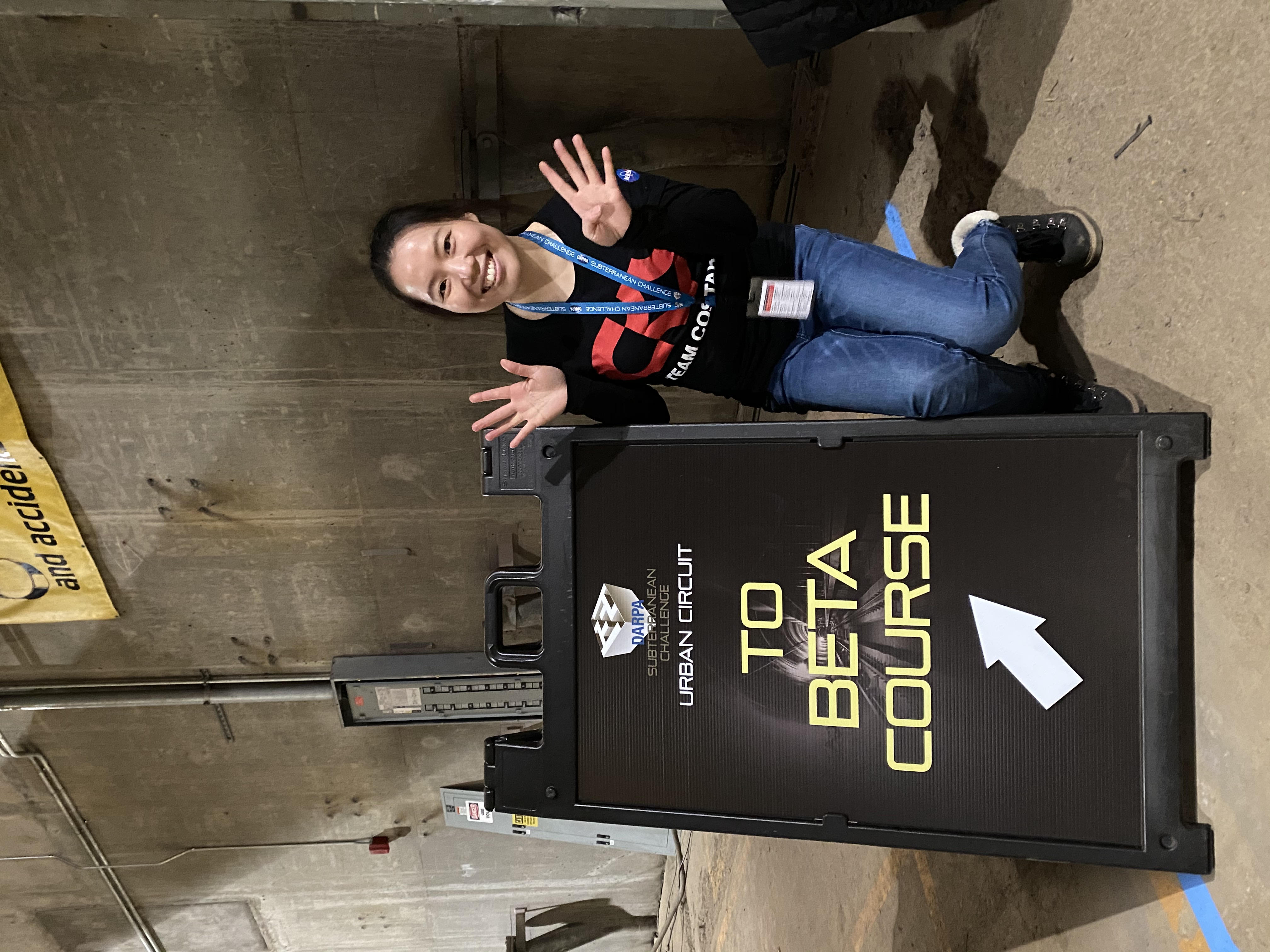
Lei poses outside the course area holding up nine fingers to represent the number of points won by the team during the Urban Circuit in February 2020. Image courtesy: Sammi Lei | + Expand image
Lei applied for an internship at JPL through the Student Independent Research Intern, or SIRI, program, which is designed to pair students from local community colleges with researchers at the laboratory. She caught Agha's eye thanks to her involvement in a swarm robotics competition. Still relatively new to the field, Lei spent her first internship in 2017 soaking it all in, learning as much as she could, reading papers assigned by Agha, and following him to meetings, she says.
At the encouragement of her growing network, Lei applied and was accepted to a master's program at Cal Poly Pomona. She went on to spend four more years at JPL throughout her graduate degree and the entire DARPA challenge. All the while, she played an integral role on CoSTAR as the person in charge of programming the system to detect the most coveted artifact of all.
"Inside the environment was a dummy that was simulating a human survivor with the same weight, same heat, wearing a safety vest, things like that," says Lei. "My job was to detect those signals with the robot and have it report back to the team so the human supervisor could verify."
But before that could happen, the system would need to overcome any number of hazards, which according to DARPA might include small passages, sharp turns, stairs, rails, large drops, mud, sand, water, mist, smoke, dead ends, slippery terrain, communications constraints, moving walls, and falling debris. The team needed a mobility expert.
The Navigator
"I was doing lots of mathy stuff," says David Fan of his doctoral research at Georgia Tech prior to coming to JPL in the fall of 2018.
Fan had been researching algorithms that could help robots learn to independently navigate complex terrain when his advisor told him about an internship opening on Agha's team with the JPL Visiting Student Researchers Program, or JVSRP. Fan saw it as a chance to take his work out of the theoretical and into the real world.
"Once I joined the team and started working on these robots in real life, it opened up a whole set of new problems that I had never thought about before," he says.
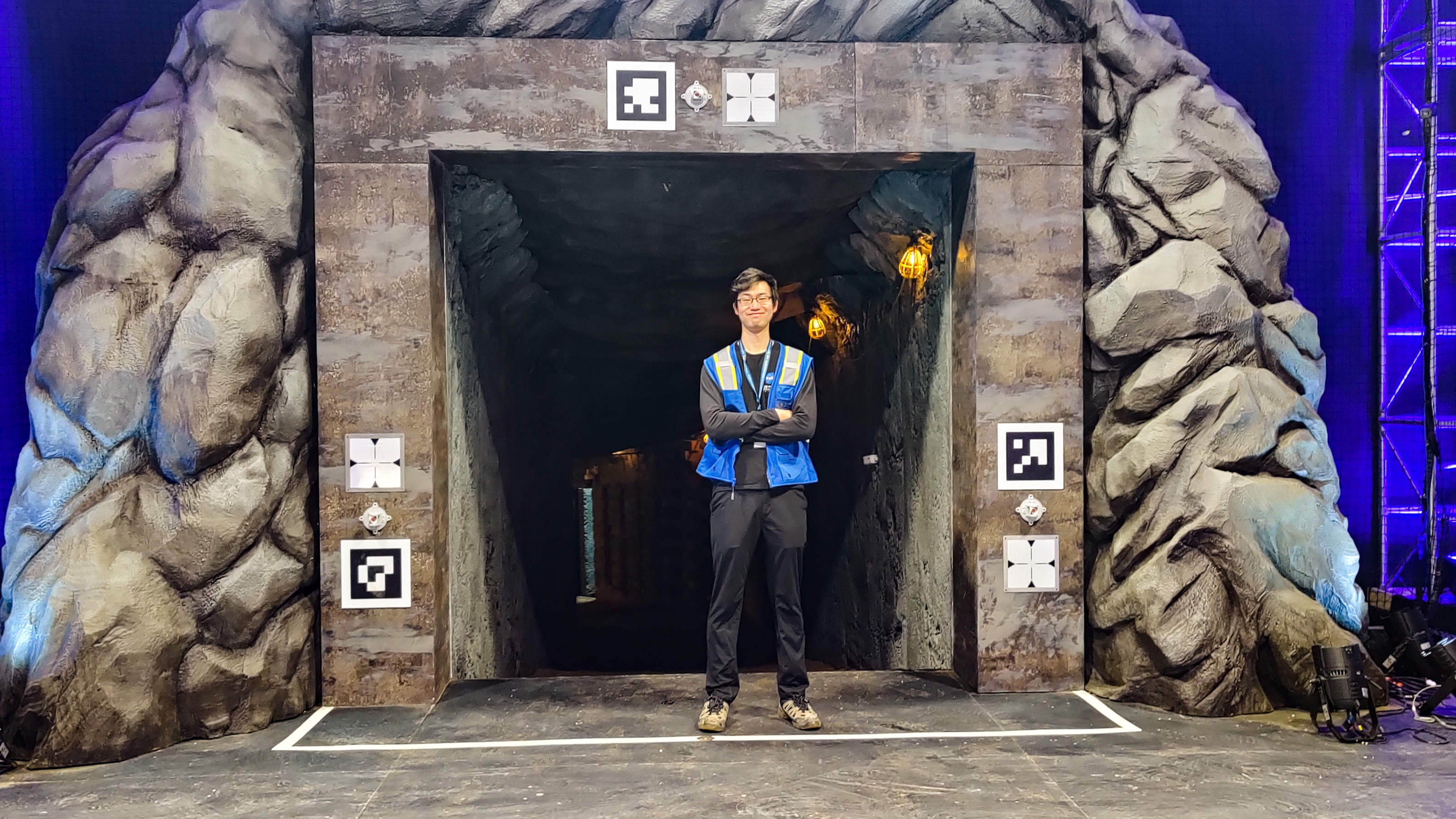
Fan poses in front of the entrance to the DARPA Subterranean Challenge Finals course in September 2021. Fan was one of a handful of team members chosen for the pit crew, which oversaw robot operations during the challenge. Image courtesy: David Fan | + Expand image
Problem one: How to get a robot through a hazard-filled course that requires a system with an almost contradictory set of features – small enough to get through narrow passages but big enough to support computing power, nimble enough to climb stairs and cross slippery terrain but strong enough to withstand falling debris.
Fan spent his early days with the team dreaming up robots with different kinds of locomotion – wheels, tracks, rotors, legs, and so on. Eventually, the team homed in on a solution involving all of the above, multiple robots with unique talents and ways of moving. Fan's doctoral research was key to unlocking how each robot could continually improve their skills, learning to navigate around obstacles as they encountered them.
Like their human counterparts, CoSTAR's robots each bring unique skills to the team, allowing them to autonomously explore caves, pits, tunnels, and other subsurface terrain. Credit: NASA/JPL-Caltech | Watch on YouTube
"Each environment would have its own set of challenges," says Fan, who interned with Agha throughout the DARPA challenge. "Trying to figure out where the robots could safely go in a subway was very different than where they could safely go in a cave or a mine. We broke a lot of robots. It was really fun."
But as often happens in engineering, one solution begets another problem. In this case it was how to coordinate multiple robots and get them working as a team.
The Field Commander
As a child in Indonesia, Muhammad Fadhil Ginting's favorite movie was a documentary about NASA rocket technology built to send astronauts to the Moon. He would watch it and rewatch it, dreaming of one day working at the space agency. But even after he had grown up to earn his bachelor's in engineering and begin to pursue his master's in robotics at one of the world's top universities, ETH Zurich, working for NASA seemed like a distant childhood dream.
That is until he saw an internship opening with Agha's team.
"Back in my undergrad in Indonesia, I was working with underwater robots to explore the ocean. When I found out JPL offered internships with the DARPA challenge team and it was about subsurface explorations, I was so excited," says Ginting who, like Fan, applied through JVSRP, which also brings in a small number of interns from foreign universities to work with JPL researchers. "I met Dr. Agha at an international conference and expressed my interest in joining his team. It was a thrill when he accepted me and welcomed me to the team."
When Ginting came on board, CoSTAR had just placed second in the Tunnel Circuit, the first of the four events.
After helping develop a strategy to coordinate the robots, Ginting was chosen for the team's exclusive "pit crew" along with just four others: Fan, also an intern at the time, and JPL employees Kyon Otsu, Ben Morrell, and Jeffrey Edlund.
On the pit crew, Ginting would have just 30 minutes to set up and release the robots into the subterranean course before he and the others were sequestered in a separate support area from Otsu, the sole robot supervisor. "It meant that I needed to be ready not just for the technical but also operational, anticipating all possible things that can happen in the field."
To prepare both the robots and the pit crew for handling the challenges ahead, the team took multiple field trips around California and to a limestone mine in Kentucky. When that wasn't possible, they sent the robots through cubicle mazes at JPL.
Ginting (shown at 0:18) and other members of team CoSTAR send the robots on a test run through Elma High School in Elma, Washington, in the days leading up to the Urban Circuit. Credit: NASA/JPL-Caltech | Watch on YouTube
Ginting fondly remembers the field trips not just for the opportunity to work out any bugs in the software, but also for the chance to pursue his other passion for outreach, giving talks to college students and kids and chatting up locals at the hotel breakfast bar.
"I liked meeting the community and sharing the excitement of building robots, the excitement of space exploration," says Ginting, who also saw the field trips as a chance to bond with his teammates.
When the Urban Circuit came around in February 2020, the team with Ginting's help earned a first-place spot. And then, COVID hit.
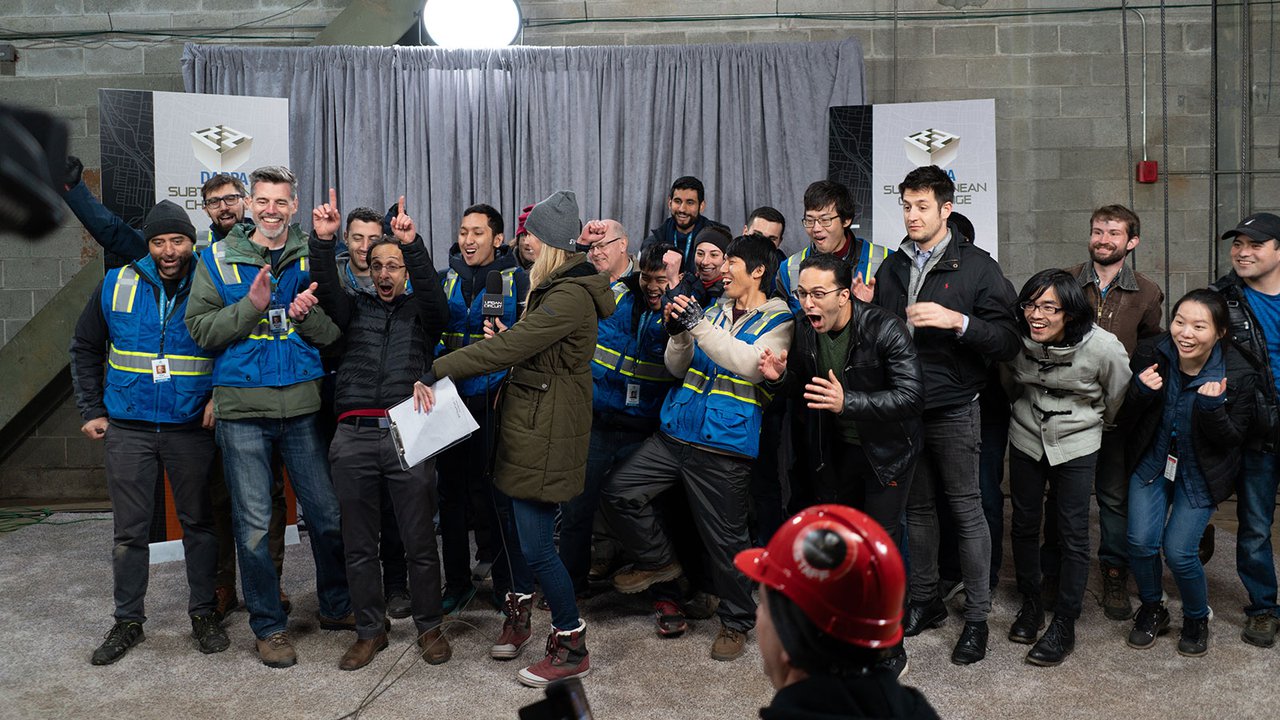
Team CoSTAR reacts to the news that they placed first in the Urban Circuit. Credit: NASA/JPL-Caltech | + Expand image
An Unexpected Challenge
Like it did with so much else, the pandemic threw the team and the competition for a loop.
Interns were sent home along with most of the rest of JPL's more than 6,000 employees, and the CoSTAR team had to learn how to do their work remotely. Lei recalls testing sensors from her home in Los Angeles or asking other team members to try them out in different environments.
In some ways, the remote work was good for the team. Rather than the intensive testing schedule, "people had more time for thinking," says Lei. Meanwhile, the team was able to bring on remote interns previously unable to travel to the Southern California laboratory.
The Cave Circuit, originally scheduled for November 2020, was canceled, but once vaccines began rolling out and restrictions on indoor gatherings were loosened, DARPA announced that the Final Event would take place in September 2021.
The Light at the End of the Tunnel
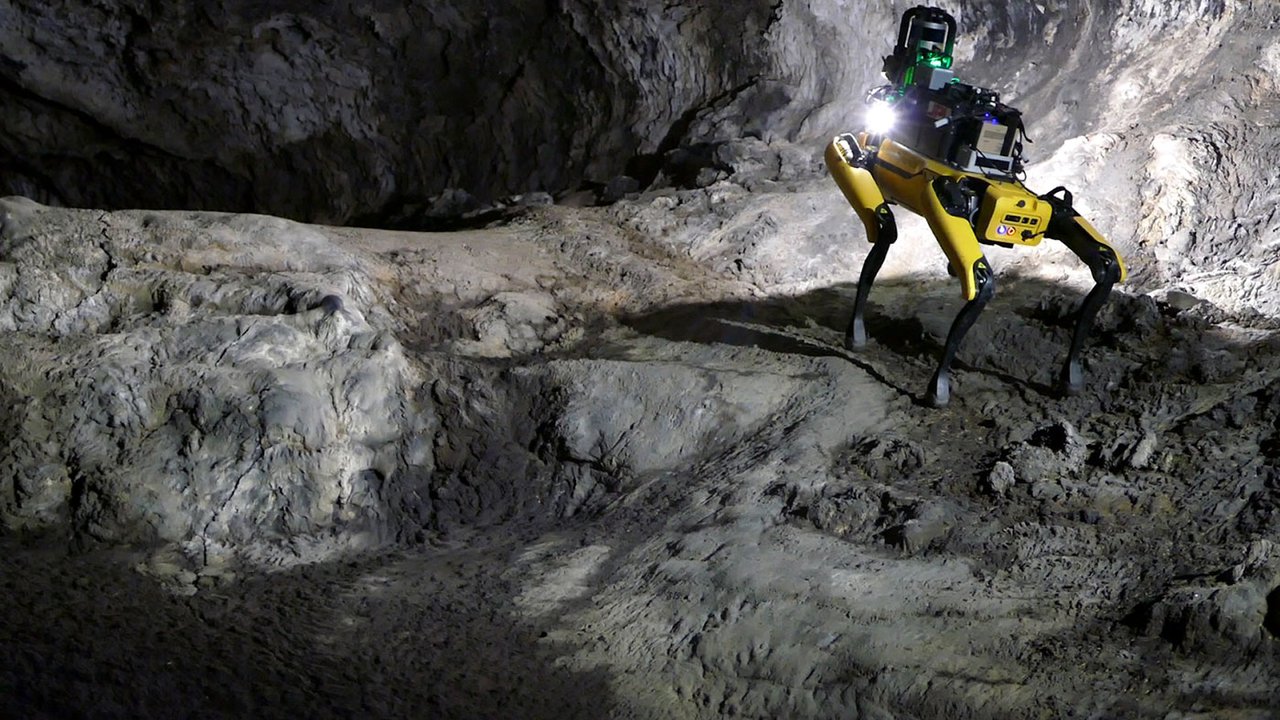
One of the team's robots named NeBula-Spot walks on four legs to explore hard-to-access locations, like this narrow cave. Credit: NASA/JPL-Caltech | + Expand image
"We were in pretty good shape – even in the preliminary rounds, we won with a good margin," says Agha. "But in the final event, our calibration system had an issue, so our robots entered the course 30 minutes late. It wasn't the kind of demonstration we were hoping to be able to have, but for that half of the time, it went really perfect."
While CoSTAR did not win the final competition, the overall experience was an unequivocal win not just for the team, but also for the interns and for JPL.
"We got all this great talent and technology – again, huge thanks to our interns and their mentors," says Agha. "They brought all this expertise to JPL, and the amount of capabilities that got developed really changed a lot about [autonomous technology] at JPL. We pushed state-of-the-art boundaries forward. We published strong papers and showed the world JPL's capabilities."
Already, the team's technology is making its way into a number of JPL and NASA projects including a snake-like robot designed to explore deep crevasses on icy worlds beyond Earth, self-driving offroad cars that could inspire future lunar exploration vehicles, and a project researching the possibility of finding microbial life within volcanic caves on Mars.
Many of the interns say the experience changed the course of their careers.
"It really set me on a different trajectory that I hadn't imagined before," says Fan, who is now working for the U.S. Navy in collaboration with JPL on the project to develop offroad self-driving vehicles. "It introduced me to so many of the real-world robotics problems that are out there waiting to be solved. It opened up a lot of doors and introduced me to a lot of people. It completely changed the trajectory of my Ph.D. and my career."
Lei was recently hired at JPL as a full-time employee, and she says she's looking forward to exploring new ways robots can assist humans in the future.
Kim continues to expand his research in new ways, taking part in JPL projects like Europa Lander, which hopes to send the first robot to explore the icy moon considered to be the next frontier in the search for life beyond Earth.
Ginting was accepted into a doctoral program at Stanford and is continuing his research collaboration with Agha and Kim. He says, "Now, I'm so eager to work on robotics research topics that can also work for space exploration."
In July, the entire team of about 150 people plans to meet up for a reunion cake party. Over the course of the challenge, cake parties had become an annual tradition for the tight knit group. They even managed to hold a virtual party in 2020. As with all things CoSTAR, the bakers go above and beyond to make cakes with life-like caves, moving parts, and LEDs.
When we talked, Agha flipped through photos of cake parties past and said that more than anything, it's this – the team camaraderie, the friendships – that is the greatest win of all.
The laboratory’s STEM internship and fellowship programs are managed by the JPL Education Office. Extending the NASA Office of STEM Engagement’s reach, JPL Education seeks to create the next generation of scientists, engineers, technologists and space explorers by supporting educators and bringing the excitement of NASA missions and science to learners of all ages.
Career opportunities in STEM and beyond can be found online at jpl.jobs. Learn more about careers and life at JPL on LinkedIn and by following @nasajplcareers on Instagram.
TAGS: Internships, Interns, College, Students, Community College, SIRI, JVSRP, YIP, Higher Education, Robotics, Engineering, Computer Science, Asian Pacific American Heritage Month
Edu News | January 26, 2022
24 STEM Lessons You Can Quickly Deploy in the Classroom
Calling all teachers pressed for time, substitutes looking for classroom activities that don't require a lot of prep, and others hoping to keep students learning in especially chaotic times: We've got a new collection of lessons and activities that you can quickly deploy.
Read on to explore our collection of Quick and Easy STEM lessons and student activities, organized by grade band. Get everything you need to guide students through standards-aligned lessons featuring connections to real NASA missions and science as well as links to student projects, which can be led by teachers or assigned as independent activities.
Grades K-2
-
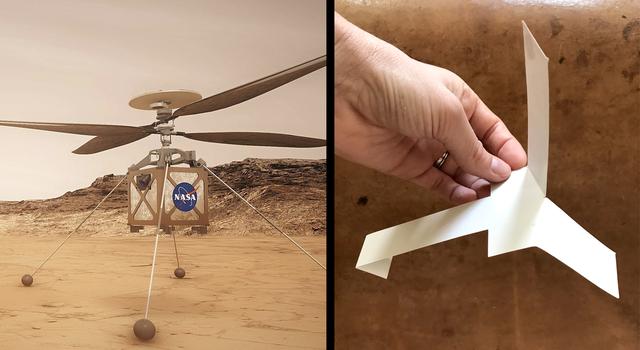
Make a Paper Mars Helicopter
In this lesson, students build a paper helicopter, then improve the design and compare and measure performance.
Subject Engineering
Grades 2-8
Time 30-60 mins
-
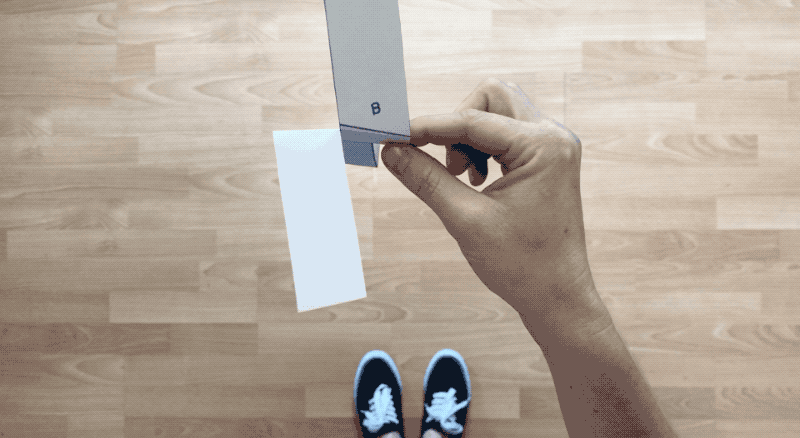
Student Project: Make a Paper Mars Helicopter
Build a paper helicopter, then see if you can improve the design like NASA engineers did when making the first helicopter for Mars.
Subject Engineering
Grades 2-8
Time 30-60 mins
-

What Tools Would You Take to Mars?
Students decide what they want to learn from a robotic mission to Mars and what tools they will put on their robot to accomplish their goals.
Subject Science
Grades K-2
Time 30-60 mins
-
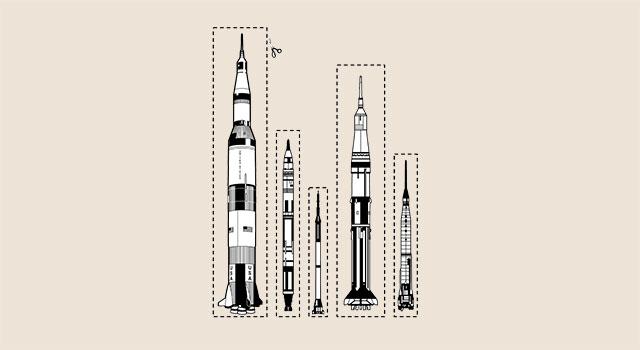
Rockets by Size
Students cut out, color and sequence paper rockets in a simple mathematics lesson on measurement.
Subject Math
Grades K-2
Time 30-60 mins
-
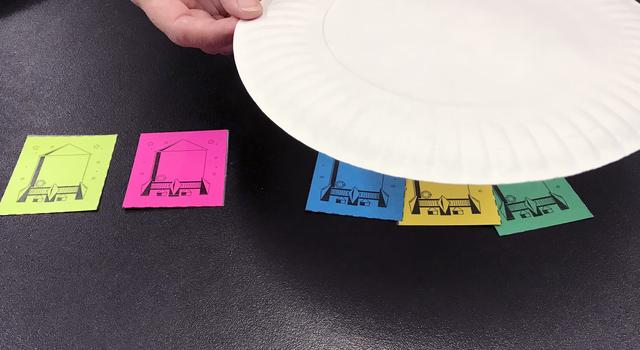
Rocket Math
Students use rocket manipulatives to help them develop number sense, counting, addition and subtraction skills.
Subject Math
Grades K-1
Time 30-60 mins
-
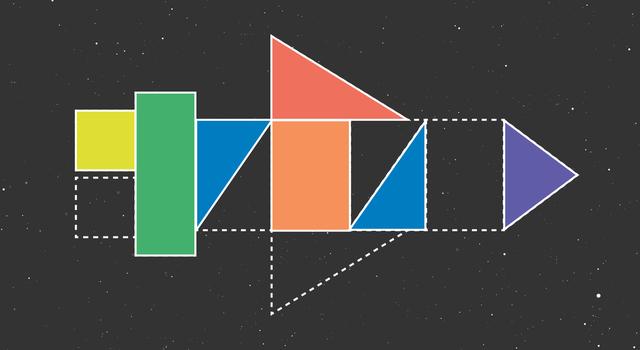
Tangram Rocket
Students use tangrams to create rockets while practicing shape recognition.
Subject Math
Grades K-1
Time 1-2 hrs
-
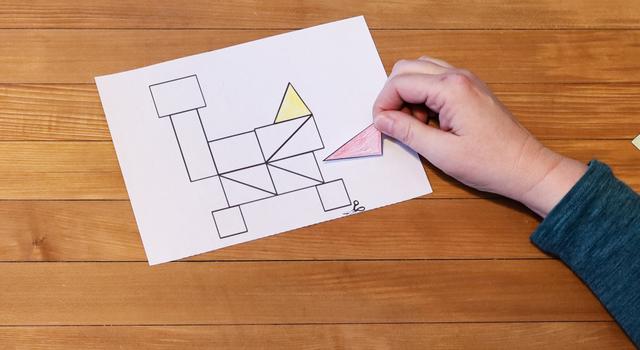
Student Project: Build a Rover and More With Shapes
Use geometric shapes called tangrams to build a rover and other space-themed designs!
Subject Math
Grades K-2
Time Less than 30 mins
-
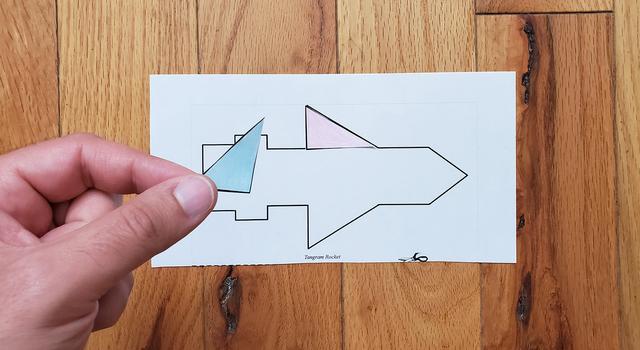
Student Project: Build a Rocket and More With Shapes
Use geometric shapes called tangrams to build a rocket and other space-themed designs!
Subject Math
Grades K-2
Time Less than 30 mins
-
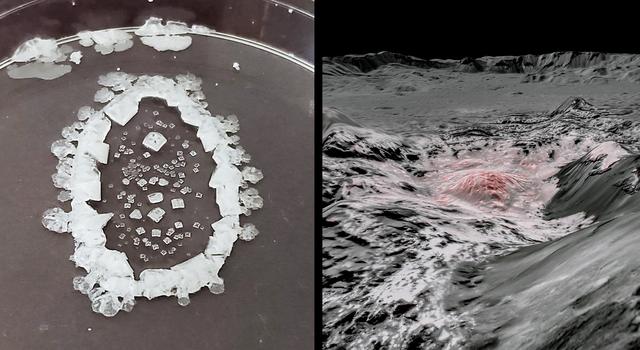
Mineral Mystery Experiment
Students explore the science behind an intriguing planetary feature by creating saline solutions and then observing what happens when the solutions evaporate.
Subject Science
Grades 2-12
Time 2 sessions of 30-60 mins
-

Student Project: Do a Mineral Mystery Experiment
Dissolve salts in water, then observe what happens when the water evaporates.
Subject Science
Grades 2-12
Time 2 sessions of 30-60 mins
-
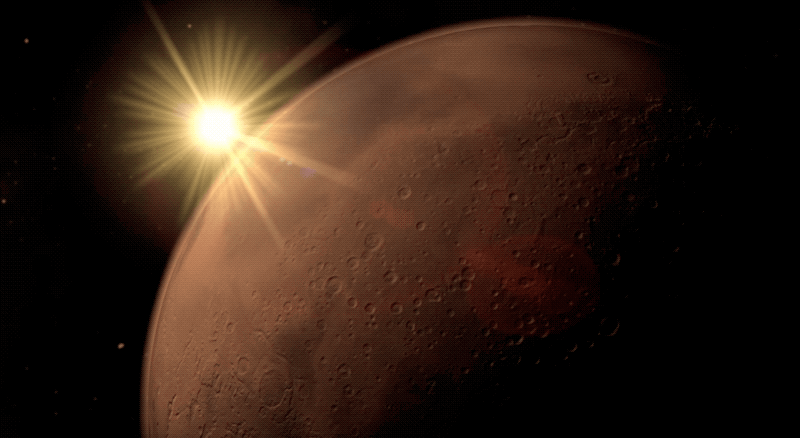
What Do You Know About Mars?
Students decide what they want to learn from a robotic mission to Mars.
Subject Science
Grades K-2
Time Less than 30 mins
-
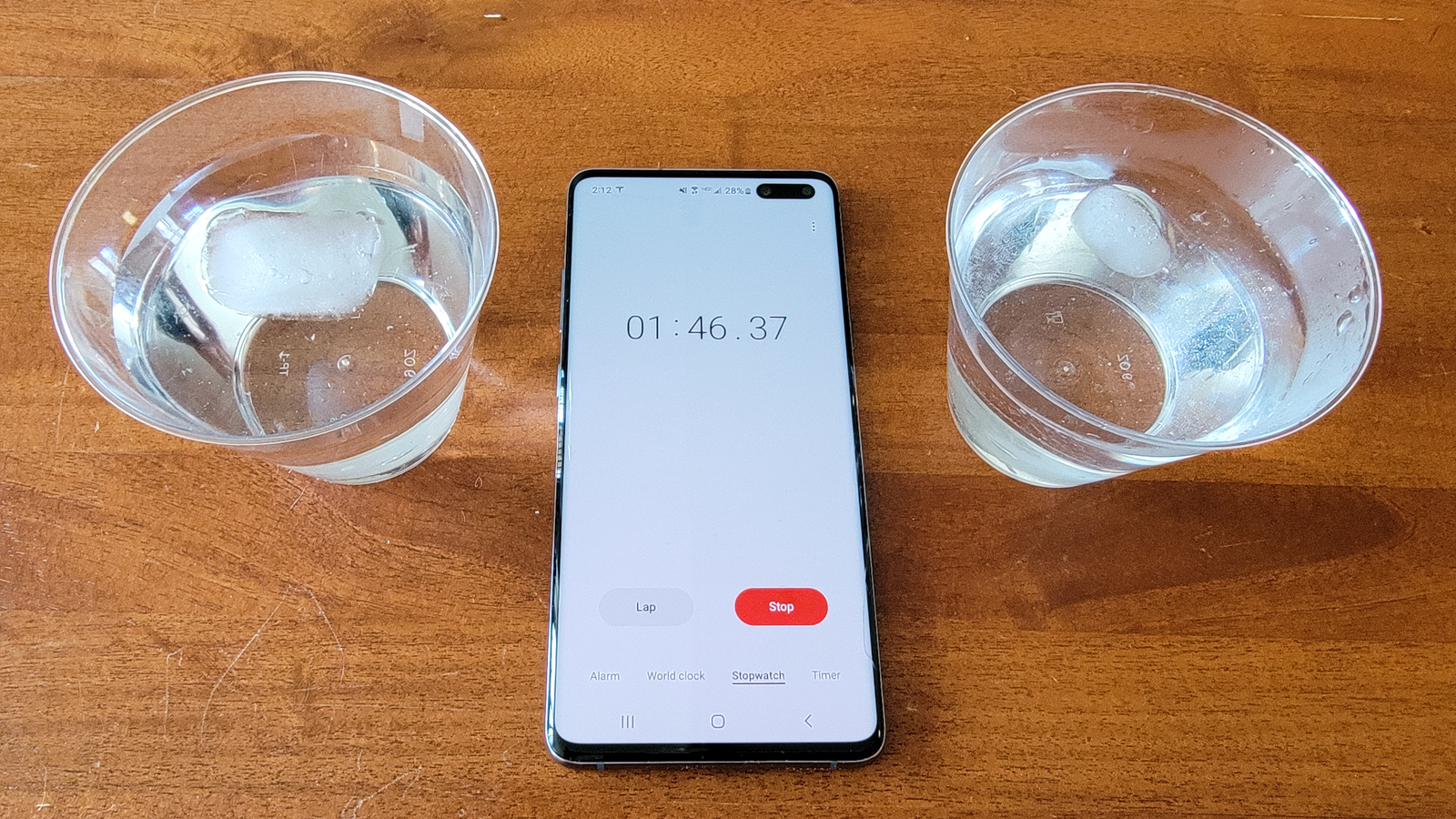
Melting Ice Experiment
Students make predictions and observations about how ice will melt in different conditions then compare their predictions to results as they make connections to melting glaciers.
Subject Science
Grades 2-12
Time 30-60 mins
-
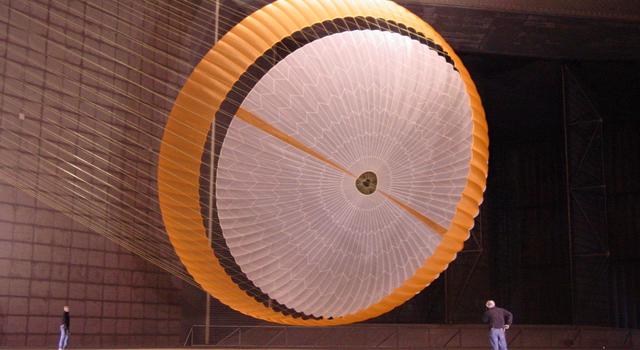
Parachute Design
Students design and test parachute landing systems to successfully land a probe on target.
Subject Engineering
Grades K-2
Time 1-2 hrs
-
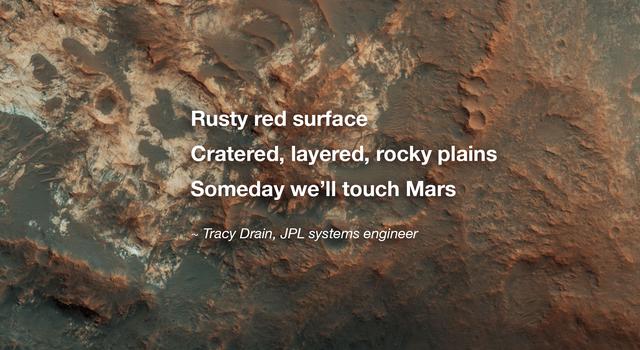
Planetary Poetry
In this cross-curricular STEM and language arts lesson, students learn about planets, stars and space missions and write STEM-inspired poetry to share their knowledge of or inspiration about these topics.
Subject Science
Grades 2-12
Time 1-2 hrs
-
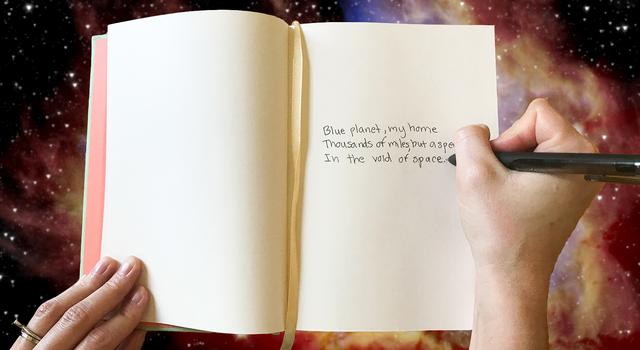
Student Project: Write a Poem About Space
Are you a space poet, and you didn't even know it? Find out how to create your own poems inspired by space!
Subject Science
Grades 2-12
Time 30-60 mins
-
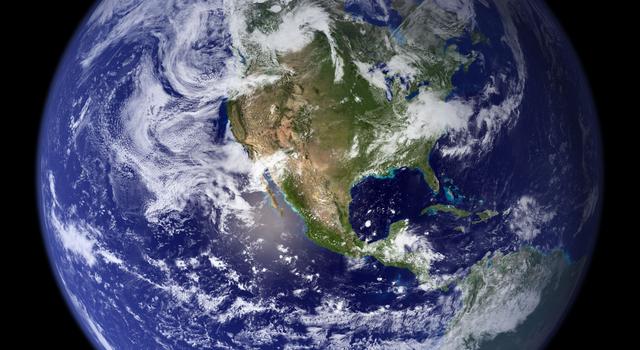
Ocean World: Earth Globe Toss Game
Students use NASA images and a hands-on activity to compare the amounts of land and surface water on our planet.
Subject Science
Grades K-6
Time Less than 30 mins
-
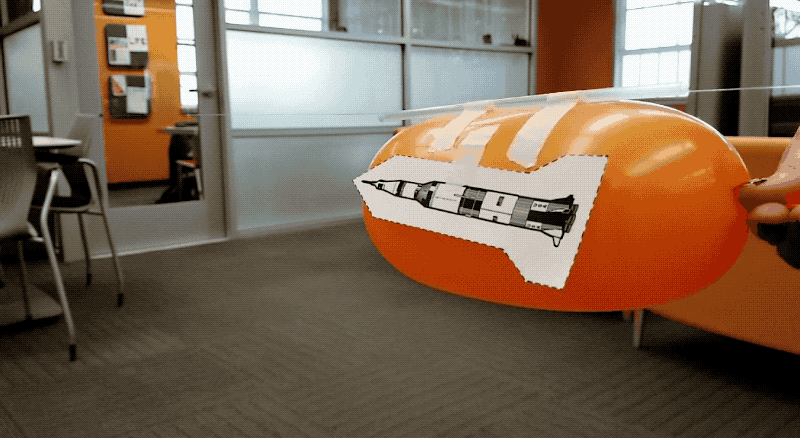
Simple Rocket Science Continued
Students gather data on a balloon rocket launch, then create a simple graph to show the results of the tests.
Subject Math
Grades K-2
Time 30-60 mins
-
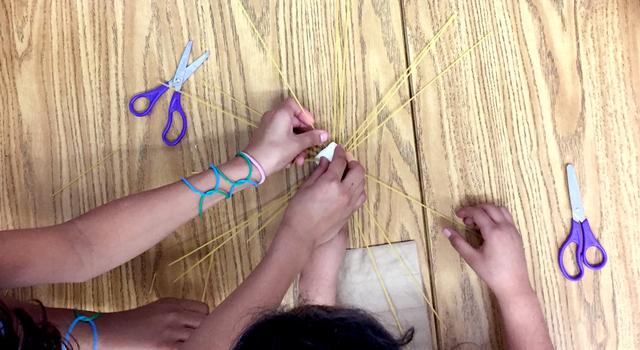
Spaghetti Anyone? Building with Pasta
Students use the engineering design process to build a structure to handle the greatest load and gain first-hand experience with compression and tension forces.
Subject Engineering
Grades K-8
Time Less than 30 mins
-
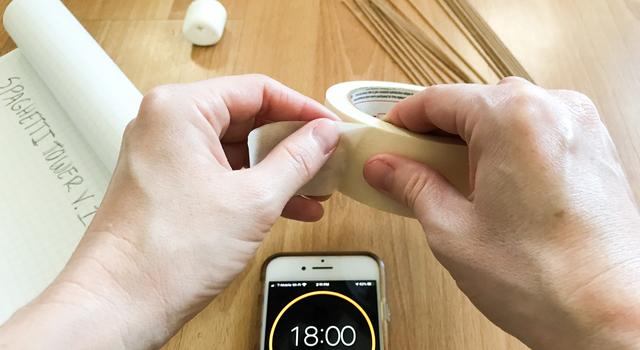
Student Project: Building With Spaghetti
Use spaghetti to build a tower modeled after the giant structures NASA uses to talk to spacecraft.
Subject Engineering
Grades K-8
Time 30-60 mins
-

Simple Rocket Science
Students perform a simple science experiment to learn how a rocket works and demonstrate Newton’s third law of motion.
Subject Science
Grades K-2
Time 30-60 mins
Grades 3-5
-

Make a Paper Mars Helicopter
In this lesson, students build a paper helicopter, then improve the design and compare and measure performance.
Subject Engineering
Grades 2-8
Time 30-60 mins
-

Student Project: Make a Paper Mars Helicopter
Build a paper helicopter, then see if you can improve the design like NASA engineers did when making the first helicopter for Mars.
Subject Engineering
Grades 2-8
Time 30-60 mins
-
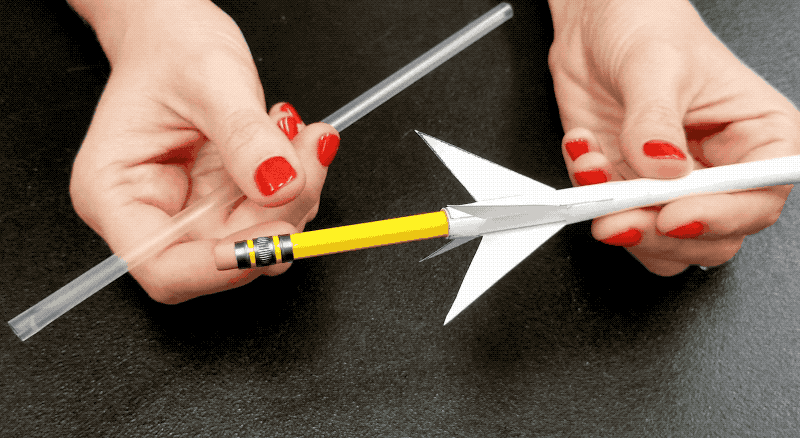
Soda-Straw Rockets
Students study rocket stability as they design, construct and launch paper rockets using soda straws.
Subject Engineering
Grades 4-8
Time Less than 30 mins
-
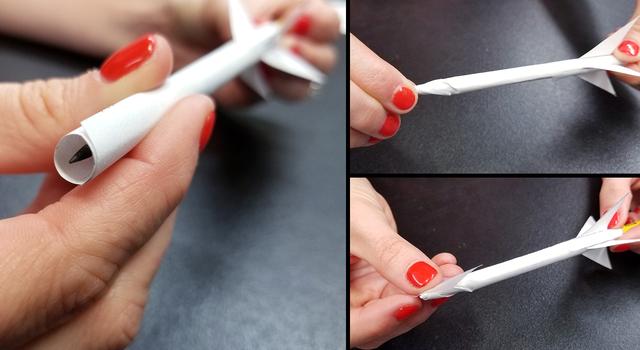
Student Project: Make a Straw Rocket
Create a paper rocket that can be launched from a soda straw – then, modify the design to make the rocket fly farther!
Subject Engineering
Grades 4-8
Time Less than 30 mins
-
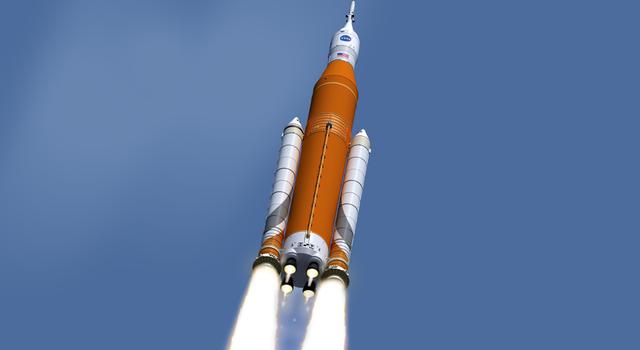
Rocket Activity: Heavy Lifting
Students construct balloon-powered rockets to launch the greatest payload possible to the classroom ceiling.
Subject Engineering
Grades 3-8
Time 30-60 mins
-

Design a Robotic Insect
Students design a robotic insect for an extraterrestrial environment, then compare the process to how NASA engineers design robots for extreme environments like Mars.
Subject Science
Grades 3-5
Time 30-60 mins
-
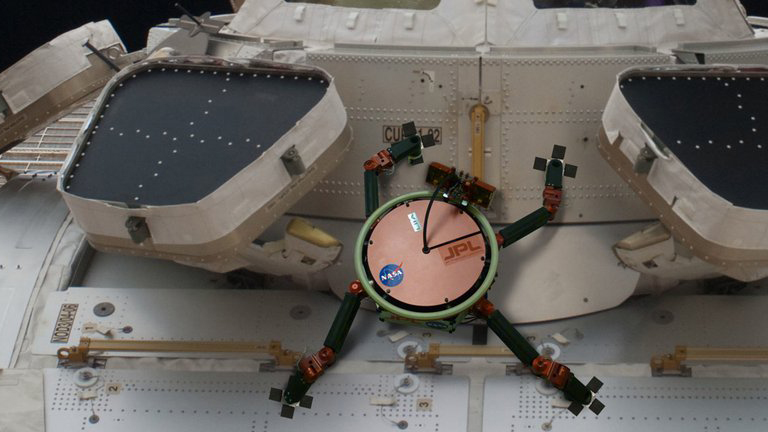
Student Project: Design a Robotic Insect
Design a robotic insect to go to an extreme environment. Then, compare the design process to what NASA engineers do when building robots for Mars!
Subject Science
Grades 3-5
Time 30-60 mins
-

Mineral Mystery Experiment
Students explore the science behind an intriguing planetary feature by creating saline solutions and then observing what happens when the solutions evaporate.
Subject Science
Grades 2-12
Time 2 sessions of 30-60 mins
-

Student Project: Do a Mineral Mystery Experiment
Dissolve salts in water, then observe what happens when the water evaporates.
Subject Science
Grades 2-12
Time 2 sessions of 30-60 mins
-

How Far Away Is Space?
Students use measurement skills to determine the scale distance to space on a map.
Subject Math
Grades 3-7
Time 30-60 mins
-
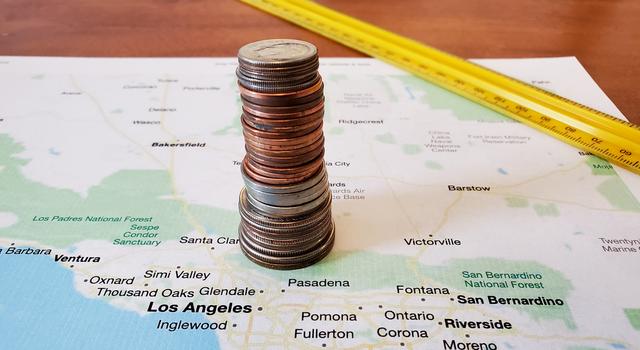
Student Project: How Far Away Is Space?
Stack coins and use your measurement skills to figure out the scale distance from Earth's surface to space.
Subject Math
Grades 3-7
Time 30-60 mins
-

Melting Ice Experiment
Students make predictions and observations about how ice will melt in different conditions then compare their predictions to results as they make connections to melting glaciers.
Subject Science
Grades 2-12
Time 30-60 mins
-

Planetary Poetry
In this cross-curricular STEM and language arts lesson, students learn about planets, stars and space missions and write STEM-inspired poetry to share their knowledge of or inspiration about these topics.
Subject Science
Grades 2-12
Time 1-2 hrs
-

Student Project: Write a Poem About Space
Are you a space poet, and you didn't even know it? Find out how to create your own poems inspired by space!
Subject Science
Grades 2-12
Time 30-60 mins
-

Planetary Travel Time
Students will compute the approximate travel time to planets in the solar system using different modes of transportation.
Subject Math
Grades 4-6
Time 30-60 mins
-
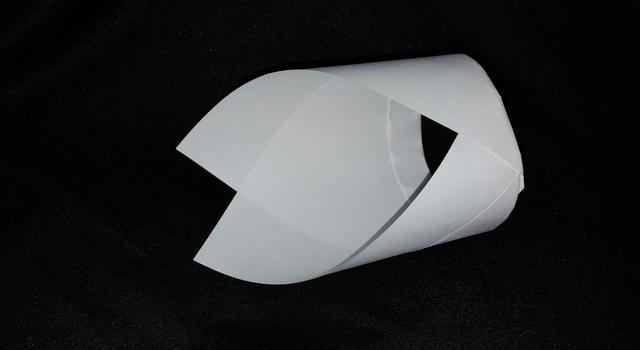
The Ring Wing Glider
In this simple engineering design lesson, students turn a piece of paper into an aircraft wing and then try to improve upon their design.
Subject Engineering
Grades 3-8
Time 30-60 mins
-
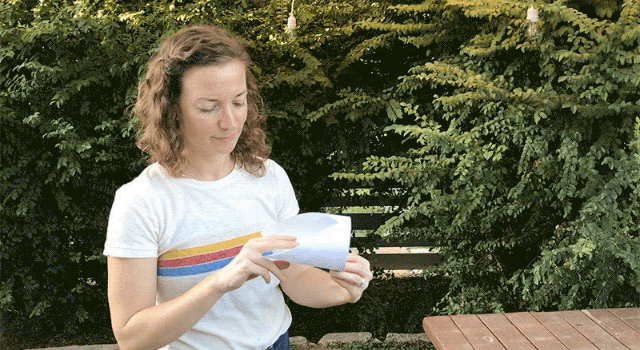
Student Project: Make a Paper Glider
Turn a piece of paper into a glider inspired by a NASA design.
Subject Engineering
Grades 3-8
Time 30-60 mins
-

Ocean World: Earth Globe Toss Game
Students use NASA images and a hands-on activity to compare the amounts of land and surface water on our planet.
Subject Science
Grades K-6
Time Less than 30 mins
-

Spaghetti Anyone? Building with Pasta
Students use the engineering design process to build a structure to handle the greatest load and gain first-hand experience with compression and tension forces.
Subject Engineering
Grades K-8
Time Less than 30 mins
-

Student Project: Building With Spaghetti
Use spaghetti to build a tower modeled after the giant structures NASA uses to talk to spacecraft.
Subject Engineering
Grades K-8
Time 30-60 mins
Grades 6-8
-

Make a Paper Mars Helicopter
In this lesson, students build a paper helicopter, then improve the design and compare and measure performance.
Subject Engineering
Grades 2-8
Time 30-60 mins
-

Student Project: Make a Paper Mars Helicopter
Build a paper helicopter, then see if you can improve the design like NASA engineers did when making the first helicopter for Mars.
Subject Engineering
Grades 2-8
Time 30-60 mins
-

Soda-Straw Rockets
Students study rocket stability as they design, construct and launch paper rockets using soda straws.
Subject Engineering
Grades 4-8
Time Less than 30 mins
-

Student Project: Make a Straw Rocket
Create a paper rocket that can be launched from a soda straw – then, modify the design to make the rocket fly farther!
Subject Engineering
Grades 4-8
Time Less than 30 mins
-

Rocket Activity: Heavy Lifting
Students construct balloon-powered rockets to launch the greatest payload possible to the classroom ceiling.
Subject Engineering
Grades 3-8
Time 30-60 mins
-

Mineral Mystery Experiment
Students explore the science behind an intriguing planetary feature by creating saline solutions and then observing what happens when the solutions evaporate.
Subject Science
Grades 2-12
Time 2 sessions of 30-60 mins
-

Student Project: Do a Mineral Mystery Experiment
Dissolve salts in water, then observe what happens when the water evaporates.
Subject Science
Grades 2-12
Time 2 sessions of 30-60 mins
-

How Far Away Is Space?
Students use measurement skills to determine the scale distance to space on a map.
Subject Math
Grades 3-7
Time 30-60 mins
-

Student Project: How Far Away Is Space?
Stack coins and use your measurement skills to figure out the scale distance from Earth's surface to space.
Subject Math
Grades 3-7
Time 30-60 mins
-

Melting Ice Experiment
Students make predictions and observations about how ice will melt in different conditions then compare their predictions to results as they make connections to melting glaciers.
Subject Science
Grades 2-12
Time 30-60 mins
-

Planetary Poetry
In this cross-curricular STEM and language arts lesson, students learn about planets, stars and space missions and write STEM-inspired poetry to share their knowledge of or inspiration about these topics.
Subject Science
Grades 2-12
Time 1-2 hrs
-

Student Project: Write a Poem About Space
Are you a space poet, and you didn't even know it? Find out how to create your own poems inspired by space!
Subject Science
Grades 2-12
Time 30-60 mins
-

Planetary Travel Time
Students will compute the approximate travel time to planets in the solar system using different modes of transportation.
Subject Math
Grades 4-6
Time 30-60 mins
-

The Ring Wing Glider
In this simple engineering design lesson, students turn a piece of paper into an aircraft wing and then try to improve upon their design.
Subject Engineering
Grades 3-8
Time 30-60 mins
-

Student Project: Make a Paper Glider
Turn a piece of paper into a glider inspired by a NASA design.
Subject Engineering
Grades 3-8
Time 30-60 mins
-

Ocean World: Earth Globe Toss Game
Students use NASA images and a hands-on activity to compare the amounts of land and surface water on our planet.
Subject Science
Grades K-6
Time Less than 30 mins
-

Spaghetti Anyone? Building with Pasta
Students use the engineering design process to build a structure to handle the greatest load and gain first-hand experience with compression and tension forces.
Subject Engineering
Grades K-8
Time Less than 30 mins
-

Student Project: Building With Spaghetti
Use spaghetti to build a tower modeled after the giant structures NASA uses to talk to spacecraft.
Subject Engineering
Grades K-8
Time 30-60 mins
-
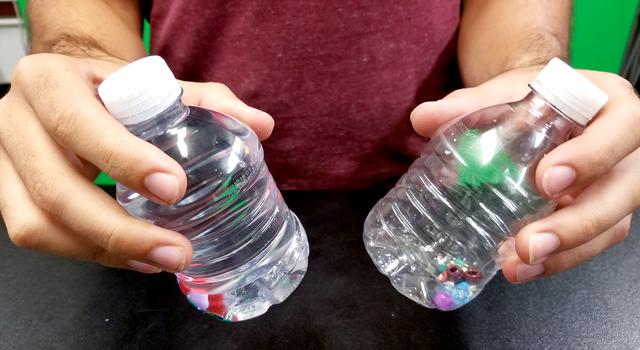
How Do We See Dark Matter?
Students will make observations of two containers and identify differences in content, justify their claims and make comparisons to dark matter observations.
Subject Science
Grades 6-12
Time Less than 30 mins
Grades 9-12
-

Mineral Mystery Experiment
Students explore the science behind an intriguing planetary feature by creating saline solutions and then observing what happens when the solutions evaporate.
Subject Science
Grades 2-12
Time 2 sessions of 30-60 mins
-

Student Project: Do a Mineral Mystery Experiment
Dissolve salts in water, then observe what happens when the water evaporates.
Subject Science
Grades 2-12
Time 2 sessions of 30-60 mins
-

Melting Ice Experiment
Students make predictions and observations about how ice will melt in different conditions then compare their predictions to results as they make connections to melting glaciers.
Subject Science
Grades 2-12
Time 30-60 mins
-

Planetary Poetry
In this cross-curricular STEM and language arts lesson, students learn about planets, stars and space missions and write STEM-inspired poetry to share their knowledge of or inspiration about these topics.
Subject Science
Grades 2-12
Time 1-2 hrs
-

Student Project: Write a Poem About Space
Are you a space poet, and you didn't even know it? Find out how to create your own poems inspired by space!
Subject Science
Grades 2-12
Time 30-60 mins
-

Let's Go to Mars! Calculating Launch Windows
Students use advanced algebra concepts to determine the next opportunity to launch a spacecraft to Mars.
Subject Math
Grades 9-12
Time 30-60 mins
-

How Do We See Dark Matter?
Students will make observations of two containers and identify differences in content, justify their claims and make comparisons to dark matter observations.
Subject Science
Grades 6-12
Time Less than 30 mins
Explore More
Find our full collection of more than 250 STEM educator guides and student activities in Teach and Learn.
For games, articles, and more activities from NASA for kids in upper-elementary grades, visit NASA Space Place and NASA Climate Kids.
Explore more educational resources and opportunities for students and educators from NASA STEM Engagement.
TAGS: Lessons, Teachers, Educators, Parents, Substitutes, Activities, Students, Science, Engineering, Quick and Easy
Edu News | December 6, 2021
The Best New STEM Education Resources from NASA-JPL in 2021
In 2021, we added nearly 80 STEM education resources to our online catalog of lessons, activities, articles, and videos for educators, students, and families. The resources feature NASA's latest missions exploring Earth, the Moon, Mars, asteroids, the Solar System and the universe beyond. Here are the 10 resources our audiences visited most this year.
NASA's Mission to Mars Student Challenge
To kick off the year, we invited students, educators, and families from around the world to create their own mission to Mars as we counted down to the Perseverance rover's epic landing on the Red Planet in February. More than one million students participated in the Mission to Mars Student Challenge, which features seven weeks of guided education plans, student projects, and expert talks and interviews highlighting each phase of a real Mars mission.
It's no surprise that this was our most popular product of the year. And good news: It's still available and timely! With Perseverance actively exploring Mars and making new discoveries all the time, the challenge offers ongoing opportunities to get students engaged in real-world STEM.
Need a primer on the Perseverance Mars rover mission, first? This article from our Teachable Moments series has you covered.
Solar System Size and Distance
This video offers a short and simple answer to two of students' most enduring questions: How do the sizes of planets compare and how far is it between them? Plus, it gets at why we don't often (or ever) see images that show all the planets' sizes and distances to scale. Spoiler alert: It's pretty much impossible to do.
Get students exploring solar system size and distance in more detail and even making their own scale models with this student project.
Code a Mars Helicopter Video Game
As you'll soon see from the rest of this list, coding projects were a big draw this year. This one took off along with Ingenuity, the first helicopter designed to fly on Mars, which made its historic first flight in April. Designed as a test of technology that could be used on future missions, Ingenuity was only slated for a few flights, but it has far exceeded even that lofty goal.
In this project, students use the free visual programming language Scratch to create a game inspired by the helicopter-that-could.
Make a Moon Phases Calendar and Calculator
Just updated for 2022, this project is part educational activity and part art for your walls. Students learn about moon phases to complete this interactive calendar, which shows when and where to see moon phases throughout the year, plus lists moon events such as lunar eclipses and supermoons. The art-deco inspired design might just have you wanting to make one for yourself, too.
The NASA Pi Day Challenge
This year marked the eighth installment of our annual Pi Day Challenge, a set of illustrated math problems featuring pi (of course) and NASA missions and science. Don't let the name fool you – these problems are fun to solve year round.
Students can choose from 32 different problems that will develop their math skills while they take on some of the same challenges faced by NASA scientists and engineers. New this year are puzzlers featuring the OSIRIS-REx asteroid mission, Mars helicopter, Deep Space Network, and aurora science.
Educator guides for each problem and problem set are also available here. And don't miss the downloadable posters and virtual meeting backgrounds.
Code a Mars Sample Collection Video Game
Another coding challenge using the visual programming language Scratch, this project is inspired by the Perseverance Mars rover mission, which is collecting samples that could be brought back to Earth by a potential future mission.
While developing a gamified version of the process, students are introduced to some of the considerations scientists and engineers have to make when collecting samples on Mars.
Code a Mars Landing
As if launching a rover to Mars wasn't hard enough, you still have to land when you get there. And that means using a complex series of devices – from parachutes to jet packs to bungee cords – and maneuvers that have to be performed remotely using instructions programmed into the spacecraft's computer.
Students who are ready to take their programming skills to the next level can get an idea of what it takes in this project, which has them use Python and microcontrollers to simulate the process of landing a rover on Mars.
How Far Away is Space?
Without giving the answer away: It's not as far as you might think.
In this activity, students stack coins (or other objects) on a map of their local area as a scale model of the distance to space. The stacking continues to the International Space Station, the Moon, and finally to the future orbit of the James Webb Space Telescope, which is slated to launch on Dec. 22.
Build a Rover and More With Shapes
You don't have to be a big kid to start learning about space exploration. This activity, which is designed for kids in kindergarten through second grade, has learners use geometric shapes called tangrams to fill in a Mars rover design. It provides an introduction to geometry and thinking spatially.
Once kids become experts at building rovers, have them try building rockets.
Space Voyagers: The Game
Technically a classroom activity (it is standards-aligned, after all), this game will appeal to students and strategy card game enthusiasts alike. Download and print out a set for your classroom (or your next game night).
Players work collaboratively to explore destinations including the Moon, Mars, Jupiter and Jupiter's Moon Europa with actual NASA spacecraft and science instruments while working to overcome realistic challenges at their destination including dust storms and instrument failures.
TAGS: K-12, Lessons, Activities, Education Resources, Teachers, Students, Families, Kids, Learning, STEM, Science, Engineering, Technology, Math, Coding, Programming, Mars, Solar System, Moon
Teachable Moments | September 30, 2021
Learn About the Universe With the James Webb Space Telescope
Get a look into the science and engineering behind the largest and most powerful space telescope ever built while exploring ways to engage learners in the mission.
NASA is launching the largest, most powerful space telescope ever. The James Webb Space Telescope will look back at some of the earliest stages of the universe, gather views of early star and galaxy formation, and provide insights into the formation of planetary systems, including our own solar system.
Read on to learn more about what the space-based observatory will do, how it works, and how to engage learners in the science and engineering behind the mission.
What It Will Do
The James Webb Space Telescope, or JWST, was developed through a partnership between NASA and the European and Canadian space agencies. It will build upon and extend the discoveries made by the Hubble Space Telescope to help unravel mysteries of the universe. First, let's delve into what scientists hope to learn with the Webb telescope.
A look at the James Webb Space Telescope, its mission and the incredible technological challenge this mission presents. | Watch on YouTube
How Galaxies Evolve
What the first galaxies looked like and when they formed is not known, and the Webb telescope is designed to help scientists learn more about that early period of the universe. To better understand what the Webb telescope will study, it’s helpful to know what happened in the early universe, before the first stars formed.
The universe, time, and space all began about 13.8 billion years ago with the Big Bang. For the first few hundred-thousand years, the universe was a hot, dense flood of protons, electrons, and neutrons, the tiny particles that make up atoms. As the universe cooled, protons and neutrons combined into ionized hydrogen and helium, which had a positive charge, and eventually attracted all those negatively charged electrons. This process, known as recombination, occurred about 240,000 to 300,000 years after the Big Bang.

This image shows the temperature fluctuations (shown as color differences) in the cosmic microwave background from a time when the universe was less than 400,000 years old. The image was captured by the Wilkinson Microwave Anisotropy Probe, or WMAP, which spent nine years, from 2001 to 2010, collecting data on the early universe. Credit: NASA | › Full image and caption | + Expand image
Light that previously couldn’t travel without being scattered by the dense ionized plasma of early particles could now travel freely. The very first form of light we can look back and see comes from this time and is known as the cosmic microwave background radiation. It is essentially a map of temperature fluctuations across the universe left behind from the Big Bang. The fluxuations give clues about the origin of galaxies and the large-scale structure of galaxies. There were still no stars in the universe at this time, so the next several hundred million years are known as the cosmic dark ages.
Current theory predicts that the earliest stars were big – 30 to 300 times the size of our Sun – and burned quickly, ending in supernova explosions after just a few million years. (For comparison, our Sun has a lifespan of about 10 billion years and will not go supernova.) Observing these luminous supernovae is one of the few ways scientists could study the earliest stars. That is vital to understanding the formation of objects such as the first galaxies.
By using the Webb telescope to compare the earliest galaxies with those of today, scientists hope to understand how they form, what gives them their shape, how chemical elements are distributed across galaxies, how central black holes influence their galaxies, and what happens when galaxies collide.
Learn how the James Webb Space Telescope's ability to look farther into space than ever before will bring newborn galaxies into view. | Watch on YouTube
How Stars and Planetary Systems Form
Stars and their planetary systems form within massive clouds of dust and gas. It's impossible to see into these clouds with visible light, so the Webb telescope is equipped with science instruments that use infrared light to peer into the hearts of stellar nurseries. When viewing these nurseries in the mid-infrared – as the Webb telescope is designed to do – the dust outside the dense star forming regions glows and can be studied directly. This will allow astronomers to observe the details of how stars are born and investigate why most stars form in groups as well as how planetary systems begin and evolve.

This mosaic image is the sharpest wide-angle view ever obtained of the starburst galaxy, Messier 82 (M82). The galaxy is remarkable for its bright blue disk, webs of shredded clouds and fiery-looking plumes of glowing hydrogen blasting out of its central regions.Throughout the galaxy's center, young stars are being born 10 times faster than they are inside our entire Milky Way Galaxy. Credit: NASA, ESA, and The Hubble Heritage Team (STScI/AURA); Acknowledgment: J. Gallagher (University of Wisconsin), M. Mountain (STScI), and P. Puxley (National Science Foundation) | › Full image and caption | + Expand image
How Exoplanets and Our Solar System Evolve
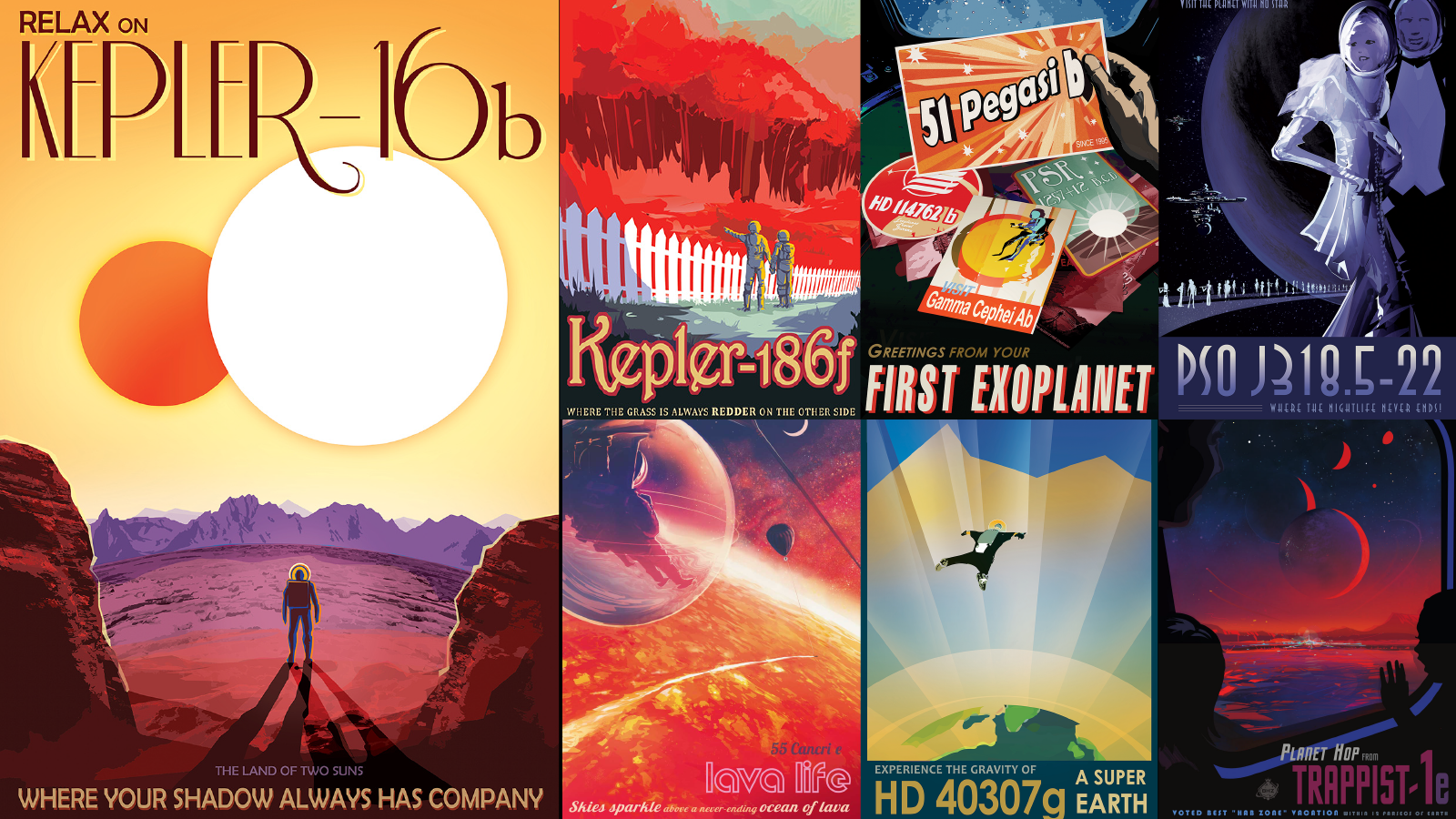
As we make more discoveries about exoplanets, artists at NASA are imagining what future explorers might encounter on these faraway worlds as part of the Exoplanet Travel Bureau poster series. Credit: NASA | › View and download the posters | + Expand image
The first planet outside our solar system, or exoplanet, was discovered in 1992. Since then, scientists have found thousands more exoplanets and estimate that there are hundreds of billions in the Milky Way galaxy alone. There are many waiting to be discovered and there is more to learn about the exoplanets themselves, such as what makes up their atmospheres and what their weather and seasons may be like. The Webb telescope will help scientists do just that.
In our own solar system, the Webb telescope will study planets and other objects to help us learn more about our solar neighborhood. It will be able to complement studies of Mars being carried out by orbiters, landers, and rovers by searching for molecules that may be signs of past or present life. It is powerful enough to identify and characterize icy comets in the far reaches of our solar system. And it can be used to study places like Saturn, Uranus, and Neptune while there are no active missions at those planets.
How It Works
The Webb telescope has unique capabilities enabled by the way it views the universe, its size, and the new technologies aboard. Here's how it works.
Peering Into the Infrared
To see ancient, distant galaxies, the Webb telescope was built with instruments sensitive to light in the near- and mid-infrared wavelengths.
Light leaving these galaxies can take billions of years to reach Earth, so when we see these objects, we’re actually seeing what they looked like in the past. The farther something is from Earth, the farther back in time it is when we observe it. So when we look at light that left objects 13.5 billion years ago, we're seeing what happened in the early universe.
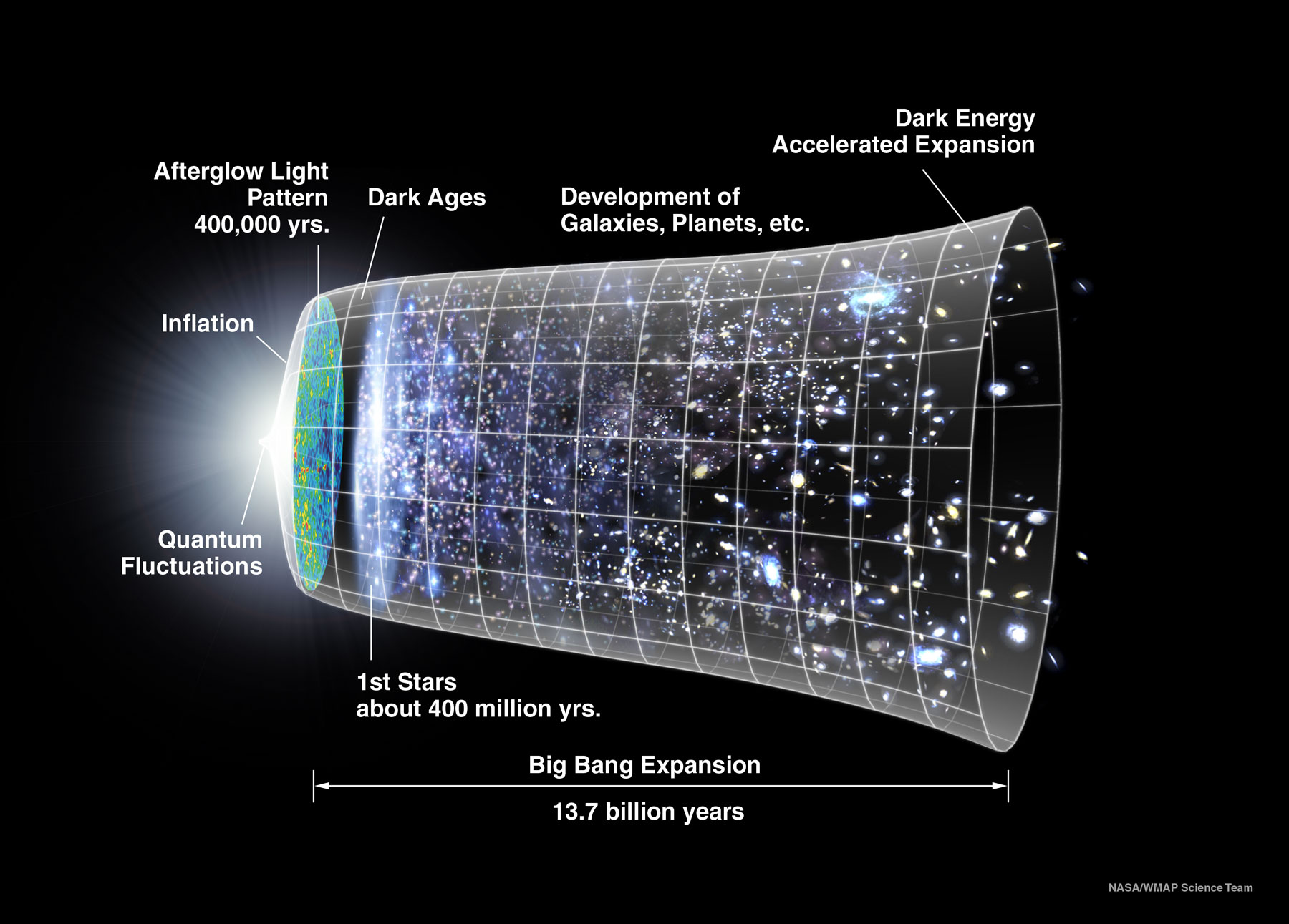
An illustrated timeline of the universe. Credit: WMAP | + Expand image
As light from distant objects travels to Earth, the universe continues to expand, something it’s been doing since the Big Bang. The waves that make up the light get stretched as the universe expands. You can see this effect in action by making an ink mark on a rubber band and observing how the mark stretches out when you pull on the rubber band.

Light waves get stretched as the universe expands similar to how this ink mark stretches out as the elastic is pulled. Get students modeling and exploring this effect with this standards-aligned math lesson. Credit: NASA/JPL-Caltech | + Expand image
What this means for light coming from distant galaxies is that the visible lightwaves you would be able to see with your eyes get stretched out so far that the longer wavelengths shift from visible light into infrared. Scientists refer to this phenomenon as redshift – and the farther away an object is, the more redshift it undergoes.
Webb telescope’s infrared sensing equipment will give scientists the chance to study some of the earliest stars that exploded in supernova events, creating the elements necessary to build planets and form life.
Gathering Light
The first stars were massive, their life cycles ending in supernova explosions. The light from these explosions has traveled so far that it is incredibly dim. This is due to the inverse square law. You experience this effect when a room appears to get darker as you move away from a light source.
To see such dim light, the Webb telescope needs to be extremely sensitive. A telescope’s sensitivity, or its ability to detect faint signals, is related to the size of the mirror it uses to gather light. On the Webb telescope, 18 hexagonal mirrors combine to form a massive primary mirror that is 21 feet (6.5 meters) across.
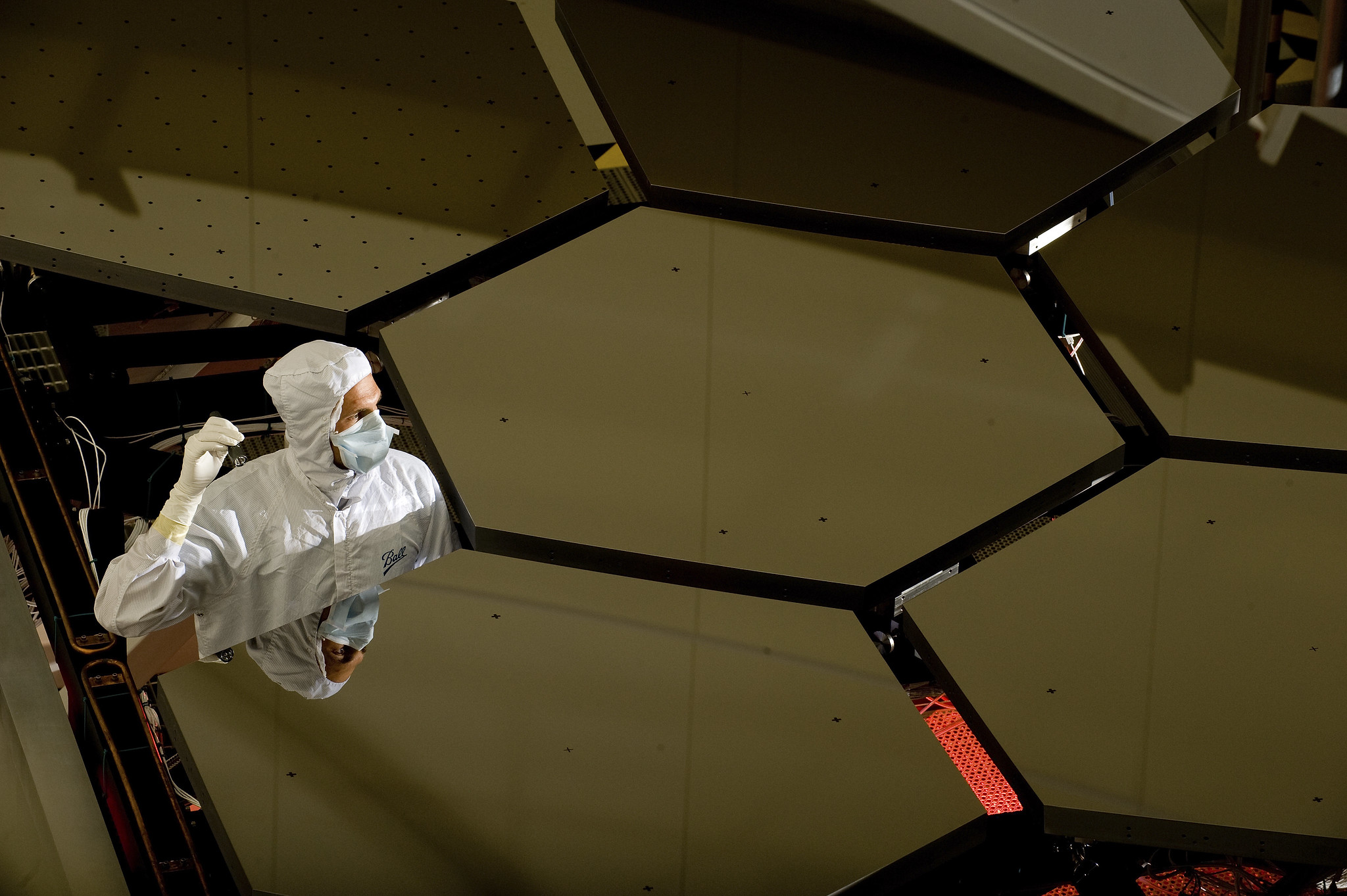
A technician inspects the Webb telescope's honeycomb-shaped mirror. The telescope's primary mirror is 21 feet (6.5 meters) across and is made up of 18 smaller hexagonal mirrors that must fold for launch and unfurl after the telescope reaches its orbit in space. Credit: NASA/MSFC/David Higginbotham/Emmett Given | › Full image and caption | + Expand image
Compared with the Hubble Space Telescope’s eight-foot (2.4 meter) diameter mirror, this gives the Webb telescope more than six times the surface area to collect those distant particles of light known as photons. Hubble’s famous Ultra Deep Field observation captured images of incredibly faint, distant galaxies by pointing at a seemingly empty spot in space for 16 days, but the Webb telescope will be able to make a similar observation in just seven hours.
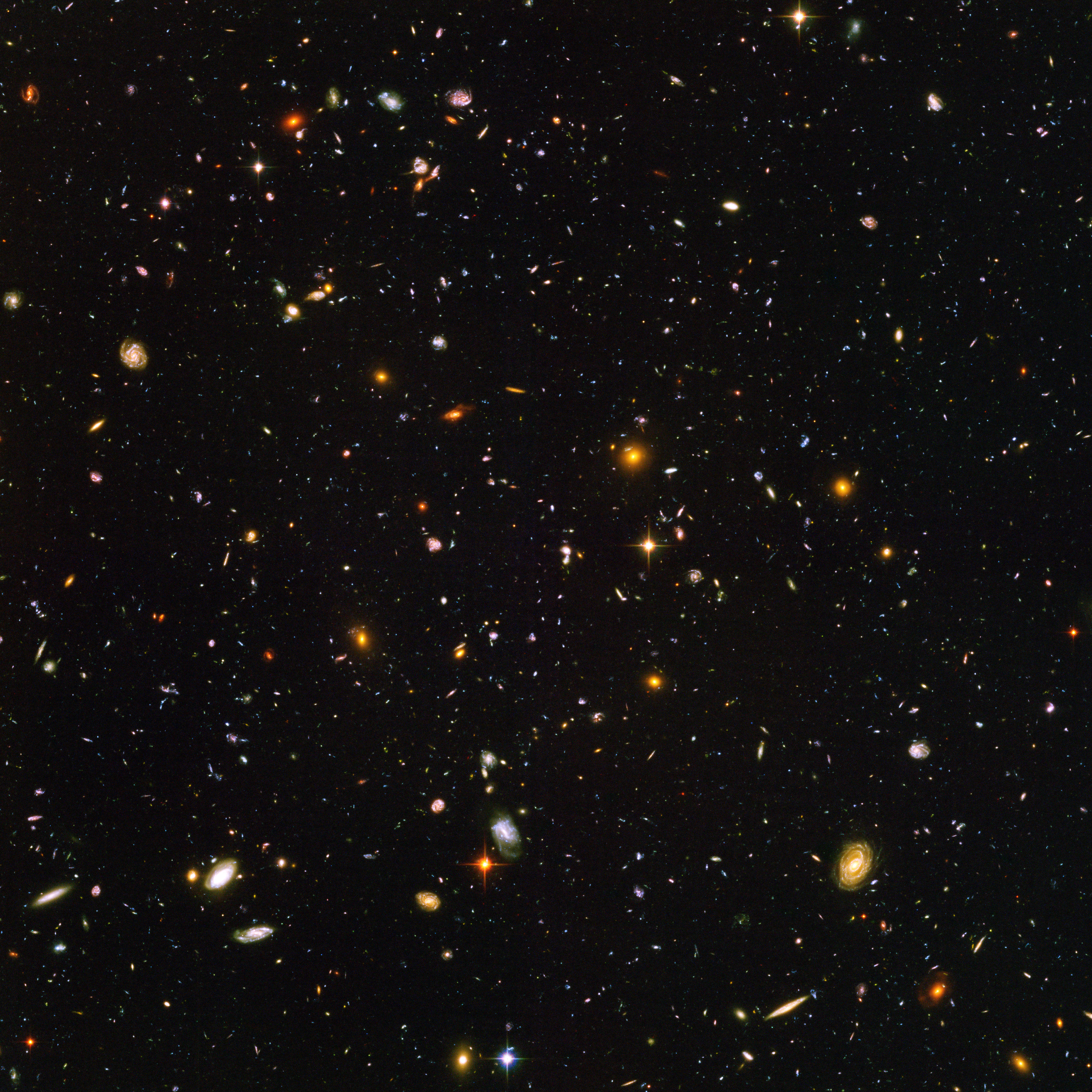
This image, called the Hubble Ultra Deep Field, shows 28 of the more than 500 young galaxies that existed when the universe was less than 1 billion years old. Credit: NASA, ESA, R. Bouwens and G. Illingworth (University of California, Santa Cruz) | › Full image and caption | + Expand image
Keeping Cool
The Webb Telescope gathers its scientific data as infrared light. To detect the faint signals of objects billions of light years away, the instruments inside the telescope have to be kept very cold, otherwise those infrared signals could get lost in the heat of the telescope. Engineers accounted for this with a couple of systems designed to get the instruments cold and keep them cold.
The Webb telescope's orbit around the Sun – sitting about 1 million miles (1.5 million kilometers) from Earth at Lagrange point 2 – keeps the spacecraft pretty far from our planet's heat, but even that’s not enough. To further reduce the temperature on the instruments, the spacecraft will unfurl a tennis-court-size sunshield that will block light and heat from the Sun, Earth, and Moon using five layers of specially coated material. Each layer blocks incoming heat, and the heat that does make it through is redirected out of the sides of the sunshield. Additionally, the vacuum between each layer provides insulation.

The sunshield is made up of five layers of specially coated material designed to block the Webb telescope's sensitive instruments from incoming heat from the Sun, Earth, and Moon. This photo, taken in the cleanroom at Northrop Grumman in Southern California in December 2020, shows the sunshield fully deployed and tensioned as it will be in space. Credit: NASA/Chris Gunn | › Full image and caption | + Expand image
The sunshield is so effective that the temperatures on the Sun-facing side of the telescope could be hot enough to boil water, while on the side closest to the instruments, the temperature could be as low as -394 F (-237 C, 36 K).
That’s cold enough for the near-infrared instruments to operate, but the Mid-Infrared Instrument, or MIRI, needs to be even colder. To bring down the temperature of MIRI, the Webb telescope is equipped with a special cryocooler that pumps chilled helium to the instrument to reduce its operating temperature to about -448 F (-267 C, 6 K).
Spotting Exoplanets
The Webb telescope will search for exoplanets using two different methods.
Using the transit method, the Webb telescope will look for the regular pattern of dimming that occurs when an exoplanet transits its star, or passes between the star and the telescope. The amount of dimming can tell scientists a lot about the passing exoplanet, such as the size of the planet and its distance from the star.

This animation shows how the transit method is used to hunt for planets outside our solar system. When exoplanets transit their parent star, the Webb telescope (like the Kepler space telescope, depicted here) will be able to detect the dip in the star’s brightness, providing scientists with key information about the transiting exoplanet. Students can see this technique in action with this transit math problem. Credit: NASA/JPL-Caltech | + Expand image
The second method the Webb telescope will use to search for exoplanets is direct imaging – capturing actual images of planets beyond our solar system. To enable direct imaging of exoplanets, the Webb telescope is equipped with a coronagraph. Just like you might use your hand to block a bright light, a coronagraph blocks starlight from reaching a telescope’s instruments, allowing a dim exoplanet orbiting a star to be seen.
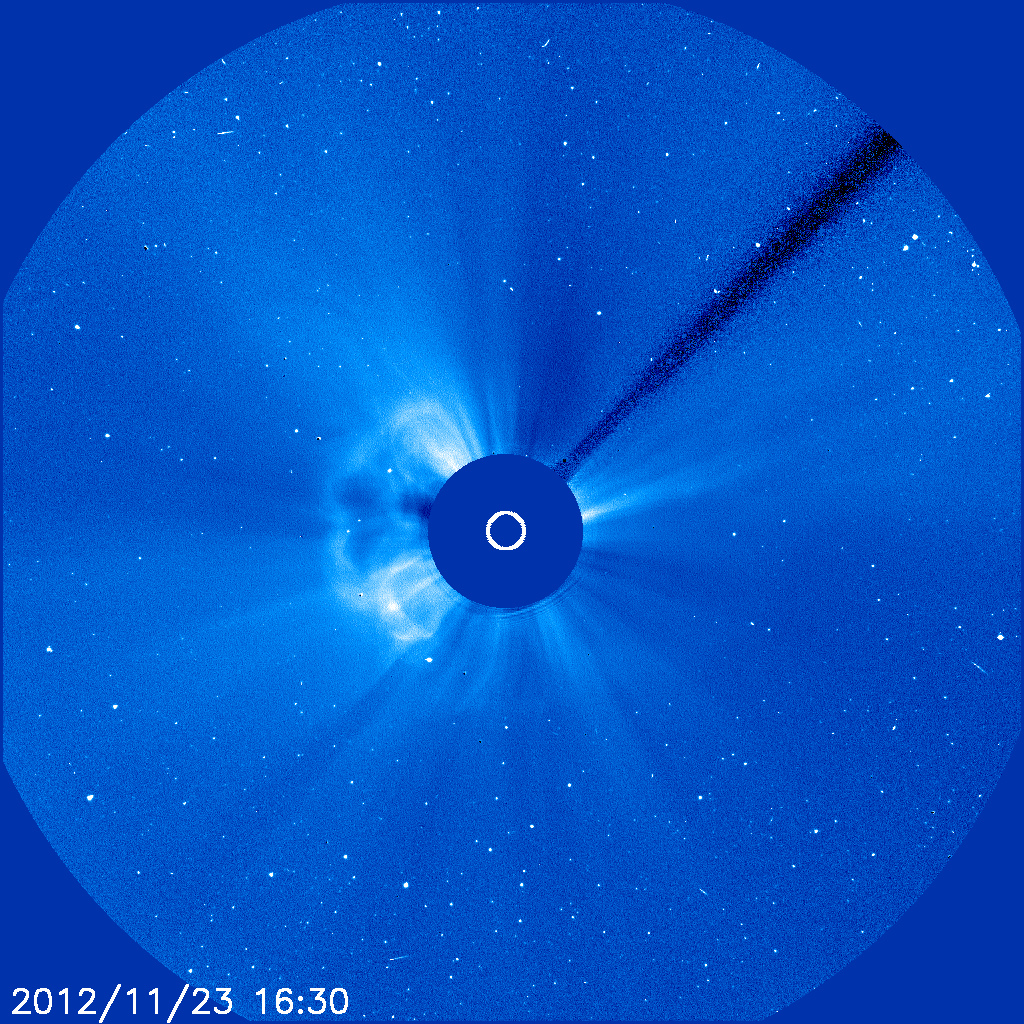
This “coronagraph” image taken by the Solar and Heliospheric Observatory, or SOHO, shows dim features around our Sun. Similarly, direct images of exoplanets captured by the Webb telescope will reveal details normally washed out by the brightness of stars. Credit: ESA&NASA/SOHO | › Full image and caption | + Expand image
The Webb telescope can uncover even more using spectroscopy. Light from a star produces a spectrum, which displays the intensity of light at different wavelengths. When a planet transits its star, some of the light from the star will pass through the planet's atmosphere before reaching the Webb telescope. Since all elements and molecules, such as methane and water, absorb energy at specific wavelengths, spectra from light that has passed through a planet’s atmosphere may contain dark lines known as absorption lines that tell scientists if there are certain elements present.
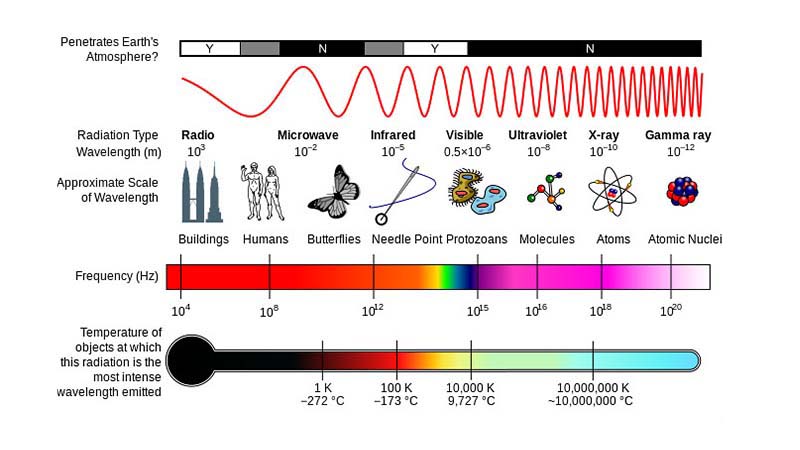
By looking at the unique spectrum produced when the light from a star shines through the atmosphere of a transiting exoplanet, scientists can learn whether certain elements are present on that planet. Credit: NASA | + Expand image
Using direct imaging and spectroscopy, scientists can learn even more about an exoplanet, including its color, seasons, rotation, weather, and vegetation if it exists.
All this could lead scientists to the ultimate exoplanet discovery: an Earth-size planet with an atmosphere like ours in its star’s habitable zone – a place where liquid water could exist.
Setting Up in Space
The Webb telescope will launch from French Guiana on top of an Ariane 5 rocket, a massive rocket capable of lifting the telescope, which weighs nearly 14,000 pounds (6,200 kilograms), to its destination.
The telescope's large mirror and giant sunshield are too big to fit inside the 18-foot (5.4-meter) wide rocket fairing, which protects the spacecraft during launch. To overcome this challenge, engineers designed the telescope's mirror and sunshield to fold for launch.
Two sides of the mirror assembly fold back for launch, allowing them to fit inside the fairing. The sunshield, which is 69.5 feet (21 meters) long and 46.5 feet (14 meters) wide, is carefully folded 12 times like origami so that it's narrow enough for launch. These are just two examples of several folding mechanisms needed to fit the massive telescope in its rocket for launch.
It will take about a month for the Webb telescope to reach its destination and unfurl its mirrors and sunshield. Scientists need another five months to cool down the instruments to their operating temperatures and align the mirrors correctly.
Approximately six months after launch, checkouts should be complete, and the telescope will begin its first science campaign and science operations.
Learn more and follow along with the mission from launch and unfolding to science observations and discovery announcements on the James Webb Space Telescope website.
Teach It
Check out these resources to bring the real-life STEM behind the mission into your teaching with lesson guides for educators, projects and slideshows for students, and more.
Educator Guides
Student Activities
Articles for Students
- What is the James Webb Space Telescope?
- What is the Big Bang?
- What is a galaxy?
- What is a satellite galaxy?
- What is a transit?
- What is a black hole?
- What is a light year?
- What is a nebula?
- What is an exoplanet?
- How many solar systems are in our galaxy?
- How old are galaxies?
- What is a supernova?
- Explore the electromagnetic spectrum
Videos for Students
- Space Place in a Snap: The Solar System’s Formation
- Space Place in a Snap: Searching for Other Planets Like Ours
Resources for Educators and Parents
Events
Explore More
- Mission Website: James Webb Space Telescope
- Photos: James Webb Space Telescope
- Videos: James Webb Space Telescope
- Facts & Figures: Mid-Infrared Instrument (MIRI)
NASA's Universe of Learning materials are based upon work supported by NASA under award number NNX16AC65A to the Space Telescope Science Institute, working in partnership with Caltech/IPAC, Center for Astrophysics | Harvard & Smithsonian, and the Jet Propulsion Laboratory.
TAGS: JWST, James Webb Space Telescope, electromagnetic spectrum, exoplanets, universe, solar system, big bang, cosmology, astronomy, star formation, galaxy, galaxies, telescope, life, technology, MIRI, Mars, Engineering, Teaching, Education, Classroom, Science, Universe of Learning
Meet JPL Interns | September 21, 2021
On the Fast Track to Career in STEM
A master's student and JPL intern at 19, Natalie Deo has her sights set on a career at the Laboratory, and she's out to prove it's never too early to pursue your dreams.
To hear Natalie Deo explain why she wanted to leave high school at the age of 14 and go straight into higher education is to hear it from the perspective of a precocious teenager wise beyond her years – and her peers.
“I was walking to first period in high school and I saw a couple making out and I was like, ‘I’m getting out of here. I don’t want to see that,’” Deo, now 19 and a summer intern at NASA’s Jet Propulsion Laboratory, deadpans.
Not that she hadn’t thought about fast-tracking it out of high school before that moment, of course. Deo, who grew up in Downey, California, was already familiar with the highly selective Early Entrance Program, or EEP, at Cal State University, Los Angeles that puts gifted students on an accelerated path toward college admission, and she had taken the ACT while in eighth grade. After finishing ninth grade, she was one of a handful of high-school students selected to start her undergraduate studies in electrical engineering at Cal State L.A.
“I was tired of being around people who weren’t as motivated. People were begging me to do their homework or trying to pay me to write their essays,” she says. “While that wasn’t the case with all my peers and some were even really supportive, it was cool to go to college and be around more people who are like-minded.”
Now, Deo is pursuing her master's degree in astronautical engineering at USC while interning at JPL with the team developing the Europa Clipper spacecraft. These days, one could say Deo is constantly surrounded by like-minded folks.
“USC is near home and near JPL, and JPL has been my dream since I knew I wanted to work in space,” Deo says.
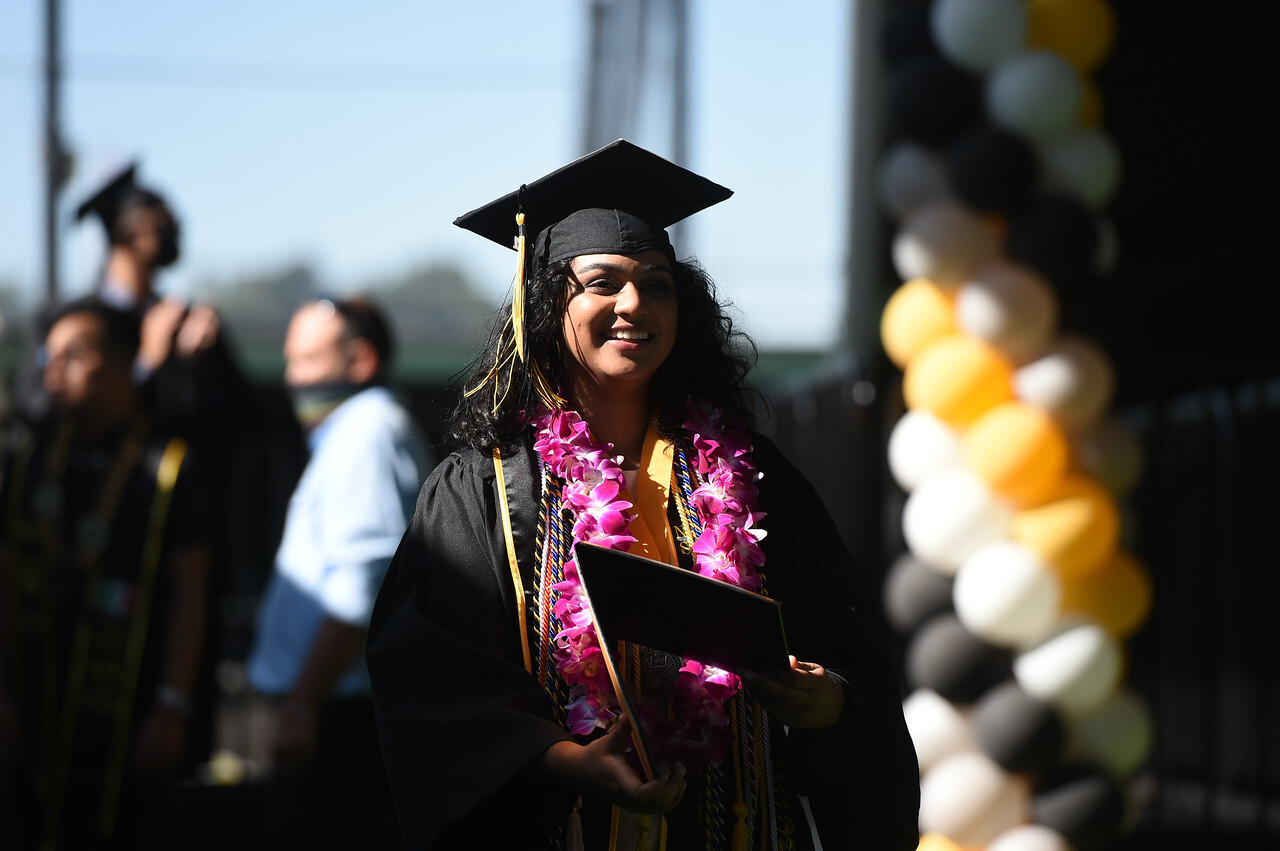
Deo at her graduation from California State University, Los Angeles. Image courtesy Natalie Deo | + Expand image
The Early Years
Deo first realized she “really, really loved space” at 13 after winning a telescope from a raffle at the Columbia Memorial Space Center in Downey, and found herself looking up at the Moon every night. Shortly after, she started volunteering at the space center every weekend, helping host field trips and robotics labs for young visiting students (something she still does to this day).
During this time, Deo was introduced to a middle-school STEM engineering class when she was in seventh grade.
“My teacher reached out to me and said, ‘You might enjoy it,’ and I thought, ‘Well, it’s either this or band,’” she says.
Deo tried the class, which introduced basic engineering concepts the first year revolving around design, modeling, and the engineering process. The second year focused on automation and robotics, and put students’ skills to the test in regional competitions.
“Before I realized it, I was spending every day after school working in robotics,” she says.
By the time she entered high school, nothing fascinated her more.
“High school was pretty easy for me and what we were learning didn't intrigue me as much as engineering,” Deo says.
Once Deo decided to formally enter EEP, she had to participate in a rigorous summer academy where students are evaluated by college admissions staff on whether they’re performing at a college level. In Cal State L.A.’s program, approximately 500 to 1,000 students apply each year and only about 20 to 30 students are admitted.
Deo was on a road trip with her mother and grandmother when she got the acceptance call.
“I was screaming, and my mom had to pull over because she was screaming,” Deo says. “My brother and dad were at home, and I called them and they were screaming on the phone. There was a lot of screaming.”
Looking back on her time in the summer academy, Deo marvels at the odds she overcame to gain admission.
“I didn’t realize it during that summer, but I was not like most students there whose parents had PhDs and were established in their fields,” she says. “I had parents who immigrated from Fiji. My mom came [to the U.S.] at 8 and my dad came at 22 without a college education. I grew up in a poor area compared to a lot of these students, and I didn’t have the resources to prepare for college that a lot of other students did. I also have Type 1 diabetes. It was special to me [to be accepted into the program] because here was this girl facing adversities of every kind – and she made it.”
While the decision to leave high school was an easy one, arriving at college left Deo grappling with imposter syndrome.
“The first year, I just took general education classes with my cohort [of EEPs] who help you transition, and I was just having fun with them,” Deo says. “Then it kicked in. I had no idea how college worked – my brother was still a senior in high school at the time. I was seeing all these people who were so smart and who came from very affluent backgrounds and who were into literature and stuff like that. I was never really into that. People just knew things I didn’t know and I thought, ‘Should I know that? Do I belong here?’”
Deo credits therapy, talking to friends, and turning to family as ways she coped with getting through those challenging early months. She also still stayed in touch with her childhood friends and took in the high-school experience while in college.
“I still went to prom, football games, and hung out with my friends all the time,” she says. “I was able to have the best of both worlds.”
JPL Internship, Mentorship, and Beyond
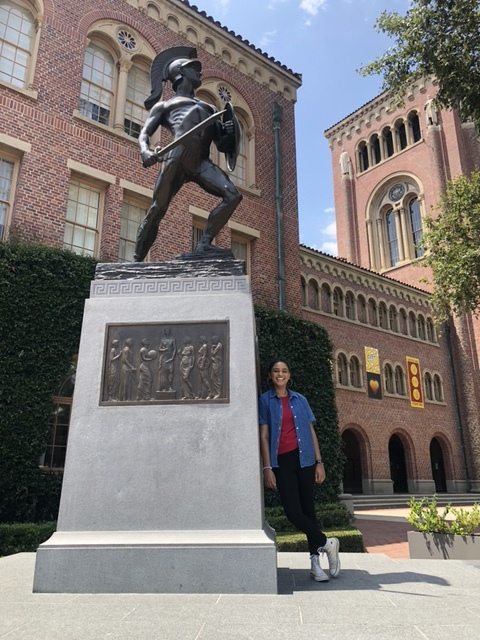
Deo poses for a picture on the USC campus, where she's pursuing her master's degree in astronautical engineering. Image courtesy Natalie Deo | + Expand image
At JPL, whispers of a 19-year-old summer intern getting her master’s haven’t fazed Deo in the slightest.
“I hosted an intern party the other week, and everyone coming in was like, ‘Are you the one who’s 19 and in grad school?’ And I’m like, ‘Yeah, that’s me, but I’m also Natalie and I have a Lego collection,’ she says with a laugh.
Deo’s intern responsibilities go beyond her years, of course. So far this summer, she’s spent it working on validating and verifying commands being sent to Europa Clipper’s computer system, ensuring the spacecraft’s instruments respond correctly to commands.
While she admits she still struggles with imposter syndrome in the workplace, she’s becoming more and more comfortable as the months go by and she grows closer to her fellow interns.
“The ratio of women to men is much greater here than in my previous internships,” she says. “I see more of myself in the people around me, and that helps me be able to interact with other interns and have them as a support group. I’m hanging out with them every weekend, and I’ve made lifelong friends already.”
Deo is also part of JPL’s Employee Resource Group, or ERG, mentorship program, which paired her up with a secondary mentor – one who supports a mentee outside of the mentorship their manager provides – through JPL's Advisory Council for Women, or ACW.
“This type of mentorship is based on career and academic advice, and to help interns develop their soft skills,” explains Alona Dontsova, who spearheads the program for Human Resources at JPL. “If the manager is concentrating on developing technical skills and how to manage projects, the ERG mentors are helping with networking, looking at their resume, listening to their pitches, or giving them more professional development advice. The ERG mentor is also more focused on teaching interns about the JPL culture.”
Deo’s secondary mentor, Lynn Boyden, is “very glad that the planets aligned that way” for the two of them to be paired up, and is a firm believer that mentoring is a two-way street.
“Learning goes in both directions … and one of the ways we do that is by sharing knowledge across these divides,” she says. “Sometimes there are situations that are beyond an intern’s ability to navigate the institutional practices, and this is where having a mentor with deeper experience in the world of business can be helpful. Also, one of the primary functions of an internship is to help an intern build a professional network, and having another designated person at JPL can only help them extend that network.”
For Deo’s part, she’s thrilled to have someone she can be candid with.
“I can have conversations about JPL that might be intimidating to ask my group supervisor,” she says. “Like, ‘How do I say please hire me without saying please hire me?’”
Deo isn’t shy about her next set of goals, which include being hired through JPL's academic part-time program while she completes her master’s. And while the virtual internship experience has been a challenge for her, “I really enjoy hands-on work,” she says. Deo has felt the rewards of her internship and mentorship every day.
“Honestly, everything has been rewarding: the people, the experiences, and everything I’ve learned,” she says. “I’m motivated by passion and doing what I love, and I’m doing what I love.”
The laboratory’s STEM internship and fellowship programs are managed by the JPL Education Office. Extending the NASA Office of STEM Engagement’s reach, JPL Education seeks to create the next generation of scientists, engineers, technologists and space explorers by supporting educators and bringing the excitement of NASA missions and science to learners of all ages.
Career opportunities in STEM and beyond can be found online at jpl.jobs. Learn more about careers and life at JPL on LinkedIn and by following @nasajplcareers on Instagram.
TAGS: Internships, College Students, Europa Clipper, Europa, Engineering, Intern, Higher Education
Edu News | September 9, 2021
JPL Internship Program Expanding Diversity in STEM
Five years in, a JPL initiative forging relationships with students and faculty at historically Black colleges and universities continues expanding its reach, hosting 48 interns this year.
Brandon Ethridge, a flight systems engineer at NASA’s Jet Propulsion Laboratory in Southern California, has had a year to remember. The 24-year-old got engaged, became a father, and is celebrating the one-year anniversary of starting full time at JPL – his self-described dream job.
“Definitely the most eventful year of my life,” Ethridge said.
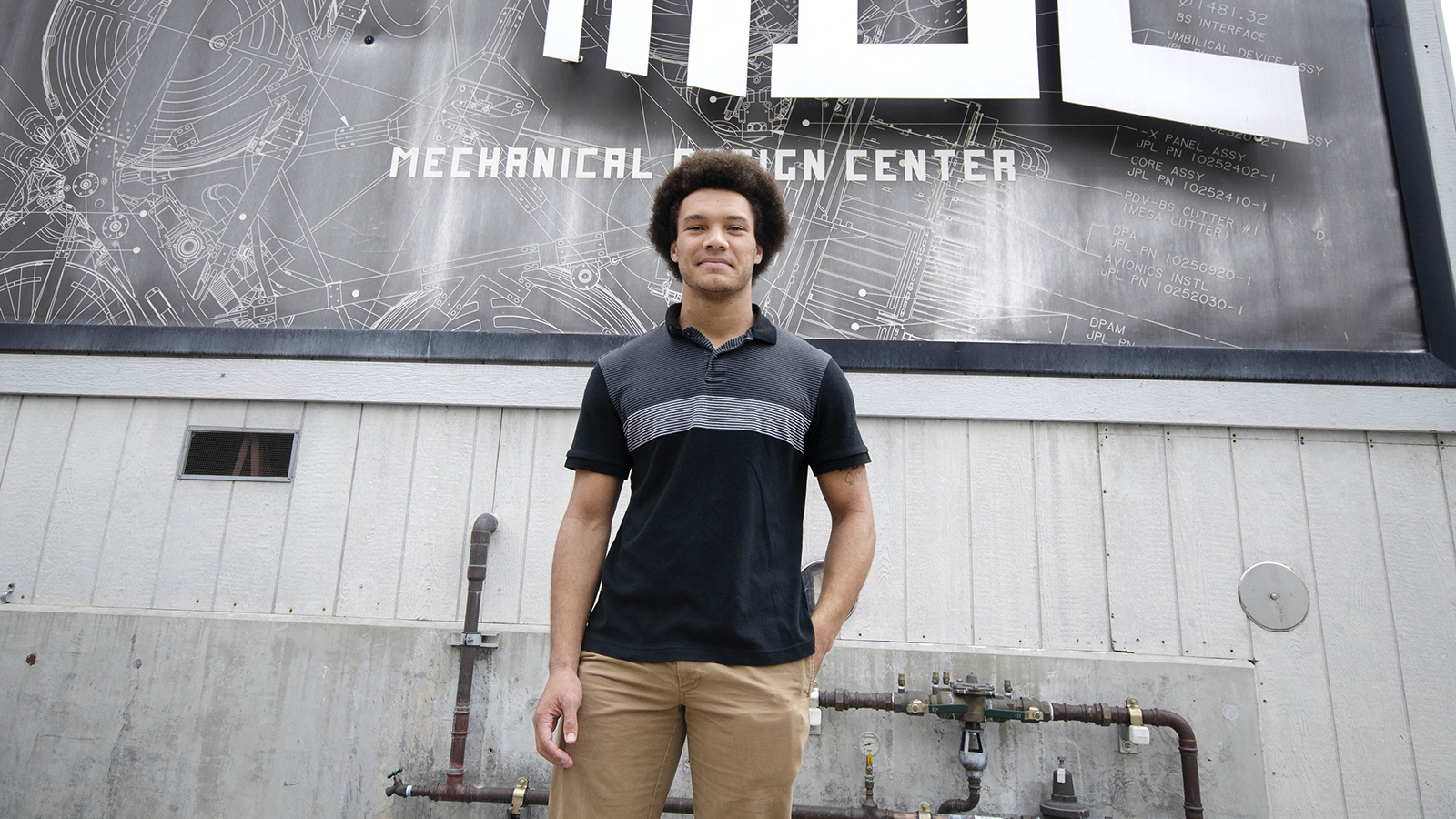
Brandon Ethridge poses in front of the Mechanical Design Center at JPL during his internship in 2019. Image credit: NASA/JPL-Caltech/Kim Orr | + Expand image
While he’s been gaining experience testing systems used to build spacecraft, Ethridge has spent minimal time at the Laboratory due to the pandemic. But the North Carolina native already had plenty of first-hand knowledge of JPL thanks to his summer 2019 internship – an opportunity that presented itself at a JPL informational session that spring at his alma mater, North Carolina A&T State University.
“That allowed me the chance to speak one-on-one with Jenny Tieu and Roslyn Soto [JPL Education project managers],” Ethridge said. “They were incredibly generous with their time and provided resume critiques, feedback, and general advice about how to get an opportunity at JPL.”
Since 2017, Tieu has been leading JPL’s Historically Black Colleges and Universities/Underrepresented Minorities, or HBCU/URM, initiative – an effort to increase and foster a more diverse workforce in technical roles at the Laboratory. It’s one of many programs facilitating the more than 550 internship opportunities offered through the Education Office this year.
Now in its fifth year, the program has seen rapid growth; from seven interns in its first year, to 24 interns in 2020. This year, JPL is welcoming 48 students interning remotely from institutions including Howard, North Carolina A&T, Tuskegee, and Prairie View A&M universities, along with underrepresented-minority students from universities including UCLA, USC, UC Riverside, Duke, Cal Poly Pomona, and more.
The initiative includes funding and support to bring in faculty from the schools to take part in research with the students, building in a cohort model that facilitates sustainable interactions with JPL.
“We’re intentional about addressing the culture shock that some of these students may experience,” Tieu said. “With the cohort model, the faculty members can provide guidance to the students while they are navigating new relationships, connections, and a new city.”
Additionally, interns are invited to participate in roundtable conversations in groups where they can share concerns and openly discuss their experiences at JPL. Tieu has also set up virtual meet-ups where students can get to know employees from outside their groups and hear talks from members of JPL’s Black Excellence Strategic Team and past HBCU alumni.
For Ethridge, being in a position to give back to the program was something he prioritized.
“I wanted to repay some of the many kindnesses that were afforded to me,” Ethridge said. “I also feel that I am in a unique position because I just recently went through the process.”
For Howard University junior Kyndall Jones, the draw to JPL came following a fellow student’s acceptance into the program.

Kyndall Jones at the NASA Armstrong Flight Research Center. Image courtesy: Kyndall Jones | + Expand image
“I was so amazed that he had an internship with NASA, and it really sparked my interest,” Jones said. “After doing my research on the program, I submitted my resume and heard back after a few months, landed an interview, and now here I am [virtually]!”
Despite the telework nature of this summer’s internship, Jones said that even from her home in Dayton, Ohio, she has been able to foster connections with JPL employees and gain valuable experience in her role working on software for an Earth-science instrument that will help NASA understand how different types of air pollution, which can cause serious health problems, affect human health.
And thanks to her mentor, Operations Systems Engineer Janelle Wellons, Jones was able to get the type of hands-on NASA experience that’s been hard to come by since the pandemic.
“My mentor Janelle suggested that I come visit Los Angeles for a few days this summer, and I was finally able to visit and explore the city for the first time,” Jones said. “I am also super grateful for her setting up a tour at the NASA Armstrong Flight Research Center where we were able to view, tour, and learn lots of interesting facts about NASA’s historical aircraft.”
Wellons – who splits her time operating instruments aboard several Earth-observing missions – had been involved in previous years’ roundtable discussions with HBCU interns, but this year, she had the opportunity to hire her own interns through the program. Being from the East Coast herself, Wellons remembers having little awareness of JPL as a potential career landing spot while studying at Massachusetts Institute of Technology.
“Getting visibility and actually partnering with these schools to make these internships happen is so important,” Wellons said. “Actively interacting with HBCUs is only going to do good for people we would otherwise potentially never get an application from, and it benefits JPL by broadening the talent pool and diversity of our workforce.”
As for the future, Jones sees the initiative as one step of many for her and fellow interns toward careers in engineering and science.
“I know a lot of Howard students that are interning or have interned with JPL, and the love from our College of Engineering and Architecture is especially high,” Jones said. “The info sessions, resume workshops, and networking workshops that JPL has been able to put on have been great, and the more they can do, the better for students.”
Tieu agrees, adding, "We are happy to see the growth of the initiative but look forward to making further progress. There's so much more we would like to accomplish in the years ahead."
To learn more about the HBCU/URM initiative and apply, see the Maximizing Student Potential in STEM program page. The HBCU/URM initiative resides within this program.
This Q&A is part of an ongoing series highlighting the stories and experiences of students and faculty who came to JPL as part of the laboratory's collaboration with historically black colleges and universities, or HBCUs. › Read more from the series
The laboratory’s STEM internship and fellowship programs are managed by the JPL Education Office. Extending the NASA Office of STEM Engagement’s reach, JPL Education seeks to create the next generation of scientists, engineers, technologists and space explorers by supporting educators and bringing the excitement of NASA missions and science to learners of all ages.
Career opportunities in STEM and beyond can be found online at jpl.jobs. Learn more about careers and life at JPL on LinkedIn and by following @nasajplcareers on Instagram.
TAGS: HBCU, Internships, College Students, Faculty, Research, Careers, Earth Science, Black History Month, Engineering, Intern, Higher Education
Career Guidance | August 19, 2021
How to Get an Internship at JPL
Whether you're looking for a career in STEM or space exploration, this three-part series will cover everything you need to know about the world of internships at NASA's Jet Propulsion Laboratory, the skills and experience hiring managers are looking for, and how you can set yourself on the right trajectory even before you get to college.
In a typical year, NASA's Jet Propulsion Laboratory brings in about 1,000 interns from schools across the country to take part in projects that range from building spacecraft to studying climate change to developing software for space exploration. One of 10 NASA centers in the United States, the Southern California laboratory receives thousands of applications. So what can students do to stand out and set themselves on the right trajectory?
We asked interns and the people who bring them to JPL about their tips for students and anyone interested in a STEM career or working at the Laboratory. We're sharing their advice in this three-part series.
First up: Learn about the kinds of opportunities available as well as where and how to apply.
The World of JPL Internships
If you found this article, you're probably already somewhat familiar with the work that goes on at JPL. But at a place that employs more than 6,000 people across hundreds of teams, it can be hard to keep track of it all.
In a broad sense, JPL explores Earth, other planets, and the universe beyond with robotic spacecraft – meaning no humans on board. But along with the engineers and scientists who design and build spacecraft and study the data they return, there are thousands of others working on all the in-between pieces that make Earth and space exploration possible and accessible to all. This includes software developers, machinists, microbiologists, writers, video producers, designers, finance and information technology professionals, and more.
Some of the best ways to learn about the Laboratory's work – and get a sense for the kinds of internships on offer – are to follow JPL news and social media channels, take part in virtual and in-person events such as monthly talks, and keep up on the latest research. There are also a host of articles and videos online about interns and employees and the kinds of work they do.
While STEM internships make up the majority of the Laboratory's offerings, there are a handful of opportunities for students studying other subjects as well. Depending on which camp you fit into, there are different places to apply.
Education Office Internships
The largest number of internships can be found on the JPL Education website. These opportunities, for students studying STEM, are offered through about a dozen programs catered to college students of various academic and demographic backgrounds. This includes programs for students attending community college, those at minority-serving institutions, and others at Los Angeles-area schools.
Students apply to a program, or programs, rather than a specific opening. (See the program details for more information about where to apply and what you will need.) It's then up to the folks with open opportunities, the mentors, to select applicants who are the best match for their project.
It may seem odd to send an application into the void with no idea of what offer might return. But there is a good reason behind the process, says Jenny Tieu, a project manager in JPL's Education Office, which manages the Laboratory's STEM internship programs.
"Applying to a specific program allows for the applicant to be seen by a much broader group of hiring managers and mentors and be considered for more opportunities as a result," says Tieu. "We look at the resumes that come in to see what skills are compatible with open projects and then match students to opportunities they may not have even realized were available to them."
Shirin Nataneli says she wouldn't have known there was an internship for her at the Laboratory were it not for a suggestion to apply from her professor. In 2020, Nataneli graduated from UCLA with a Bachelor's degree in biology. She was on the pre-med track, studying for the MCAT, when she decided to take a couple of courses in computer science.
"I got sucked in," says the Santa Monica College student and JPL intern, who is using computer science to help her team classify extreme bacteria that can survive on spacecraft. "I didn't even know there was an intersection between computer science and biology, but somehow I found a group at JPL that does just that."
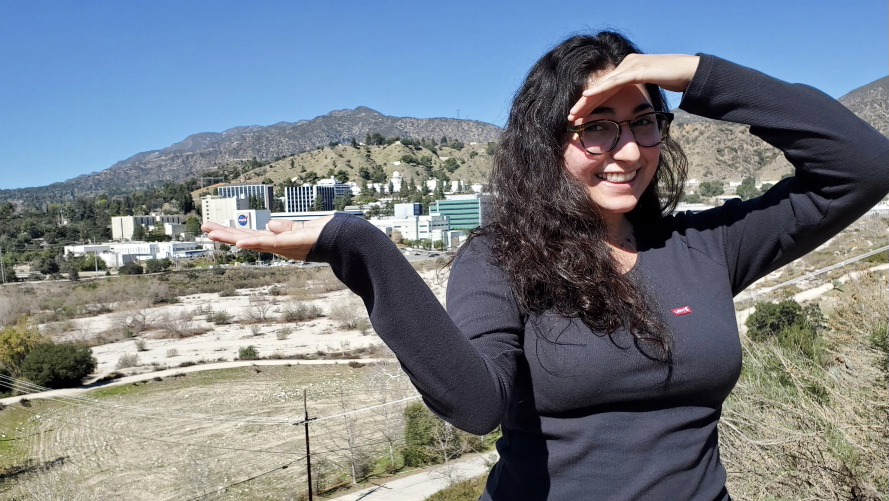
Shirin Nataneli poses for a photo with the JPL campus in the background. Image courtesy: Shirin Nataneli | + Expand image
University Recruiting Opportunities
For college students who are interested in space exploration but studying other fields, such as business, communications, and finance, as well as those studying STEM, there are additional opportunities on the JPL Jobs website. Listed by opportunity, more like a traditional job opening, these internships are managed by the Laboratory's University Recruiting team, which is active on LinkedIn and Instagram and can often be found at conferences and career fairs.
The When, What, and Where
Both Education Office and University Recruiting opportunities are paid and require a minimum 3.00 GPA, U.S. citizenship or legal permanent resident status, as well as an initial commitment of 10 weeks. Applicants must be enrolled in a college undergraduate or graduate program to be eligible. (See "The Pre-College Trajectory" section of this article below to learn about what high-school and younger students can do to prepare for a future JPL internship or STEM career.)
After pivoting to fully remote internships during the COVID-19 pandemic, JPL has continued to offer some remote or hybrid internships now that the Los Angeles-area campus has opened back up.
"We know that remote internships are effective," says Tieu. "Interns have said that they're able to foster connections with JPL employees and gain valuable experience even from home." She notes that while in-person internships give students maximum exposure to JPL – including visits to Laboratory attractions like mission control, the "clean room" where spacecraft are built, and a rover testing ground called the Mars Yard – remote internships have had a positive impact on students who previously weren't able to participate in person due to life constraints.
Most programs offer housing and travel allowances to students attending universities outside the 50-mile radius of JPL, so be sure to check the program details if traveling to or living in the Los Angeles area could be tricky financially.
Full-time and part-time opportunities can be found throughout the year with most openings in the summertime for full-time interns, meaning 40 hours per week. For summer opportunities, Tieu recommends applying no later than November or December. Applicants can usually expect to hear back by April if they are going to receive an offer for summer, but it's always a good idea to keep yourself in the running, as applicants may be considered for school-year opportunities.
Tieu adds, "If you haven't heard back, and you're closing in on the six-month mark of when you submitted your application, I recommend students go back in and renew their application [for the programs listed on the JPL Education website] so that it remains active in the candidate pool for consideration."
And unlike job applications, where it's sometimes frowned upon to apply to multiple positions at once, it's perfectly alright – and even encouraged – to apply to multiple internships.
You may also want to consider these opportunities, especially if you're looking for internships at other NASA centers, you're a foreign citizen, or you're interested in a postdoc position:
- NASA Internships
- JPL Visiting Student Researcher Program (international students eligible)
- JPL Postdoctoral Study
The most important thing is to not count yourself out, says Tieu. "If you're interested, work on that resume, get people to review your resume and provide input and feedback and apply. We don't expect students to come in knowing how to do everything. We're looking for students with demonstrated problem-solving, teamwork, and leadership skills. Software and other technical skills are an added bonus and icing on the cake."
More on that next, plus advice from JPL mentors on the skills and experience they look for from potential interns.
Skills for Space Explorers
JPL is known for doing the impossible, whether it's sending spacecraft to the farthest reaches of our solar system or landing a 2,000-pound rover on Mars. But potential applicants may be surprised to learn that reputation wasn't earned by always having the right answer on the first try – or even the second, third, or fourth.

JPL's founders, several Caltech graduate students led by Frank Malina along with rocket enthusiasts from the Pasadena area, take a break from setting up their experimental rocket motor in the Arroyo Seco, north of Pasadena, California. Image credit: NASA/JPL-Caltech | + Expand image
In fact, the Laboratory has always had a penchant for experimentation, starting with its founders, Caltech students who in the 1930s would test rockets in the stairwells at their university. They had so many colossal (and dangerous) failures that they were banished to a dry riverbed north of Pasadena, which is now the site of JPL. Eventually, their rockets were successful and the laboratory they founded went on to build and launch the first American space satellite and send dozens of spacecraft to worlds throughout the solar system. But that trial-and-error attitude still permeates the Laboratory today.
As a result, potential interns who show enthusiasm and a willingness to learn, overcome obstacles, and work as part of a team often stand out more than those with academic achievements alone.
Standing Out
In an informal survey of JPL mentors, respondents most often cited problem-solving, communication, and teamwork skills as well as passion for learning and grit as the soft skills they look for when considering potential interns. Respondents added that students who can provide specific examples of these skills on their resume – and speak to them in an interview – stand out the most.
That doesn't necessarily have to mean leading your school’s robotics club or serving as your geology professor's teaching assistant, although those things don't hurt. But also consider less traditional examples, such as how critical thinking helps you overcome challenges while rock climbing or how you used leadership and teamwork to organize your friends to create a group costume for Comic Con.
"Students who share a link to their GitHub repository or online portfolio stand out to me because it shows they took the initiative and took time to build, develop, and create something on their own," says K'mar Grant-Smith, a JPL mentor who leads a team of developers in supporting and maintaining applications for the Laboratory's missions. "That vouches for you better than saying, 'I know these [coding] languages, and I took these courses.'"
Laurie Barge is a JPL scientist who co-leads an astrobiology lab exploring the possibility of life beyond Earth. The lab annually hosts about a dozen students and postdocs. Barge says that the top qualities she looks for in an intern are an expressed interest in her research and JPL as a whole as well as teamwork skills. "I look for students who are excited about the fact that they'll be working with 10 other students and postdocs and collaborating with other people on papers and abstracts."

Astrobiologist Laurie Barge, left, and former intern Erika Flores, right, pose for a photo in the Origins and Habitability Lab that Barge co-leads at JPL. Image credit: NASA/JPL-Caltech | + Expand image
Teamwork is also key for students working in engineering, software, or any other capacity across the Laboratory. When it comes to designing missions to go where nothing has gone before, collaboration between multi-disciplinary teams is a must.
In terms of technical skills, knowledge of coding languages is the most sought after, with Python, MATLAB, and C languages leading the pack. And in certain groups, like the one that helps identify where it's safe to land spacecraft on Mars, experience with specialized tools like Geographic Information Systems, or GIS, can help applicants stand out.
Still, for many mentors, enthusiasm and a willingness to learn and be proactive are far more important than any technical skill.
"You don't have to be the most technically savvy person. If you have the initiative, the drive, and some experience, I find that to be more important than knowing 16 different [coding] languages," says Grant-Smith. "JPL is a unique place full of very smart people, but we're not good at what we do just because we have the know-how. We also have the drive and a passion for it."
Getting Involved
So you're a rock-climbing Red Planet enthusiast who likes to create "Dune"-inspired stillsuits when you're not busy at your part-time job making frappuccinos with your fellow baristas. How do you improve the chances this information will land on a JPL mentor's desk?
In a sentence: Build a strong network. So says Rebecca Gio of what made all the difference when she was struggling to find her academic groove right after high school. After a year spent repeating classes, changing schools, and feeling discouraged about what was next, Gio discovered what she needed to change her trajectory. She joined clubs and organizations that aligned with her career goals, formed study groups with her peers, found a mentor who could help her navigate everything from college classes to internship opportunities, and wasn't afraid to ask when she had a question.
Now, Gio is thriving – academically and on her career path. She's a junior studying computer science at Cal Poly Pomona and a first-time intern at JPL, where she's testing the software that will serve as the brains of a spacecraft designed to explore Jupiter's moon Europa.
"Being part of a community and being with people who have gone through similar experiences and can push you to do better, I think that that is just super motivating," says Gio.
JPL Education Program Manager Jenny Tieu agrees. “Along with academic achievements, we’re looking for students with diverse backgrounds, perspectives, and life experiences who can work collaboratively to learn, adapt to new situations, and solve problems.”
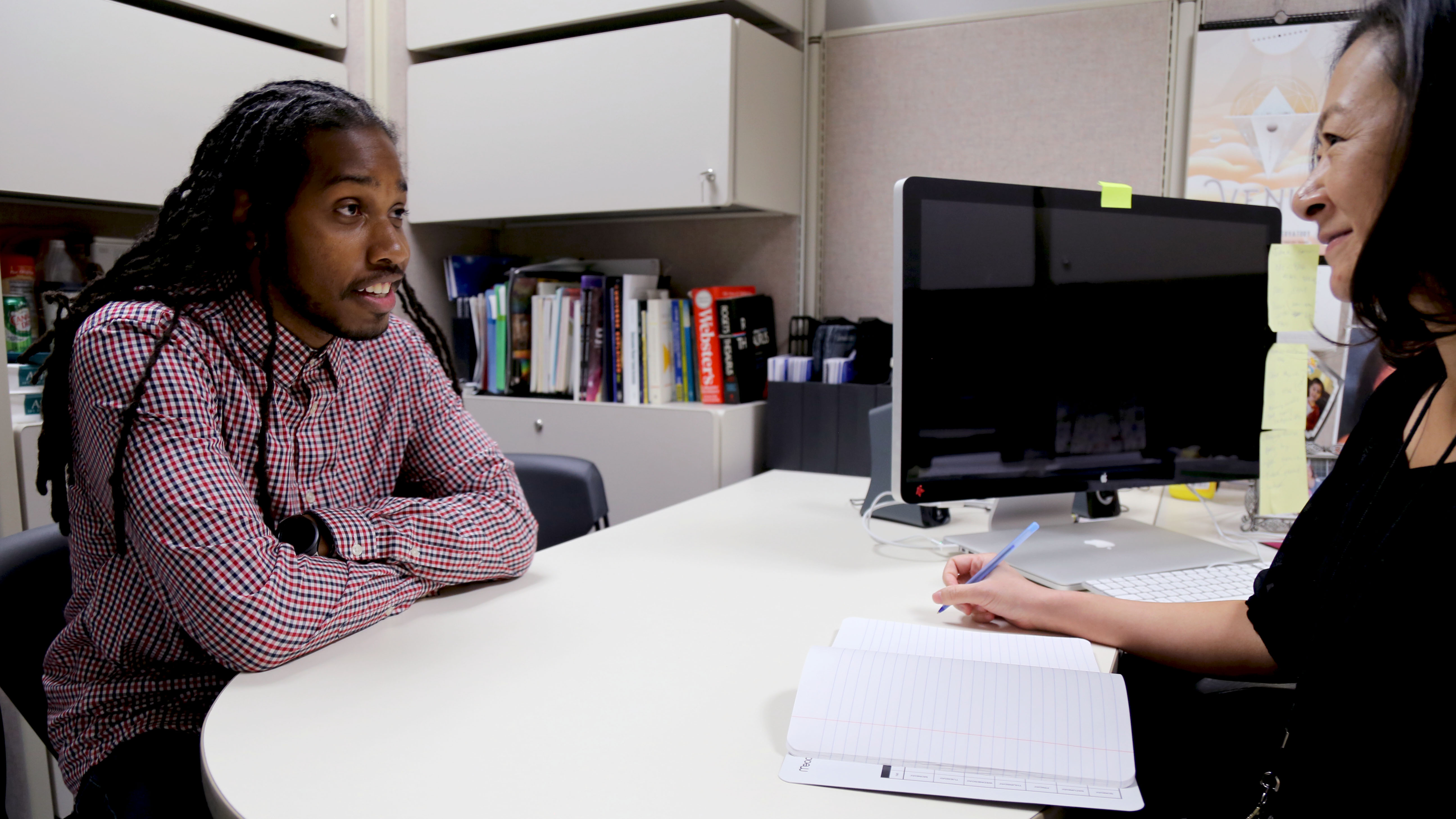
Jenny Tieu catches up with Brandon Murphy, who came to the Laboratory as an intern in 2016 through a program Tieu manages, and soon after, was hired full-time. Image credit: NASA/JPL-Caltech | + Expand image
To that end, she suggests students get involved in campus STEM clubs and communities, NASA challenges and activities, and volunteer opportunities, which offer career experiences, introduce students to a network of peers and professionals, and look great on a resume.
Tieu leads a JPL internship program that partners with historically Black colleges and universities and other minority-serving institutions. She says that one way students get connected with the program is by word-of-mouth from current and former participants, who include students and faculty researchers.
"We see a lot of great allyship with interns and research fellows telling their classmates about their experience at JPL, how to apply, and what to expect," says Tieu. "We foster deep relationships with our partner campuses and their faculty as well." In other words, students may not have to look farther than their own professors, campus info sessions, or career fairs to learn about opportunities at the Laboratory.
A career fair is where Gio first connected with JPL's University Recruiting team after what she jokingly calls "stalking" them from LinkedIn to Handshake to the Grace Hopper conference – where she eventually handed over her resume. "Just get familiar with where JPL is going to be and try to make sure that you're there," says Gio.
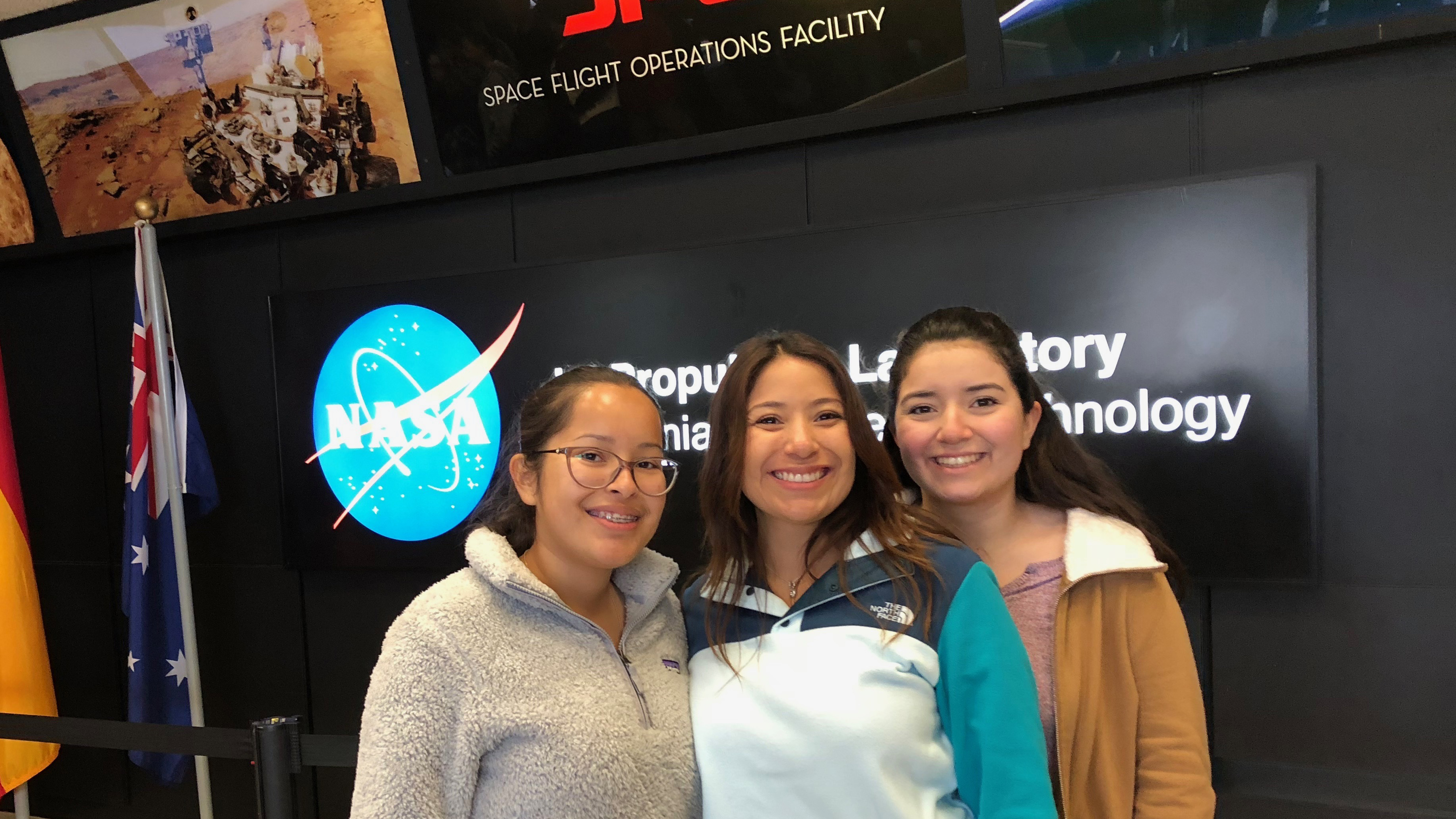
Rebecca Gio (right) poses for a photo with her mom and sister (left) in the lobby of the Laboratory's mission control building during the Explore JPL event in 2019. Gio says her mom and sister are her two biggest supporters and the reason behind all of her success. Image courtesy Rebecca Gio | + Expand image
In the sciences especially, those connections can also be made through a shared interest in a particular area of research. Barge says that most of the students she brings to JPL find out about her research from a peer or professor, exploring the lab's website, or from reading papers her team has published. Then, they reach out to her directly. This way she can create a position suited to a student's skills while also finding out if their interests mesh with the team.
"I want to know why they're interested in JPL and not a different institution," says Barge. "Why do they want to work with me and not another person at JPL? Why do they want to do this research and what specifically would they like to gain from this internship experience? I'm trying to figure out who really, really wants this particular opportunity."
As Gio points out, it's often the same advice that applies whether you're looking for an internship at JPL or in STEM or a future career.
"If you really want it, if you really want to be a STEM professional, make the most of your education, and find ways to apply those skills," says Gio. "I made sure that I was a part of campus groups where I was doing extra projects outside of schoolwork. I made sure that I was talking to other students to learn what they were doing. There's a lot of opportunities now to learn online for free. If there's something that you think would interest you, just go and do it."
Next, we'll share more ways students can prepare for a future internship or career in STEM before they get to college, plus resources parents and teachers can use to get younger students practicing STEM skills.
The Pre-College Trajectory
First, let's address one of the most common questions we get when it comes to internships at JPL. As of this writing, the Laboratory does not offer an open call for high-school interns. For most of the past several years, JPL has been able to bring in just a handful of high-school students from underserved communities thanks to partnerships with local school districts.
That's not to say that there won't be an open call for high-school internships at JPL in the future. If and when opportunities become available, they'll be posted here on the JPL Education website.
That said, there's still plenty students can and should do before college or when they're just entering college to explore STEM fields, get hands-on experience, and practice the skills they'll need for a future internship or career.
Exploring STEM Fields
Ota Lutz, a former classroom teacher, leads JPL's K-12 education team, which takes the Laboratory's science, engineering, and technical work and translates it into STEM education resources for teachers, students, and families.
Other than exploring high-school internships at other organizations, Lutz says that students in grades K-12 can get hands-on experience through clubs, competitions, and camps offered in person and online.
Schools often have engineering, robotics, math, and science clubs, but if not, look for one in your community or encourage students to start their own, perhaps with the help of a teacher.

JPL's Invention Challenge is an annual engineering competition for middle and high school students. In 2017, a team (pictured) traveled all the way from Ethiopia to participate. | › Read the news story
JPL hosts annual science and engineering competitions while NASA hosts a slew of other competitions, including essay contests with opportunities to interact with scientists and even name spacecraft.
If cost is an issue for camps or competitions, Lutz recommends that parents or guardians reach out to the host organization to see if scholarships are available and that they explore free events offered by groups such as NASA's Solar System Ambassadors and Night Sky Network as well as programs at museums, science centers, and libraries in their community.
NASA also offers a number of citizen science projects that give students (and adults) opportunities to contribute to real research, from identifying near-Earth asteroids to observing and cataloging clouds to searching for planets beyond our solar system.
Building Foundational Skills
All of the above can help students explore whether they might be interested in STEM, but it's also important that kids start practicing the skills they will need to succeed academically and in a future internship or career.
"Developing those foundational STEM and language arts skills is incredibly important to future success," says Lutz, adding that, generally, students should practice what are called scientific habits of mind, "learning how to think critically, problem solve and do so in a methodical way as well as learning to examine data to determine trends without personal bias."
One way students can gain skills and knowledge directly related to a future STEM internship or career is by trying these educational projects and activities offered free online from the JPL Education Office. (Teachers can explore this page to find out how to turn these activities into standards-aligned classroom lessons.) Activities include engineering projects and science experiments as well as math and coding challenges, all of which feature the latest NASA missions and science.
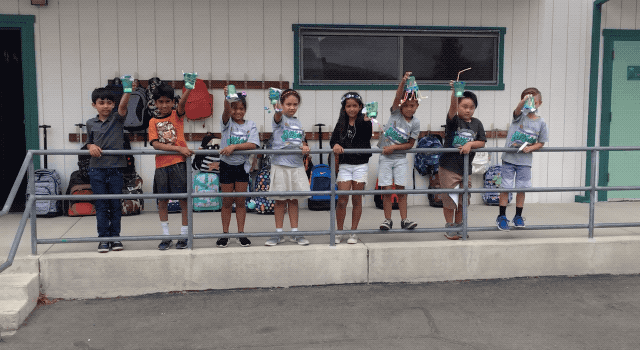
Students test their designs as part of the "Make an Astronaut Lander" activity on the JPL Education website. | + Expand image
Coding skills, in particular, will serve students well no matter what career path they take, says Lutz. "Coding is something that is applicable across a broad range of subject areas and majors, so we strongly encourage students to learn some coding."
She points to the plethora of online courses and tutorials in coding and other STEM subjects that give students a chance to explore on their own and work on projects that interest them.
Parents and guardians can also help their kids develop foundational skills by allowing them to explore and tinker at home. "In every house, there's something that needs fixing," says Lutz. "Have the kid figure out how to fix a wobbly chair, but be patient with mistakes and encourage them to keep trying." That persistence and determination in overcoming obstacles will come in handy throughout their education and career path, whether it's learning how to code, getting into a robotics club in high school, applying and reapplying for internships, or figuring out how to land a spacecraft on Mars.
Similarly, it's never too early to start learning those ever-important soft skills such as teamwork, communication, and leadership. There's no single or right place to gain these skills, rather they come from a range of experiences that can include a school project, a part-time job, or a volunteer opportunity.
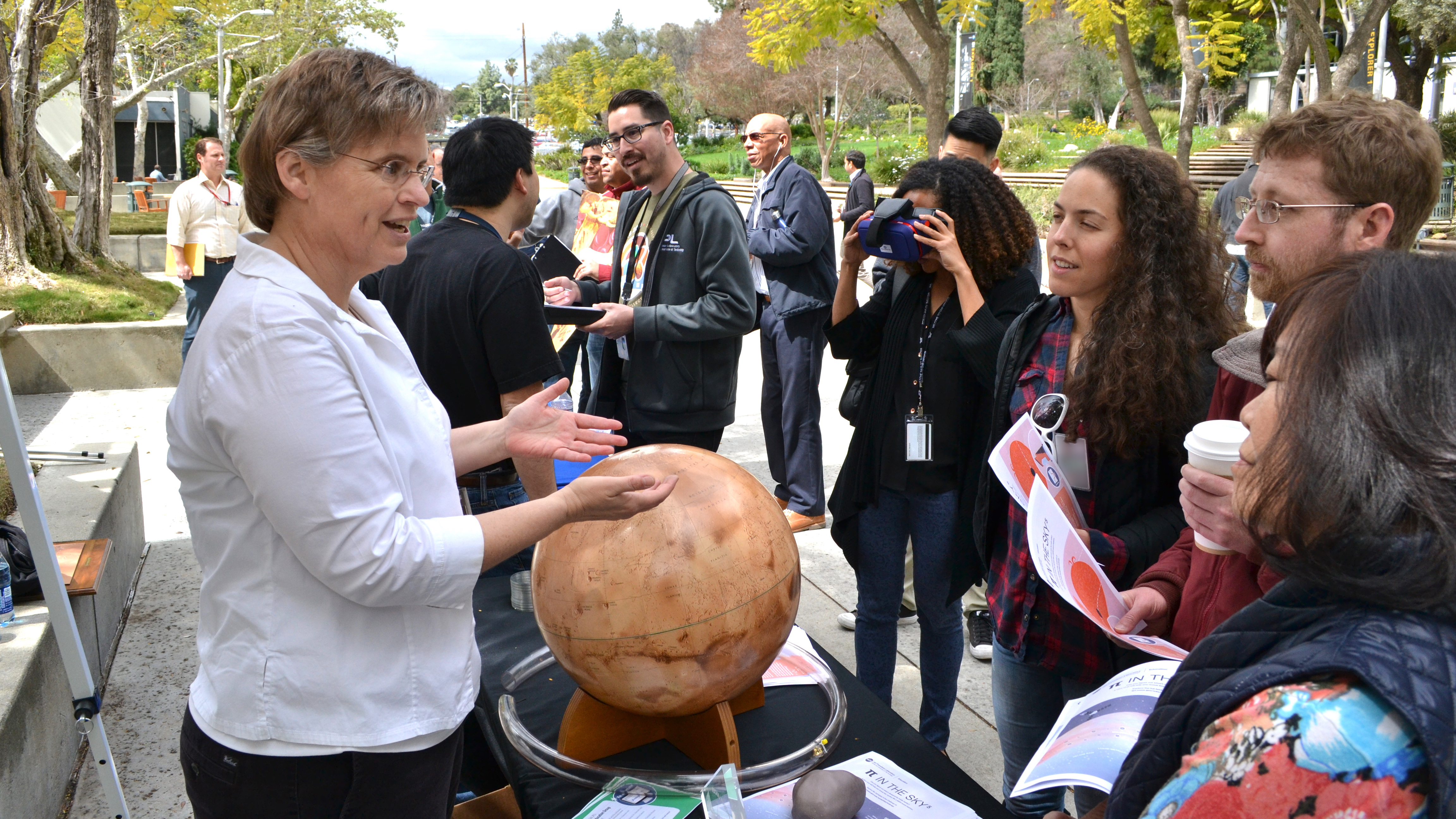
Ota Lutz, who leads the Laboratory's K-12 education team, speaks with a group of JPL employees during a Pi Day event. | + Expand image
Lutz grew up in a small town in Central California and says, "I was a smart kid, but these things called soft skills were beyond me, and I was the shyest kid in my class." That is until she joined her high school's service club. "Through volunteering, I ended up interacting with people from all walks of life and learned how to work with teams. My club advisor coached me, and I started taking on more leadership roles in the club and in class projects."
Later, it was that same club advisor and her youth pastor who encouraged Lutz to attend a college that would challenge her academically despite pressures to stay closer to home.
"You never know what experiences or conversations might open up opportunities for you," says Lutz, which is why she recommends that students get comfortable talking with peers and teachers – and especially asking questions. "It's really important to learn to ask questions so you build your confidence in learning and also develop relationships with people."
Launching into College
As Lutz experienced, those foundational skills can make all the difference when it comes to transitioning into college, too.
"When I got to college, I discovered I was woefully unprepared even though I had been at the top of my class in high school," says Lutz. "I never learned how to study, and I mistakenly believed that asking questions would make me look dumb. After struggling on my own for a couple of years, I learned that study groups existed and they helped me get to know my peers, build my confidence, and improve my GPA."
While building a support network is key, don't overload yourself the first year, Lutz says. But do start taking classes in the field you're interested in to see if it's the right fit. "The important thing is getting some experience in the field that you think you want to go into."
After that, internships, whether they're at JPL, NASA or elsewhere, will give you an even deeper look at what a future career might be like. When the time comes, you'll know exactly where to look to set yourself on the right trajectory – that is just above under "The World of JPL Internships" and "Skills for Space Explorers."
The laboratory’s STEM internship and fellowship programs are managed by the JPL Education Office. Extending the NASA Office of STEM Engagement’s reach, JPL Education seeks to create the next generation of scientists, engineers, technologists and space explorers by supporting educators and bringing the excitement of NASA missions and science to learners of all ages.
Career opportunities in STEM and beyond can be found online at jpl.jobs. Learn more about careers and life at JPL on LinkedIn and by following @nasajplcareers on Instagram.
TAGS: Internships, Students, Careers, Science, Computer Science, Engineering, Math, Programs, University Recruiting, Undergraduate, Graduate, College, High School, Mentors




